CalAmp Wireless Networks 2424096-001 T-96SR 900MHz Transceiver/Modem User Manual Cover
CalAmp Wireless Networks Corporation T-96SR 900MHz Transceiver/Modem Cover
Contents
- 1. Transceiver Manual
- 2. Modem Manual
Transceiver Manual

-1
April 1997
Part No. 001-3492-001
3492 Synthesized 900 MHz Transceiver
Service Manual
First Printing
June 1997
Part No. 001-3492-001 6-97mwp Printed in U.S.A.

-3
April 1997
Part No. 001-3492-001
3492 SYNTHESIZED 900 MHZ TRANSCEIVER
SERVICE MANUAL
Copyright 1997 by the Johnson Data Telemetry Corporation.
The Johnson Data Telemetry Corporation designs and manufactures radios and radio modems to serve a wide variety of data
communication needs. The Johnson Data Telemetry Corporation produces equipment for the fixed data market including
SCADA systems for utilities, petrochemical, waste and fresh water management markets and RF boards for OEM applications
in the Radio Frequency Data Capture market. In addition, the Johnson Data Telemetry Corporation provides wireless commu-
nication solutions to the mobile data market serving public safety, utilities and industrial users.
DATA TELEMETRY PRODUCT WARRANTY
The manufacturer's warranty statement for this product is available from your product supplier or from the Johnson Data
Telemetry Corporation, 299 Johnson Avenue, PO Box 1733, Waseca, MN 56093-0833. Phone (507) 835-8819.
WARNING
This device complies with Part 15 of the FCC rules. Operation is subject to the condition that this device does not cause harm-
ful interference. In addition, changes or modification to this equipment not expressly approved by the Johnson Data Teleme-
try Corporation could void the user's authority to operate this equipment (FCC rules, 47CFR Part 15.19).
DO NOT allow the antenna to come close to or touch, the eyes, face, or any exposed body parts while the radio is transmitting.
DO NOT operate the radio near electrical blasting caps or in an explosive atmosphere.
DO NOT operate the radio unless all the radio frequency connectors are secure and any open connectors are properly termi-
nated.
DO NOT allow children to operate transmitter equipped radio equipment.
SAFETY INFORMATION
Proper operation of this radio will result in user exposure below the Occupational Safety and Health Act and Federal Commu-
nication Commission limits.
The information in this document is subject to change without notice.
™ Johnson Data Telemetry is a trademark of the Johnson Data Telemetry Corporation.

1
TABLE OF CONTENTS
1GENERAL INFORMATION
1.1 SCOPE OF MANUAL . . . . . . . . . . . . . . . . . . . . . . . . . . . . . . . . . . . . . . . . . . . . . . . . . . . . . . . . . . . . . . . . . . . . . . . 1-1
1.2 EQUIPMENT DESCRIPTION. . . . . . . . . . . . . . . . . . . . . . . . . . . . . . . . . . . . . . . . . . . . . . . . . . . . . . . . . . . . . . . . 1-1
GENERAL . . . . . . . . . . . . . . . . . . . . . . . . . . . . . . . . . . . . . . . . . . . . . . . . . . . . . . . . . . . . . . . . . . . . . . . . . . . . . . . . . 1-1
DL3492 WITH LOADER BOARD . . . . . . . . . . . . . . . . . . . . . . . . . . . . . . . . . . . . . . . . . . . . . . . . . . . . . . . . . . . . . . 1-1
DL3492 WITH MODEM. . . . . . . . . . . . . . . . . . . . . . . . . . . . . . . . . . . . . . . . . . . . . . . . . . . . . . . . . . . . . . . . . . . . . . 1-2
DM3492 SYNTHESIZER PROGRAMMING . . . . . . . . . . . . . . . . . . . . . . . . . . . . . . . . . . . . . . . . . . . . . . . . . . . . . 1-2
1.3 TRANSCEIVER IDENTIFICATION . . . . . . . . . . . . . . . . . . . . . . . . . . . . . . . . . . . . . . . . . . . . . . . . . . . . . . . . . . 1-2
1.4 ACCESSORIES . . . . . . . . . . . . . . . . . . . . . . . . . . . . . . . . . . . . . . . . . . . . . . . . . . . . . . . . . . . . . . . . . . . . . . . . . . . . 1-2
1.5 PART NUMBER BREAKDOWN . . . . . . . . . . . . . . . . . . . . . . . . . . . . . . . . . . . . . . . . . . . . . . . . . . . . . . . . . . . . . 1-2
1.6 FACTORY CUSTOMER SERVICE . . . . . . . . . . . . . . . . . . . . . . . . . . . . . . . . . . . . . . . . . . . . . . . . . . . . . . . . . . . 1-3
1.7 PRODUCT WARRANTY . . . . . . . . . . . . . . . . . . . . . . . . . . . . . . . . . . . . . . . . . . . . . . . . . . . . . . . . . . . . . . . . . . . . 1-3
1.8 REPLACEMENT PARTS. . . . . . . . . . . . . . . . . . . . . . . . . . . . . . . . . . . . . . . . . . . . . . . . . . . . . . . . . . . . . . . . . . . . 1-3
1.9 FACTORY RETURNS . . . . . . . . . . . . . . . . . . . . . . . . . . . . . . . . . . . . . . . . . . . . . . . . . . . . . . . . . . . . . . . . . . . . . . 1-3
2INSTALLATION
2.1 PRE-INSTALLATION CHECKS . . . . . . . . . . . . . . . . . . . . . . . . . . . . . . . . . . . . . . . . . . . . . . . . . . . . . . . . . . . . . 2-1
2.2 INTERFACING WITH DATA EQUIPMENT . . . . . . . . . . . . . . . . . . . . . . . . . . . . . . . . . . . . . . . . . . . . . . . . . . . 2-1
DM3492 (RF Board) . . . . . . . . . . . . . . . . . . . . . . . . . . . . . . . . . . . . . . . . . . . . . . . . . . . . . . . . . . . . . . . . . . . . . . . . . 2-1
3PROGRAMMING
3.1 INTRODUCTION . . . . . . . . . . . . . . . . . . . . . . . . . . . . . . . . . . . . . . . . . . . . . . . . . . . . . . . . . . . . . . . . . . . . . . . . . . 3-1
3.2 DM3492 SYNTHESIZER DATA PROTOCOL . . . . . . . . . . . . . . . . . . . . . . . . . . . . . . . . . . . . . . . . . . . . . . . . . . 3-1
GENERAL . . . . . . . . . . . . . . . . . . . . . . . . . . . . . . . . . . . . . . . . . . . . . . . . . . . . . . . . . . . . . . . . . . . . . . . . . . . . . . . . . 3-1
SYNTHESIZER DATA . . . . . . . . . . . . . . . . . . . . . . . . . . . . . . . . . . . . . . . . . . . . . . . . . . . . . . . . . . . . . . . . . . . . . . . 3-1
D-WORD CALCULATION (24 BITS). . . . . . . . . . . . . . . . . . . . . . . . . . . . . . . . . . . . . . . . . . . . . . . . . . . . . . . . . . . 3-1
C-WORD CALCULATION (24 BITS) . . . . . . . . . . . . . . . . . . . . . . . . . . . . . . . . . . . . . . . . . . . . . . . . . . . . . . . . . . . 3-2
B-WORD CALCULATION (24 BITS) . . . . . . . . . . . . . . . . . . . . . . . . . . . . . . . . . . . . . . . . . . . . . . . . . . . . . . . . . . . 3-2
A0-WORD CALCULATION (24 BITS). . . . . . . . . . . . . . . . . . . . . . . . . . . . . . . . . . . . . . . . . . . . . . . . . . . . . . . . . . 3-2
TX / RX FREQUENCY SHIFT AND BAND SELECTION . . . . . . . . . . . . . . . . . . . . . . . . . . . . . . . . . . . . . . . . . . 3-3
RADIO DIAGNOSTICS . . . . . . . . . . . . . . . . . . . . . . . . . . . . . . . . . . . . . . . . . . . . . . . . . . . . . . . . . . . . . . . . . . . . . . 3-6
3.3 RECEIVE TO TRANSMIT SEQUENCE . . . . . . . . . . . . . . . . . . . . . . . . . . . . . . . . . . . . . . . . . . . . . . . . . . . . . . . 3-6
3.4 TRANSMIT TO RECEIVE SEQUENCE . . . . . . . . . . . . . . . . . . . . . . . . . . . . . . . . . . . . . . . . . . . . . . . . . . . . . . . 3-6
4CIRCUIT DESCRIPTION
4.1 GENERAL . . . . . . . . . . . . . . . . . . . . . . . . . . . . . . . . . . . . . . . . . . . . . . . . . . . . . . . . . . . . . . . . . . . . . . . . . . . . . . . . 4-1
INTRODUCTION . . . . . . . . . . . . . . . . . . . . . . . . . . . . . . . . . . . . . . . . . . . . . . . . . . . . . . . . . . . . . . . . . . . . . . . . . . . 4-1
SYNTHESIZER . . . . . . . . . . . . . . . . . . . . . . . . . . . . . . . . . . . . . . . . . . . . . . . . . . . . . . . . . . . . . . . . . . . . . . . . . . . . . 4-1
RECEIVER. . . . . . . . . . . . . . . . . . . . . . . . . . . . . . . . . . . . . . . . . . . . . . . . . . . . . . . . . . . . . . . . . . . . . . . . . . . . . . . . . 4-1
TRANSMITTER . . . . . . . . . . . . . . . . . . . . . . . . . . . . . . . . . . . . . . . . . . . . . . . . . . . . . . . . . . . . . . . . . . . . . . . . . . . . 4-1
4.2 SYNTHESIZER . . . . . . . . . . . . . . . . . . . . . . . . . . . . . . . . . . . . . . . . . . . . . . . . . . . . . . . . . . . . . . . . . . . . . . . . . . . . 4-1
VOLTAGE-CONTROLLED OSCILLATOR . . . . . . . . . . . . . . . . . . . . . . . . . . . . . . . . . . . . . . . . . . . . . . . . . . . . . . 4-3
VCO AND REFERENCE OSCILLATOR MODULATION . . . . . . . . . . . . . . . . . . . . . . . . . . . . . . . . . . . . . . . . . . 4-3
CASCADE AMPLIFIERS . . . . . . . . . . . . . . . . . . . . . . . . . . . . . . . . . . . . . . . . . . . . . . . . . . . . . . . . . . . . . . . . . . . . . 4-3
AMPLIFIER. . . . . . . . . . . . . . . . . . . . . . . . . . . . . . . . . . . . . . . . . . . . . . . . . . . . . . . . . . . . . . . . . . . . . . . . . . . . . . . . 4-3
VOLTAGE FILTER. . . . . . . . . . . . . . . . . . . . . . . . . . . . . . . . . . . . . . . . . . . . . . . . . . . . . . . . . . . . . . . . . . . . . . . . . . 4-3
VCO FREQUENCY SHIFT. . . . . . . . . . . . . . . . . . . . . . . . . . . . . . . . . . . . . . . . . . . . . . . . . . . . . . . . . . . . . . . . . . . . 4-4
SYNTHESIZER INTEGRATED CIRCUIT (U800) . . . . . . . . . . . . . . . . . . . . . . . . . . . . . . . . . . . . . . . . . . . . . . . . . 4-5
LOCK DETECT. . . . . . . . . . . . . . . . . . . . . . . . . . . . . . . . . . . . . . . . . . . . . . . . . . . . . . . . . . . . . . . . . . . . . . . . . . . . . 4-5

2
TABLE OF CONTENTS
4.3 RECEIVER CIRCUIT DESCRIPTION . . . . . . . . . . . . . . . . . . . . . . . . . . . . . . . . . . . . . . . . . . . . . . . . . . . . . . . . 4-5
CERAMIC FILTER, RF AMPLIFIER. . . . . . . . . . . . . . . . . . . . . . . . . . . . . . . . . . . . . . . . . . . . . . . . . . . . . . . . . . . 4-5
MIXER . . . . . . . . . . . . . . . . . . . . . . . . . . . . . . . . . . . . . . . . . . . . . . . . . . . . . . . . . . . . . . . . . . . . . . . . . . . . . . . . . . . 4-5
FIRST LO AMPLIFIER . . . . . . . . . . . . . . . . . . . . . . . . . . . . . . . . . . . . . . . . . . . . . . . . . . . . . . . . . . . . . . . . . . . . . . 4-5
CRYSTAL FILTER, FIRST IF SECTION . . . . . . . . . . . . . . . . . . . . . . . . . . . . . . . . . . . . . . . . . . . . . . . . . . . . . . . 4-6
SECOND LO/MIXER/DETECTOR . . . . . . . . . . . . . . . . . . . . . . . . . . . . . . . . . . . . . . . . . . . . . . . . . . . . . . . . . . . . 4-6
4.4 TRANSMITTER CIRCUIT DESCRIPTION . . . . . . . . . . . . . . . . . . . . . . . . . . . . . . . . . . . . . . . . . . . . . . . . . . . . 4-7
DRIVER . . . . . . . . . . . . . . . . . . . . . . . . . . . . . . . . . . . . . . . . . . . . . . . . . . . . . . . . . . . . . . . . . . . . . . . . . . . . . . . . . . 4-7
FINAL, COMPARATOR. . . . . . . . . . . . . . . . . . . . . . . . . . . . . . . . . . . . . . . . . . . . . . . . . . . . . . . . . . . . . . . . . . . . . 4-7
ANTENNA SWITCH. . . . . . . . . . . . . . . . . . . . . . . . . . . . . . . . . . . . . . . . . . . . . . . . . . . . . . . . . . . . . . . . . . . . . . . . 4-7
TRANSMIT KEY-UP CONTROL. . . . . . . . . . . . . . . . . . . . . . . . . . . . . . . . . . . . . . . . . . . . . . . . . . . . . . . . . . . . . . 4-7
4.5 VOLTAGE REGULATORS . . . . . . . . . . . . . . . . . . . . . . . . . . . . . . . . . . . . . . . . . . . . . . . . . . . . . . . . . . . . . . . . . . 4-8
+9.6 AND +5.5V REGULATED . . . . . . . . . . . . . . . . . . . . . . . . . . . . . . . . . . . . . . . . . . . . . . . . . . . . . . . . . . . . . . . 4-8
5SERVICING
5.1 GENERAL. . . . . . . . . . . . . . . . . . . . . . . . . . . . . . . . . . . . . . . . . . . . . . . . . . . . . . . . . . . . . . . . . . . . . . . . . . . . . . . . . 5-1
PERIODIC CHECKS . . . . . . . . . . . . . . . . . . . . . . . . . . . . . . . . . . . . . . . . . . . . . . . . . . . . . . . . . . . . . . . . . . . . . . . . 5-1
SURFACE-MOUNTED COMPONENTS . . . . . . . . . . . . . . . . . . . . . . . . . . . . . . . . . . . . . . . . . . . . . . . . . . . . . . . . 5-1
SCHEMATIC DIAGRAMS AND COMPONENT LAYOUTS . . . . . . . . . . . . . . . . . . . . . . . . . . . . . . . . . . . . . . . 5-1
REPLACEMENT PARTS LIST. . . . . . . . . . . . . . . . . . . . . . . . . . . . . . . . . . . . . . . . . . . . . . . . . . . . . . . . . . . . . . . . 5-1
TCXO MODULE NOT SERVICEABLE . . . . . . . . . . . . . . . . . . . . . . . . . . . . . . . . . . . . . . . . . . . . . . . . . . . . . . . . 5-1
5.2 SYNTHESIZER SERVICING . . . . . . . . . . . . . . . . . . . . . . . . . . . . . . . . . . . . . . . . . . . . . . . . . . . . . . . . . . . . . . . . 5-1
INTRODUCTION . . . . . . . . . . . . . . . . . . . . . . . . . . . . . . . . . . . . . . . . . . . . . . . . . . . . . . . . . . . . . . . . . . . . . . . . . . 5-1
REFERENCE OSCILLATOR . . . . . . . . . . . . . . . . . . . . . . . . . . . . . . . . . . . . . . . . . . . . . . . . . . . . . . . . . . . . . . . . . 5-1
VCO . . . . . . . . . . . . . . . . . . . . . . . . . . . . . . . . . . . . . . . . . . . . . . . . . . . . . . . . . . . . . . . . . . . . . . . . . . . . . . . . . . . . . 5-1
SYNTHESIZER (U800) . . . . . . . . . . . . . . . . . . . . . . . . . . . . . . . . . . . . . . . . . . . . . . . . . . . . . . . . . . . . . . . . . . . . . . 5-2
5.3 RECEIVER SERVICING . . . . . . . . . . . . . . . . . . . . . . . . . . . . . . . . . . . . . . . . . . . . . . . . . . . . . . . . . . . . . . . . . . . . 5-2
SUPPLY VOLTAGES AND CURRENT . . . . . . . . . . . . . . . . . . . . . . . . . . . . . . . . . . . . . . . . . . . . . . . . . . . . . . . . 5-2
MIXER/DETECTOR . . . . . . . . . . . . . . . . . . . . . . . . . . . . . . . . . . . . . . . . . . . . . . . . . . . . . . . . . . . . . . . . . . . . . . . . 5-2
SECOND LO . . . . . . . . . . . . . . . . . . . . . . . . . . . . . . . . . . . . . . . . . . . . . . . . . . . . . . . . . . . . . . . . . . . . . . . . . . . . . . 5-3
AUDIO BUFFER AMP . . . . . . . . . . . . . . . . . . . . . . . . . . . . . . . . . . . . . . . . . . . . . . . . . . . . . . . . . . . . . . . . . . . . . . 5-3
CRYSTAL FILTERS . . . . . . . . . . . . . . . . . . . . . . . . . . . . . . . . . . . . . . . . . . . . . . . . . . . . . . . . . . . . . . . . . . . . . . . . 5-3
MIXER . . . . . . . . . . . . . . . . . . . . . . . . . . . . . . . . . . . . . . . . . . . . . . . . . . . . . . . . . . . . . . . . . . . . . . . . . . . . . . . . . . . 5-3
LOW NOISE AMPLIFIER (LNA). . . . . . . . . . . . . . . . . . . . . . . . . . . . . . . . . . . . . . . . . . . . . . . . . . . . . . . . . . . . . . 5-3
ANTENNA SWITCH. . . . . . . . . . . . . . . . . . . . . . . . . . . . . . . . . . . . . . . . . . . . . . . . . . . . . . . . . . . . . . . . . . . . . . . . 5-3
5.4 TRANSMITTER SERVICING . . . . . . . . . . . . . . . . . . . . . . . . . . . . . . . . . . . . . . . . . . . . . . . . . . . . . . . . . . . . . . . . 5-3
SUPPLY VOLTAGES AND CURRENT . . . . . . . . . . . . . . . . . . . . . . . . . . . . . . . . . . . . . . . . . . . . . . . . . . . . . . . . 5-3
VCO . . . . . . . . . . . . . . . . . . . . . . . . . . . . . . . . . . . . . . . . . . . . . . . . . . . . . . . . . . . . . . . . . . . . . . . . . . . . . . . . . . . . . 5-3
FINAL AMPLIFIER. . . . . . . . . . . . . . . . . . . . . . . . . . . . . . . . . . . . . . . . . . . . . . . . . . . . . . . . . . . . . . . . . . . . . . . . . 5-3
ANTENNA SWITCH. . . . . . . . . . . . . . . . . . . . . . . . . . . . . . . . . . . . . . . . . . . . . . . . . . . . . . . . . . . . . . . . . . . . . . . . 5-3
MODULATION INPUT. . . . . . . . . . . . . . . . . . . . . . . . . . . . . . . . . . . . . . . . . . . . . . . . . . . . . . . . . . . . . . . . . . . . . . 5-4
TCXO . . . . . . . . . . . . . . . . . . . . . . . . . . . . . . . . . . . . . . . . . . . . . . . . . . . . . . . . . . . . . . . . . . . . . . . . . . . . . . . . . . . . 5-4

3
TABLE OF CONTENTS
6ALIGNMENT PROCEDURE
6.1 GENERAL . . . . . . . . . . . . . . . . . . . . . . . . . . . . . . . . . . . . . . . . . . . . . . . . . . . . . . . . . . . . . . . . . . . . . . . . . . . . . . . . 6-1
6.2 TEST EQUIPMENT . . . . . . . . . . . . . . . . . . . . . . . . . . . . . . . . . . . . . . . . . . . . . . . . . . . . . . . . . . . . . . . . . . . . . . . . 6-1
6.3 INITIAL SETTINGS . . . . . . . . . . . . . . . . . . . . . . . . . . . . . . . . . . . . . . . . . . . . . . . . . . . . . . . . . . . . . . . . . . . . . . . . 6-1
6.4 VCO CONTROL VOLTAGE. . . . . . . . . . . . . . . . . . . . . . . . . . . . . . . . . . . . . . . . . . . . . . . . . . . . . . . . . . . . . . . . . 6-1
6.5 TRANSMITTER AND FREQUENCY . . . . . . . . . . . . . . . . . . . . . . . . . . . . . . . . . . . . . . . . . . . . . . . . . . . . . . . . . 6-1
MODULATION ALIGNMENT . . . . . . . . . . . . . . . . . . . . . . . . . . . . . . . . . . . . . . . . . . . . . . . . . . . . . . . . . . . . . . . . 6-2
6.6 TRANSMITTER/FREQUENCY WITH LOADER . . . . . . . . . . . . . . . . . . . . . . . . . . . . . . . . . . . . . . . . . . . . . . . 6-2
MODULATION ADJUSTMENT . . . . . . . . . . . . . . . . . . . . . . . . . . . . . . . . . . . . . . . . . . . . . . . . . . . . . . . . . . . . . . . 6-3
6.7 RECEIVER. . . . . . . . . . . . . . . . . . . . . . . . . . . . . . . . . . . . . . . . . . . . . . . . . . . . . . . . . . . . . . . . . . . . . . . . . . . . . . . . 6-3
7PARTS LIST
8SCHEMATICS AND COMPONENT LAYOUTS

1-1
June 1997
Part No. 001-3492-001
SECTION 1 GENERAL INFORMATION
1.1 SCOPE OF MANUAL
This service manual contains alignment and ser-
vice information for the JDT DM3492 900 MHz Syn-
thesized Telemetry Unit.
This manual concentrates on the RF section of
the data link which may be paired with an internal
Loader board or 9600 baud Modem board.
Service manuals addressing items specific to the
Loader board (001-3240-001) and the Modem board
(001-3276-001) should be referenced for the users
specific configuration.
1.2 EQUIPMENT DESCRIPTION
1.2.1 GENERAL
The JDT DM3492 is a synthesized data trans-
ceiver (transmitter and receiver) which operates in the
928-960 MHz UHF frequency range. Transmitter
power output is 1-5 watts, 5W at 13.3V nominal, and
operation is simplex or half duplex.
In addition to this 900 MHz radio, JDT has a full
line of radios and radio modems to meet wireless data
communication needs. Both OEM RF decks and com-
plete FCC type approved radios and radio modems are
available from 132-174 MHz at VHF, 380-512 MHz
at UHF and 928-960 MHz at 900 MHz in both 5W and
2W units (VHF and UHF). High Specification units
are available to meet International requirements and
bandwidths to meet U.S.A. refarming requirements.
To learn more about the other JDT products, call 1-
800-992-7774 or 1-612-890-8155 to speak to a sales
representative.
1.2.2 DL3492 WITH LOADER BOARD
The DL3492 (Part No. 242-3492-5x0) includes
the 8-channel Loader Board (Part No. 023-3240-001),
which performs synthesizer loading through an
RS-232 DB-9 interface. The Loader Board has cir-
cuitry which provides electronic control of the
following:
lTransmit/Receive data conditioning and gating
lCarrier Detect
lPower Control
lPreselector Tracking
lModulation Flatness
lAudio/Data Filtering
lSleep/Wake-up to minimize current consumption
lDiagnostics that include:
Input Voltage Sense
Input Current Sense
Ambient Temperature Sense
RSSI Indicator (RSSI Sense)
Forward/Reverse Power Sense.
The gating circuits allow the type of data filtering
to be selected (standard or wide band) and also pre-
emphasis/de-emphasis to be enabled or disabled.
This board is programmed using an IBM PC or
compatible computer and the Johnson Data Telemetry
programming software. Programming information is
stored by an EEPROM on the Loader board. Refer to
Section 3.3 for programming information.
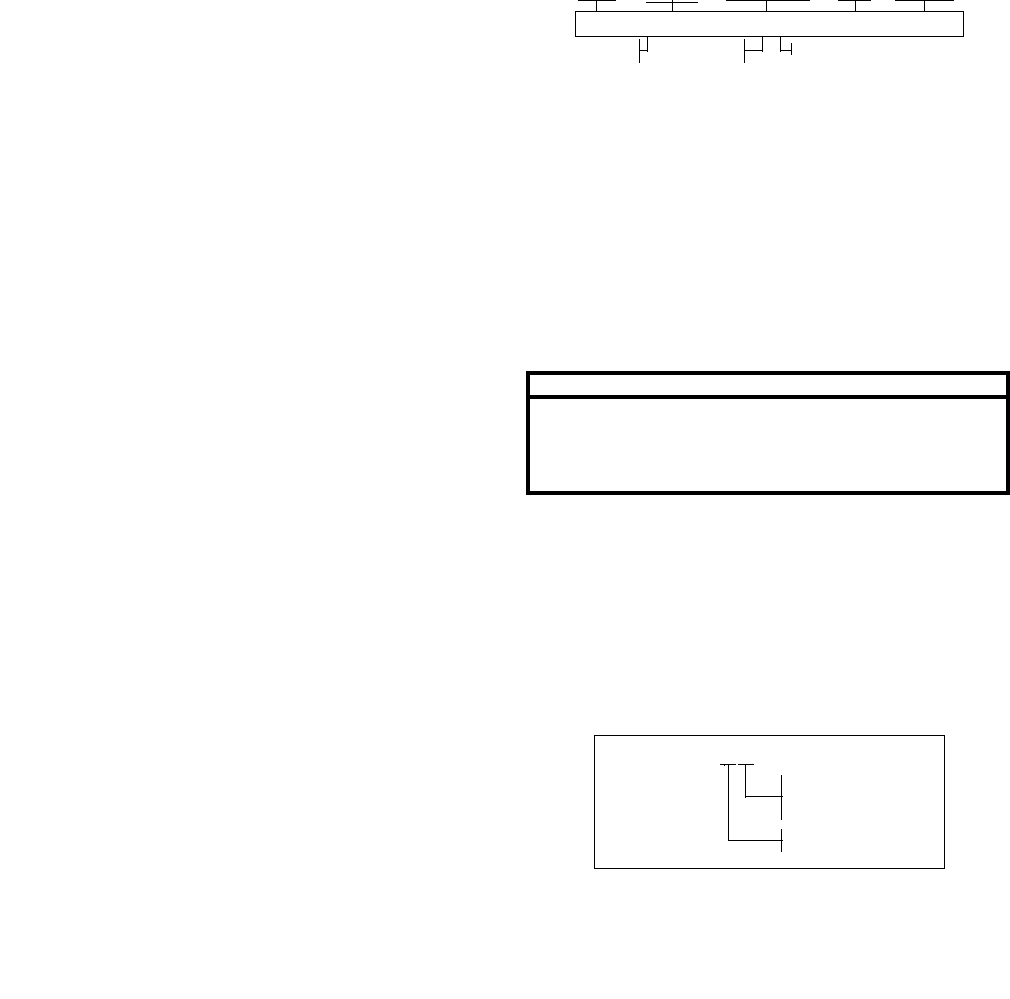
GENERAL INFORMATION
1-2
June 1997
Part No. 001-3492-001
NOTE: The synthesizer must be loaded each time pow-
er is turned on. Therefore, one loader board or cus-
tomer supplied programming circuit is required for
each data transceiver.
1.2.3 DL3492 WITH MODEM
The DL3492 (Part No. 242-3492-5x0) includes
the 9600 baud Modem (Part No. 023-3276-001),
which supports the RNET™ communication proto-
col, allowing data communication between the
Johnson Data Telemetry high specification synthe-
sized products and the Motorola RNET radio/
modems.
The Modem features include:
lUser Programmable Data Rates; 9600, 4800, 2400
and 1200 baud in a 25 kHz bandwidth.
lRS-232 compatible.
lSimplex or Half-Duplex operation.
lRTS-CTS handshaking protocol with option for
configuring any two units as a digital repeater.
lSupports asynchronous, serial or transparent data
formats.
lFront panel LEDs provide indication for Transmit,
Receive and Power.
lBuilt-In Diagnostics reported both locally and
"Over-The-Air":
Reports specific unit programming
Loopback test feature
RSSI
Forward and Reflected Power
Temperature
Supply Voltage
l8-Channels programmable with option to switch
channels remotely "Over-The-Air".
This board is programmed using an IBM PC or
compatible computer and the RSS programming soft-
ware. The 3276 Modem Programming Kit (Part No.
023-3276-005) includes programming instructions
contained in the RSS Manual.
1.2.4 DM3492 SYNTHESIZER PROGRAMMING
The DM3492, when used without the Universal
Loader Board (Part No. 023-3240-001) requires cus-
tomer supplied circuitry to load the synthesizer with
channel information. The protocol that this circuitry
must follow is described in Section 3.
1.3 TRANSCEIVER IDENTIFICATION
The transceiver identification number is printed
on a label that is affixed to the PC board. The follow-
ing information is contained in that number:
1.4 ACCESSORIES
Accessories available for the 3492 data trans-
ceiver are listed in Table 1-1.
1.5 PART NUMBER BREAKDOWN
The following is a breakdown of the part number
used to identify this transceiver:
Table 1-1 ACCESSORIES
Accessory Part No.
3276 Service Manual 001-3276-001
3240 Service Manual 001-3240-001
Interface cable 023-3472-007
3492 2A1 4 3 A12345
Model Revision
Letter
Ninth Digit
of PN
Manufacture
Date
Week No.
of Year Year
Plant Warranty
Number
242-3492 - 5 X 0
1 = 12.5 kHz BW
5 = 928-960 MHz
3 = 25 kHz BW

GENERAL INFORMATION
1-3
June 1997
Part No. 001-3492-001
1.6 FACTORY CUSTOMER SERVICE
The Customer Service Department of the
Johnson Data Telemetry Corporation provides cus-
tomer assistance on technical problems and the avail-
ability of local and factory repair facilities. Customer
Service hours are 7:30 a.m. - 4:30 p.m. Central Time,
Monday - Friday. There is also a 24-hour emergency
technical support telephone number. From within the
continental United States, the Customer Service
Department can be reached at this toll-free number
1-800-992-7774
When your call is answered at the Johnson Data
Telemetry Corporation, you will hear a brief message
informing you of numbers that can be entered to reach
various departments. This number may be entered
during or after the message using a tone-type tele-
phone. If you have a pulse-type telephone, wait until
the message is finished and an operator will come on
the line to assist you. When you enter a first number
of "3", another number is requested to further catego-
rize the type of information you need. You may also
enter the 4-digit extension number of the person that
you want to reach if you know what it is.
FAX Machine - Sales (507) 835-6485
FAX Machine - Cust Serv (507) 835-6969
If you are calling from outside the continental
United States, the Customer Service telephone num-
bers are as follows:
Customer Service Department - (507) 835-6911
Customer Service FAX Machine - (507) 835-6969
You may also contact the Customer Service
Department by mail. Please include all information
that may be helpful in solving your problem. The
mailing address is as follows:
Johnson Data Telemetry Corporation
Customer Service Department
299 Johnson Avenue
P.O. Box 1733
Waseca, MN 56093-0833
1.7 PRODUCT WARRANTY
The warranty statement for this transceiver is
available from your product supplier or from the War-
ranty Department, Johnson Data Telemetry Corpora-
tion, 299 Johnson Avenue, PO Box 1733, Waseca,
MN 56093-0833. This information may also be
requested by phone from the Warranty Department.
The Warranty Department may also be contacted for
Warranty Service Reports, claim forms, or any ques-
tions concerning warranties or warranty service by
dialing (507) 835-6970.
1.8 REPLACEMENT PARTS
Replacement parts can be ordered directly from
the Service Parts Department. To order parts by
phone, dial the toll-free number and then enter "3" as
described in Section 1.6. When ordering, please sup-
ply the part number and quantity of each part ordered.
Johnson Data Telemetry dealers also need to give their
account number.
If there is uncertainty about the part number,
include the designator (C112, for example) and the
model number of the equipment the part is from (refer
to Section 1.3).
You may also send your order by mail or FAX.
The mailing address is as follows and the FAX num-
ber is shown in Section 1.6.
Johnson Data Telemetry Corporation
Service Parts Department
299 Johnson Avenue
PO Box 1733
Waseca, MN 56093-0833
1.9 FACTORY RETURNS
Repair service is normally available through local
authorized Johnson Data Telemetry Land Mobile
Radio Service Centers. If local service is not avail-
able, the equipment can be returned to the factory for
repair. However, it is recommended that you contact
the Field Service Department before returning equip-
ment. A service representative may be able to suggest
a solution to the problem so that return of the equip-
ment would not be necessary. If using the toll-free
number in the preceding section, enter "3".

GENERAL INFORMATION
1-4
June 1997
Part No. 001-3492-001
Be sure to fill out a Factory Repair Request Form
#271 for each unit to be repaired, whether it is in or
out of warranty. These forms are available free of
charge by calling the repair lab (see Section 1.6) or by
requesting them when you send a unit in for repair.
Clearly describe the difficulty experienced in the
space provided and also note any prior physical dam-
age to the equipment. Include a form in the shipping
container with each unit. Your phone number and
contact name are very important because there are
times when the technicians have specific questions
that need to be answered in order to completely iden-
tify and repair a problem.
When returning equipment for repair, it is also a
good idea to use a PO number or some other reference
number on your paperwork in case you need to call
the repair lab about your unit. These numbers are ref-
erenced on the repair order to make it easier and faster
to locate your unit in the lab.
Return Authorization (RA) numbers are not nec-
essary unless you have been given one by the Field
Service Department. They require RA numbers for
exchange units or if they want to be aware of a spe-
cific problem. If you have been given an RA number,
reference this number on the Factory Repair Request
Form sent with the unit. The repair lab will then con-
tact the Field Service Department when the unit
arrives.

GENERAL INFORMATION
1-5
June 1997
Part No. 001-3492-001
3492 UHF SYNTHESIZED TELEMETRY UNIT SPECIFICATIONS
The following are general specifications intended for use in testing and servicing this transceiver. For current ad-
vertised specifications, refer to the specification sheet available from the Marketing Department. Specifications are
subject to change without notice.
GENERAL
Frequency Range 928-960 MHz
Frequency Control Synthesized
Channel Spacing 12.5/25 kHz with 6.25 kHz Channel steps
Mode of Operation Simplex or Half Duplex
Operating Voltage +13.3V DC nominal (10-16V DC operational)
Regulated Supply Voltages +5V DC ±5%
Transmit Enable 3-16V DC at 400 µA max
Receive Current 70 mA maximum
Transceiver Enable 3-16V DC at less than 400 µA
Power and Data Connector 14-pin in-line socket (Dupont 76308-14)
RF Input/Output SMA Jack (female)
Operating Temperature -30°C to +60°C (-22°F to +140°F)
Storage Temperature -40°C to +85°C (-40°F to +185°F)
Humidity 95% maximum RH at 40°C, non-condensing
Maximum Dimensions 4.585" L, 3.25" W, 2.2" H
FCC Compliance Parts 90, 94, 15
DM3492 Customer must apply
RECEIVER
Bandwidth 32 MHz
Frequency Stability ±1.5 PPM from -30°C to +60°C (-22°F to +140°F)
Sensitivity - 12 dB SINAD ≤ 0.35 µV, -116 dBm psophometrically weighted
RF Input Impedance 50 ohms
Selectivity 65 dB 25 kHz, 60 dB 12.5 kHz
Spurious and Image Rejection 70 dB
Conducted Spurious Emissions < -57 dBm
Intermodulation 70 dB
FM Hum and Noise -40 dB, 25 kHz channels, -35 dB, 12.5 kHz channels
Receive Attack Time < 5 ms
Total Receive On Time 7 ms maximum
Audio
Distortion < 3% psophometrically weighted
Response ±1/-3 dB 0 to 2.5 kHz for 12.5 kHz Channel, 0 to 5 kHz for 25 kHz Channel
Output Bias 2.5V DC ±0.5V DC
Buffered Impedance >10k ohms
Buffered Audio Level 150 mV ±50 mV
RSSI 0.7V to 2.0V DC output from -120 to -60 dBm

GENERAL INFORMATION
1-6
June 1997
Part No. 001-3492-001
TRANSMITTER
Frequency Stability ±1.5 PPM from -30°C to +60°C (-22°F to +140°F)
Bandwidth 32 MHz
Maximum System Deviation 5 kHz (25 kHz Channel), 2.5 kHz (12.5 kHz Channel)
Frequency Spread 32 MHz
Modulation FM/DC coupled
Wideband Data Input Bias 2.5V DC ±1%
Narrow Band Input AC coupled
Input Impedance >50k ohms
Audio Distortion < 3% at 3 kHz deviation, 1 kHz tone
(with user interface board narrow band data port
Audio Response ±2 dB, DC to 5 kHz dev with a 1 kHz tone Programmable to ± dB using DAC
Flatness ±1 dB across 32 MHz bandwidth
RF Power Output 1-5W ±20% adjustable (5W at 13.3V DC nominal)
Deviation Symmetry 5%
RF Output Impedance 50 ohms
Duty Cycle 50% (30 sec. max transmit)
Transmitter Adjacent Power -70 dB
Intermodulation Attenuation -40 dB
Spurious and Harmonic FM -20 dBm max.
FM Hum and Noise -40 dB 25 kHz, -35 dB 12.5 kHz

2-1
June 1997
Part No. 001-3492-001
SECTION 2 INSTALLATION
2.1 PRE-INSTALLATION CHECKS
Field alignment should not be required before the
3492 is installed. However, it is still good practice to
check the performance to ensure that no damage
occurred during shipment. Performance tests are
located in Section 6.2.
2.2 INTERFACING WITH DATA EQUIPMENT
2.2.1 DM3492 (RF Board)
Connector J201 on the data transceiver PC board
provides the interface with the data equipment. This is
a 14-pin female connector with .025" square pins on
0.1" centers (Dupont 76308-114). The cable (Part No.
023-3472-007) is not included with the data trans-
ceiver. An interface cable diagram and pin designa-
tions are shown in Figure 2-1.
The following is a general description of the
input and output signals on Transceiver Interface con-
nector J201.
Pin 1 (Ground) - Chassis ground.
Pin 2 (+13.3V DC) - Input, transceiver main power.
Input range 10-16V DC with ±3 dB variation in output
power.
Pin 3 (Tx En) - Input +3-16V DC. Enables transmit
circuitry. ≤ 0.3V DC in Rx mode.
Pin 4 (Rx En) - Input +3-16V DC. Enables receive cir-
cuitry. ≤ 0.3 V DC in Tx mode.
Pin 5 (RF En) - Input +3-16V DC. Shuts down on-
board regulators. To be used as a power save mode.
Pin 6 (Mod In) - Provides a response of ±2 dB from
DC to 5 kHz across the RF band (referenced to
1 kHz). It is programmable to 1 dB with the diagnostic
DAC. The modulation capability is 250 mV RMS
±3 dB that produces ±5 kHz deviation with a 1 kHz
tone. When this input is used, a temperature compen-
sated 2.5V DC bias is required as variations in voltage
cause the frequency to change. The transceiver regula-
tory compliance must be applied for with the customer
supplied modulation limiting/filter circuit and chassis.
Pin 7 (Synth Lock) - Output from synthesizer lock de-
tect circuit. Low (< 1V DC) = unlocked, high (>2.5V
DC) = locked.
Pin 8 (Synth En) - TTL input. Latch enable signal for
synthesizer. 250 ns min. for D, C and B words; 3 ms
min. for A0 word. A rising edge latches the data loaded
into the synthesizer IC..
Pin 9 (Data) - TTL input. Serial data line used for pro-
gramming the synthesizer and diagnostic functions.
Pin 10 (Synth Clock) - TTL input. Clock signal for se-
rial data input on Pin 9. Data is valid on the rising edge.
1 MHz max. frequency.
Pin 11 (Diag En) - TTL input. Loads programmed
DAC values into DAC (U900) for modulation adjust
and power set. Also provides the strobe signal for shift
register (u901) for selecting Forward and Reverse pow-
er diagnostics. 250 ns min. activates on rising edge.
Pin 12 (RSSI) - Analog output (0.5-2V DC). The Re-
ceive Signal Strength Indicator output provides a volt-
age that increases in proportion to the strength of the
RF input signal.
Pin 13 (Demod) - Analog output. The Receiver De-
mod output level is 150 mV RMS with a modulation
signal of 1 kHz at 60% of maximum deviation. The out-
put is DC coupled and referenced to +2.5V DC. Load
impedance should be >10k ohms.
Pin 14 (Diag) - Analog Output. This pin is enabled by
pin 11. When the Loader board is used it has the capa-
bility to test the operating environment through diag-
nostics. The diagnostic capabilities are in Section 1.2.2
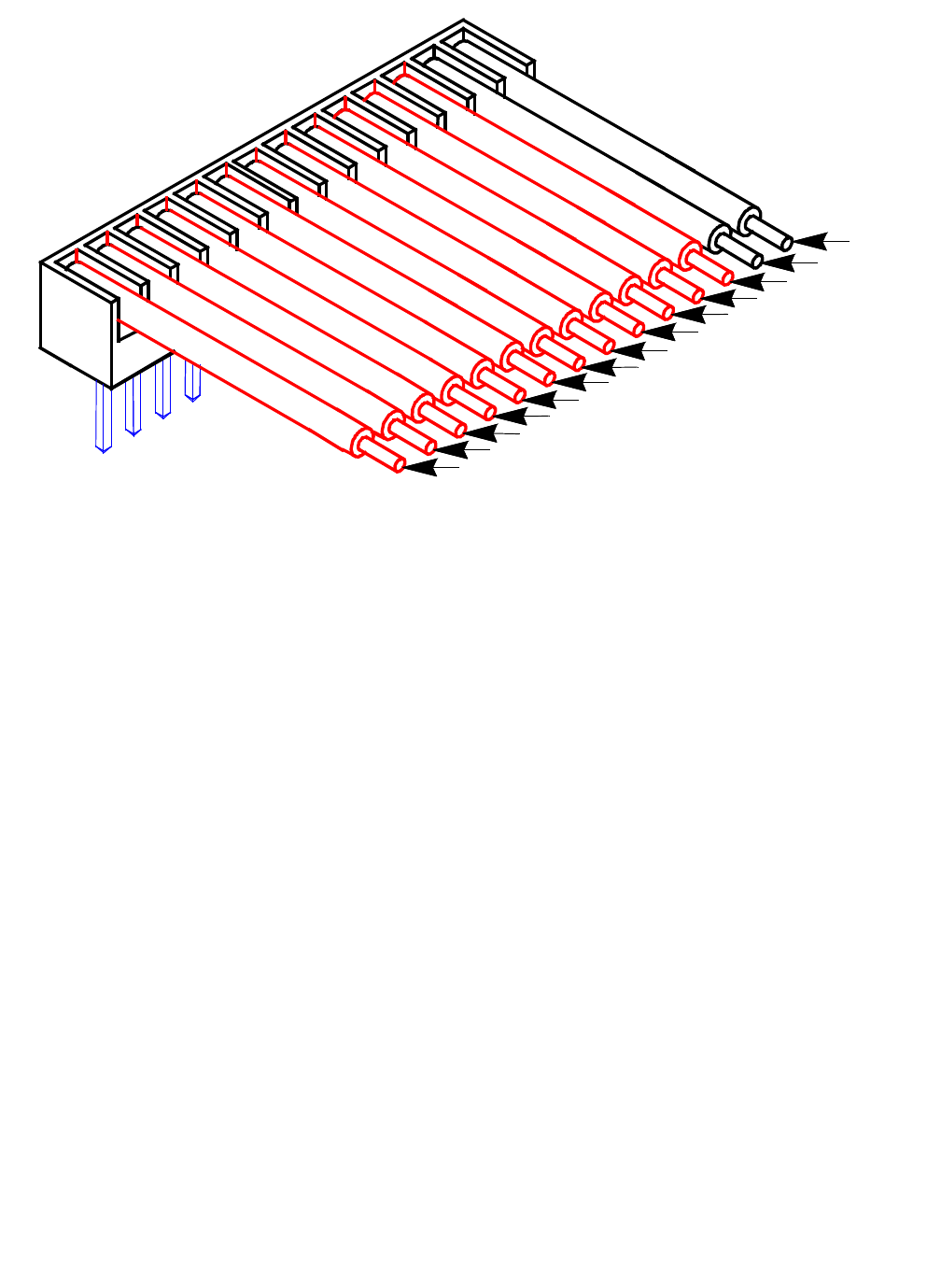
INSTALLATION
2-2
June 1997
Part No. 001-3492-001
Figure 2-1 DM3492 INTERFACE CABLE
14 13 12 11 10 9
1
2
3
4
5
6
7
8
RSSI
DATA
SYNTH EN
SYNTH LOCK
GROUND
DEMOD
MOD IN
TX EN
RF EN
SYNTH CLOCK (1.3 MHz)
DIAG
DIAG EN
RX EN
+13.3V DC
PART NO. 023-3472-007
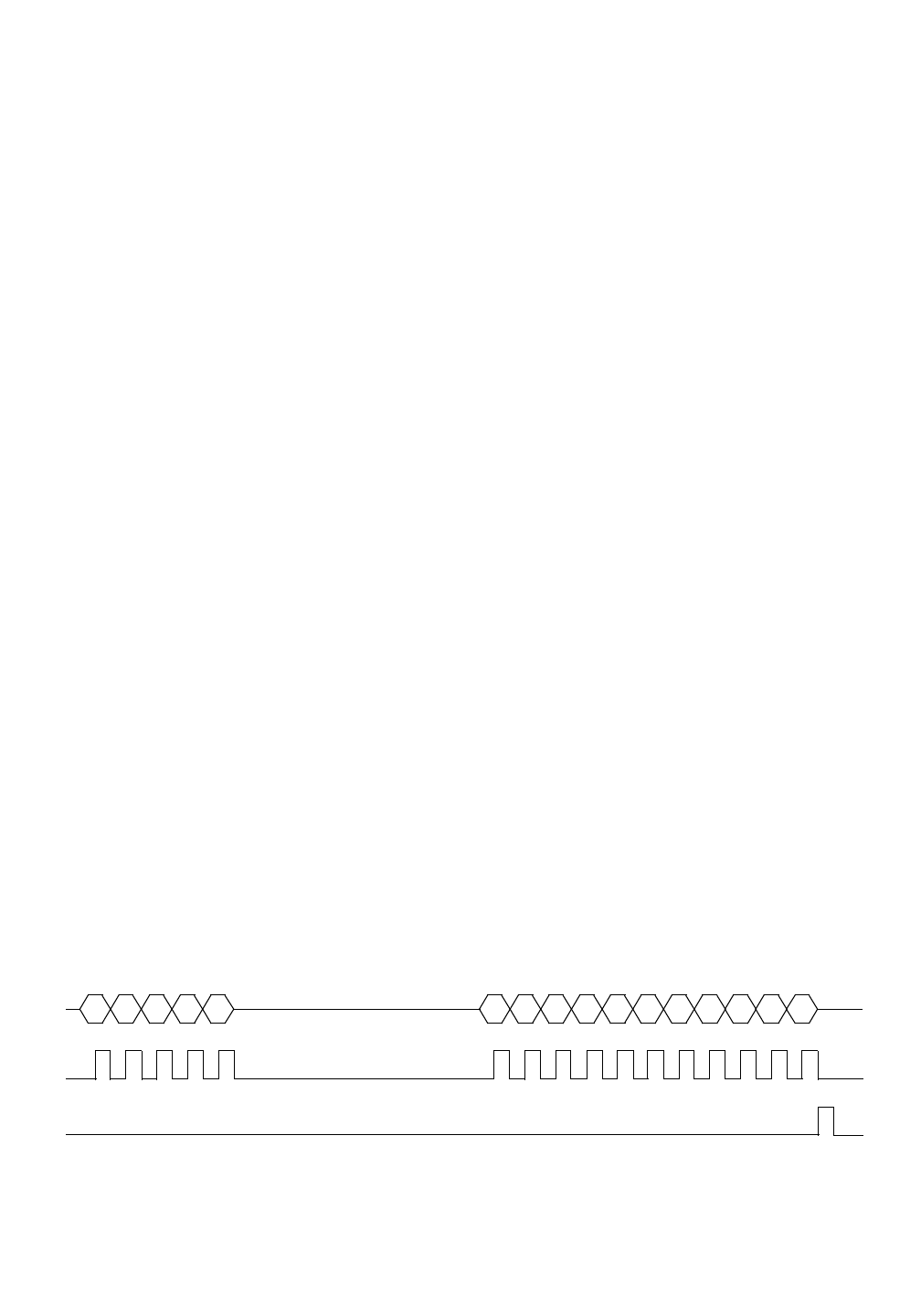
3-1
June 1997
Part No. 001-3492-001
SECTION 3 PROGRAMMING
3.1 INTRODUCTION
DM3492 - The information in Section 3.2
describes synthesizer programming protocol. This
information can be used as a basis for designing the
synthesizer programming hardware and software
required.
3.2 DM3492 SYNTHESIZER DATA PROTOCOL
3.2.1 GENERAL
The 928-960 MHz band is divided into two seg-
ments for the purpose of reducing VCO gain. The
"LOW" band covers the 928-944 MHz segment and
the "HIGH" band covers the 944-960 MHz segment.
The VCO band selection is accomplished by capaci-
tive pin-switching. The band switching is imple-
mented in both the transmit and receive modes. The
front-end filters and transmitter line-up cover the
entire 928-960 MHz band without adjustment.
Receive Bandwidth 928-960 MHz
Transmit Bandwidth 928-960 MHz
First IF 87.850 MHz
Second IF 450.0 kHz
First LO Injection 840.150-872.150 MHz*
Second LO Injection 87.40 MHz*
TCXO Frequency 17.50 MHz
Resolution 6.25 kHz
Loop Comparison Freq. 50 kHz
* Low Side Injection
A diagram of the 32 Bit Synthesizer Serial Data
Stream with definitions of the bits is shown in Figure
3-1.
Clock 1 MHz (max)
Synth Enable 250 ns (min) (for D, C and B words
approximately 3 ms for A0 word)
D00-D23 D, C, B and A0 words
3.2.2 SYNTHESIZER DATA
In order to implement the band selection and
Tx/Rx frequency shift mentioned in Section 3.2.1, an
additional shift register was added to the synthesizer
section. Therefore, an additional 8 Bits of data are
added to each of the synthesizer load words (D/C/B/
A0) as shown in the serial data stream in Figure 3-1.
3.2.3 D-WORD CALCULATION (24 BITS)
The D-Word programs the Main, Reference and
Auxiliary dividers, and sets the modulus (refer to
Figures 3-2 and 3-6).
NR = 350 Ftcxo/50 kHz=350
where Ftcxo=17.5 MHz
SM = 00 Reference select for main phase detector
EM = 1 Main divider enable flag
SA = 00 Reference select for aux phase detector
EA = 1 Auxiliary divider enable flag
FMOD = 1 Selects modulus 8
LONG = 0 Send all 4 words with A0
D Word = 0xA1 0x5E 0x26
Figure 3-1 32-BIT SYNTHESIZER SERIAL DATA STREAM
D1 D0 XXXX
XX XX
LSB (00)
Data
Clock
Synth En
MSB (31)
D23 D22 D21 D20 - - Tx-Tx+Low-
Low+

PROGRAMMING
3-2
June 1997
Part No. 001-3492-001
3.2.4 C-WORD CALCULATION (24 BITS)
The C-Word enables the auxiliary prescaler, and
sets the auxiliary divide ratio for the secondary (Sec-
ond LO) loop (refer to Figures 3-4 and 3-7).
PA = 0 Sets aux prescaler mode to ÷ 4
NA = 437 (0x1B5) Auxiliary divide ratio
87.4 MHz ÷ (4 x 437) = 50 kHz
C-Word = 0x91 0xB5 0x00
3.2.5 B-WORD CALCULATION (24 BITS)
The B-Word programs the Fractional-N charge
pump current setting factor. The Binary acceleration
factors (CL/CK) and prescaler type (modulus 3).
The value of CN should be interpolated for fre-
quencies between the band edges. With these recom-
mended values of CN, the transceiver should have the
fractional spurs minimized far below the levels needed
to make 70 dB adjacent channel Rx or Tx specifica-
tions.
The Charge Pump Current setting (CN) could be
changed on a channel-by-channel basis for ultimate
rejection of the Fraction N spurious responses close
into the carrier frequency. the 3492 synthesizer has an
adjust (R823) for the fractional compensation cur-
rent. The factory preset value will allow CN to be set
to the following ranges:
(Refer to Figures 3-3 and 3-7)
Frequency in a Band CN
Lowest Tx 110
Highest Tx 115
Lowest Rx 100
Highest Rx 105
CN = * (Channel/Frequency dependent variable)
(110-115 Tx) (100-105 Rx)
CK = 0000 Binary acceleration factor for integral
charge pump
CL = 00 Binary acceleration factor for
proportional charge pump
PR = 10 Selects modulus 3 prescaler
B-Word = 0x80 (8 bit CN) 0x02
3.2.6 A0-WORD CALCULATION (24 BITS)
The A0-Word is sent last (see Figure 3-5). The
A0-Word contains the data for the loop dividers and is
programmed on a channel-by-channel basis. The
Functional-N (NF) word is a 3 bit word that programs
the synthesizer to the fractional steps determined by
the fractional modulus selection flag (1 = modulus 8)
and the loop comparison frequency (50 kHz). The fre-
quency resolution (i.e. step size) is then 50 kHz ÷ 8 =
6.25 kHz.
NF=* Fractional increment for modulus 8 (3 bits)
NM1=* Number of main divider cycles when
prescaler modulus equals 64 (12 bits)
NM2=* Number of main divider cycles when
prescaler modulus equals 65 (4 bits, PR=10)
NM3=* Number of main divider cycles when
prescaler modulus equals 72 (4 bits, PR=10)
* Indicates frequency/channel dependant variable.
EXAMPLE: To program an 18.75 kHz channel:
NF = 18.75 kHz ÷ 6.25 kHz
NF = 3
NM1, NM2 and NM3 are calculated as follows:
N = (NM1 + 2) x 64 + NM2 x 65 + (NM3 +1) x 72
Where:
N = Total division ratio
NM1 = Number of main divider cycles when
prescaler modulus equals 64
NM2 = Number of main divider cycles when
prescaler modulus equals 65
NM3 = Number of main divider cycles when
prescaler modulus equals 72
Example:
Calculate NM1, NM2 and NM3 to Rx 944.150 MHz
Rx LO = 944.15 - 87.85 = 856.3 MHz (Synth Freq)
(87.85 MHz IF with Low Side Injection)
N = Rx LO ÷ FCM = 856.3 ÷ 0.05 = 17126
(FCM = Loop Reference Frequency)
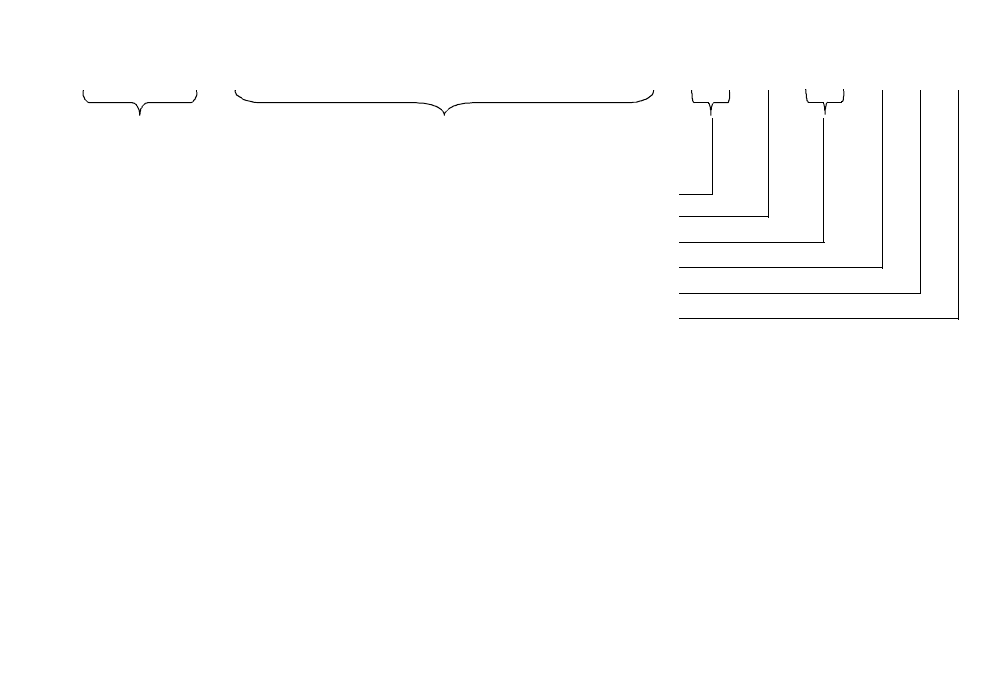
PROGRAMMING
3-3
June 1997
Part No. 001-3492-001
NM3 = (INT(64 x FRAC [N ÷ 64]) ÷ 8) - 1
= (INT(64 x 0.59375) ÷ 8) - 1
= (INT(38 ÷ 8)) - 1
= 4 - 1
= 3
NM2 = 8 x FRAC [N ÷ 8]
= 8 x 0.75
= 6
NM1 = INTEGER [N ÷ 64] - NM2 - NM3 - 3
= 267 - 6 - 3 - 3
= 255
3.2.7 TX / RX FREQUENCY SHIFT AND BAND
SELECTION
As mentioned in 3.2.2, in order to implement the
band selection and Rx/Rx an additional 8 bits of data
are added to each of the synthesizer load words (D/C/
B/AO) (see Figure 3-1). The frequency bands and
Transmit/Receive Bits are defined as follows:
Low Band 928-944 MHz
High Band >944 MHz to 960 MHz
xx Don’t care
Low+ Low Band Select (1=lowband, 0=highband)
Low- Low Band Select (0=lowband, 1=highband)
Tx+ Transmit Select (1=Tx mode, 0=Rx mode)
Tx- Transmit Select (0=Tx mode, 1=Rx mode)
Figure 3-2 D-WORD
4
321 141312111098765 2019181715 16 24232221
1 1 1 1 1 1 1 1 00/110000000000000
ADDRESS
BITS
= 350 FOR 50 kHz REFERENCE
EA (ALWAYS 1)
FMOD (1 = MODULUS 8)
SA (ALWAYS 00)
EM (ALWAYS 1)
SM (ALWAYS 00)
LONG (0=24 BIT WORD)
NR (REFERENCE DIVIDE)
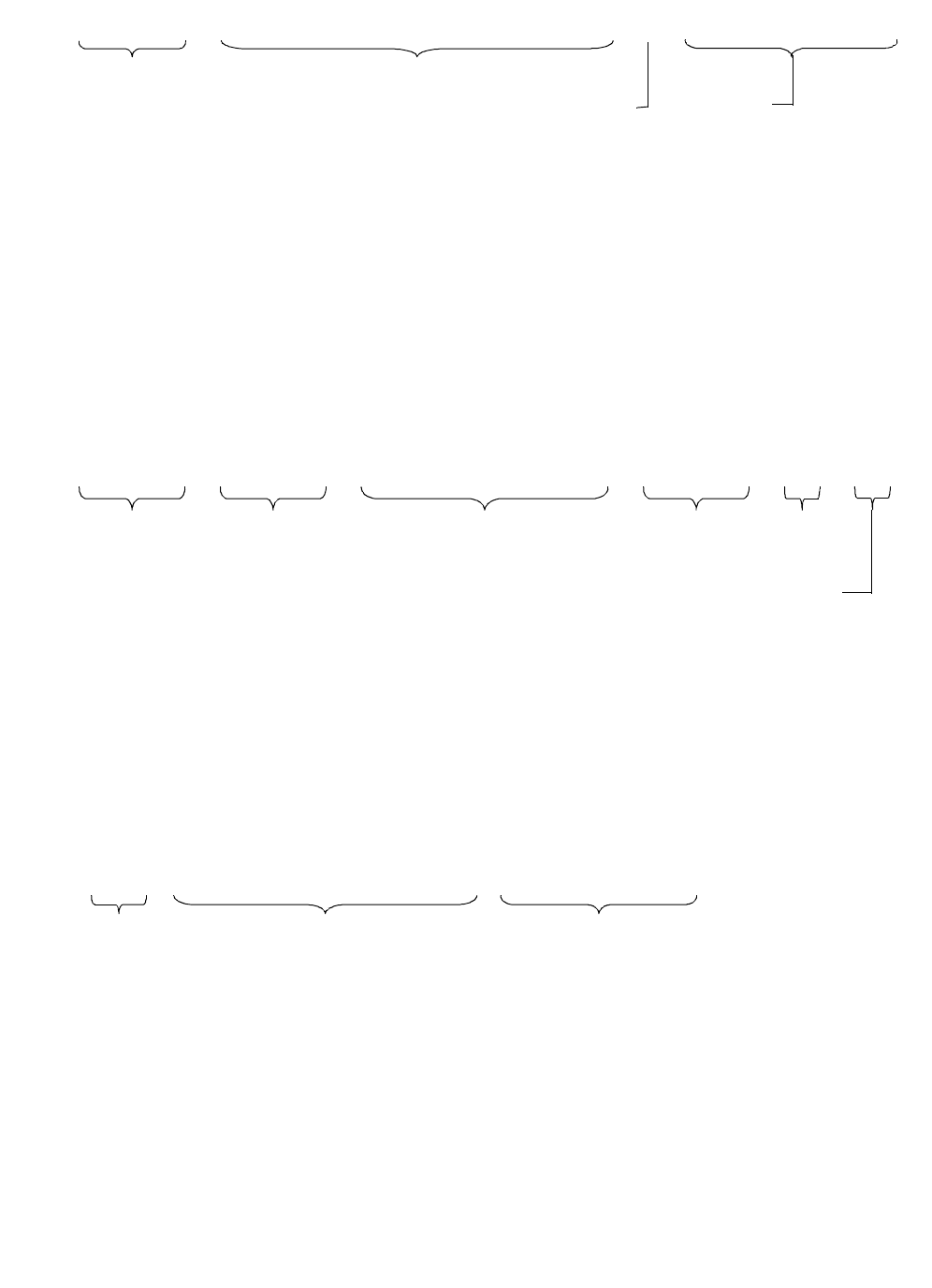
PROGRAMMING
3-4
June 1997
Part No. 001-3492-001
Figure 3-3 C-WORD
Figure 3-4 B-WORD
Figure 3-5 A0-WORD
4
321 141312111098765 2019181715 16 24232221
1 0 1 1 1 1 1 0 0000000000000010
ADDRESS
BITS
= 437 FOR 50 kHz REFERENCE
PA (ALWAYS 0)
NA (AUXILIARY DIVIDE RATIO)
(ALWAYS 0)
4
321 141312111098765 2019181715 16 24232221
1 0 000000000000
ADDRESS
BITS
0/1 0/1 0/1 0/1 0/1 0/1 0/1 0/1 0 1
NOT USED
(ALWAYS 0000) (CHANNEL DEPENDENT)
CK
(CHARGE PUMP CURRENT SETTING)
CN CL
BINARY ACCELERATION
FACTOR (ALWAYS 000000)
PR (PRESCALER TYPE) (10=MODULUS 3)
4
321 141312111098765 2019181715 16 24232221
ADDRESS
BITS
0/1 0/1 0/1 0/1 0/1 0/1 0/1 0/100/10/10/10/1 0/1 0/1 0/1 0/1 0/1 0/1 0/1 0/1
NM1
(NUMBER OF MAIN DIVIDER CYCLES
WHEN PRESCALER MODULUS = 64)
NM2
0/10/10/1
NF
(NUMBER OF MAIN DIVIDER CYCLES
WHEN PRESCALER MODULUS = 65)
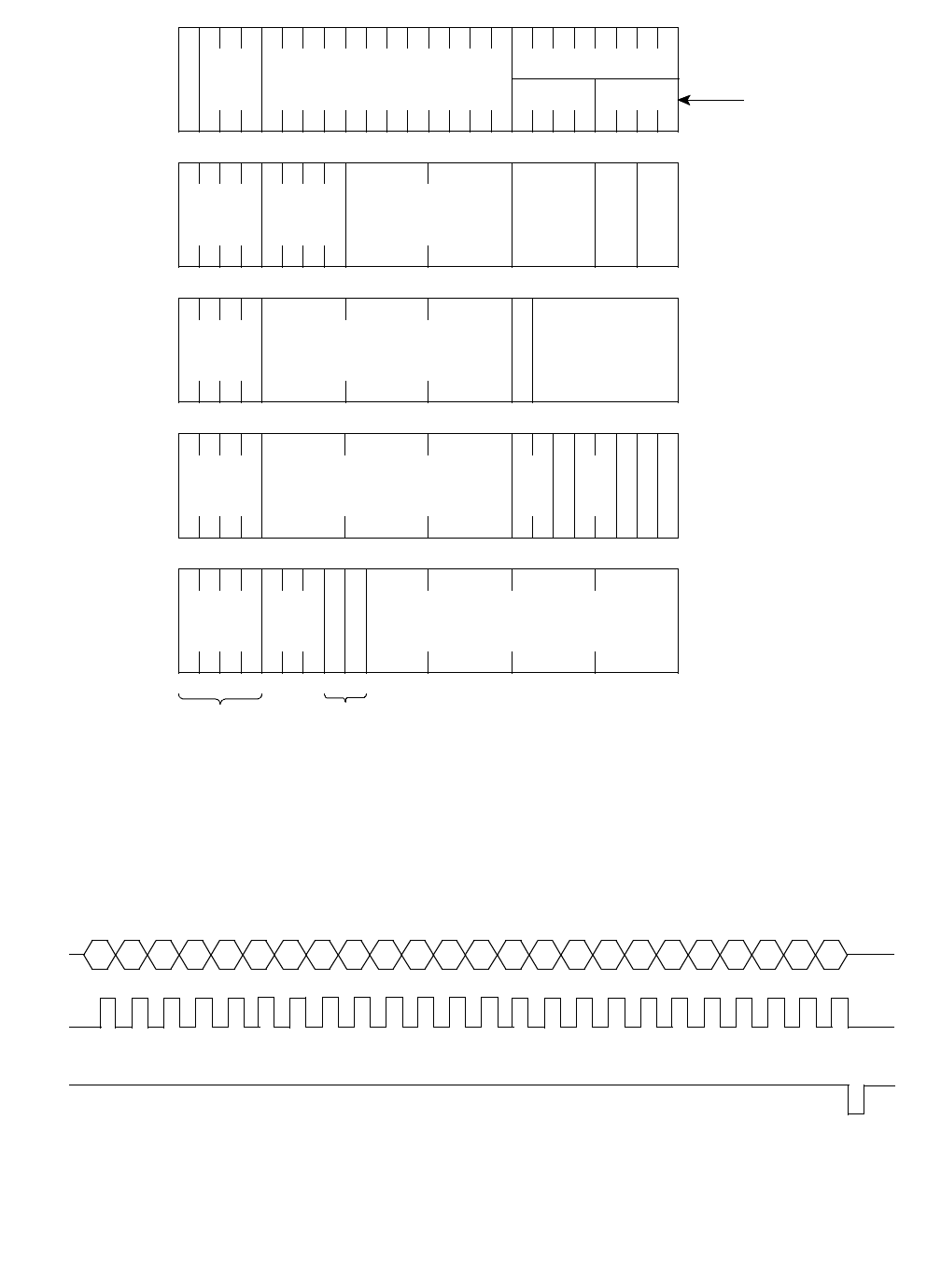
PROGRAMMING
3-5
June 1997
Part No. 001-3492-001
Figure 3-6 SERIAL INPUT WORD FORMAT
241
A0
B
C
D
E
0NF NM1
NM3 NM2
0 0 0 0 0 0 01 CN CK CL PR
PR="10"
0 01 1 NA PA 0
01 01 NR SM EM SA EA
F
M
O
D
L
O
N
G
1 11 1 0 0 0 T1 T0 0
ADDRESS BITS TEST BITS
124
NOTE: E-Word not used in Synthesizer load.
Figure 3-7 DIAGNOSTIC SERIAL DATA STREAM
XXXX
XX XXXX A1 A0 Rng D7 D6 D5 D4 D3 D2 D1 D0 XXXX
XX XXXX XXXX a0
LSB (00)
MSB (23)
Data
Clock
Diag En
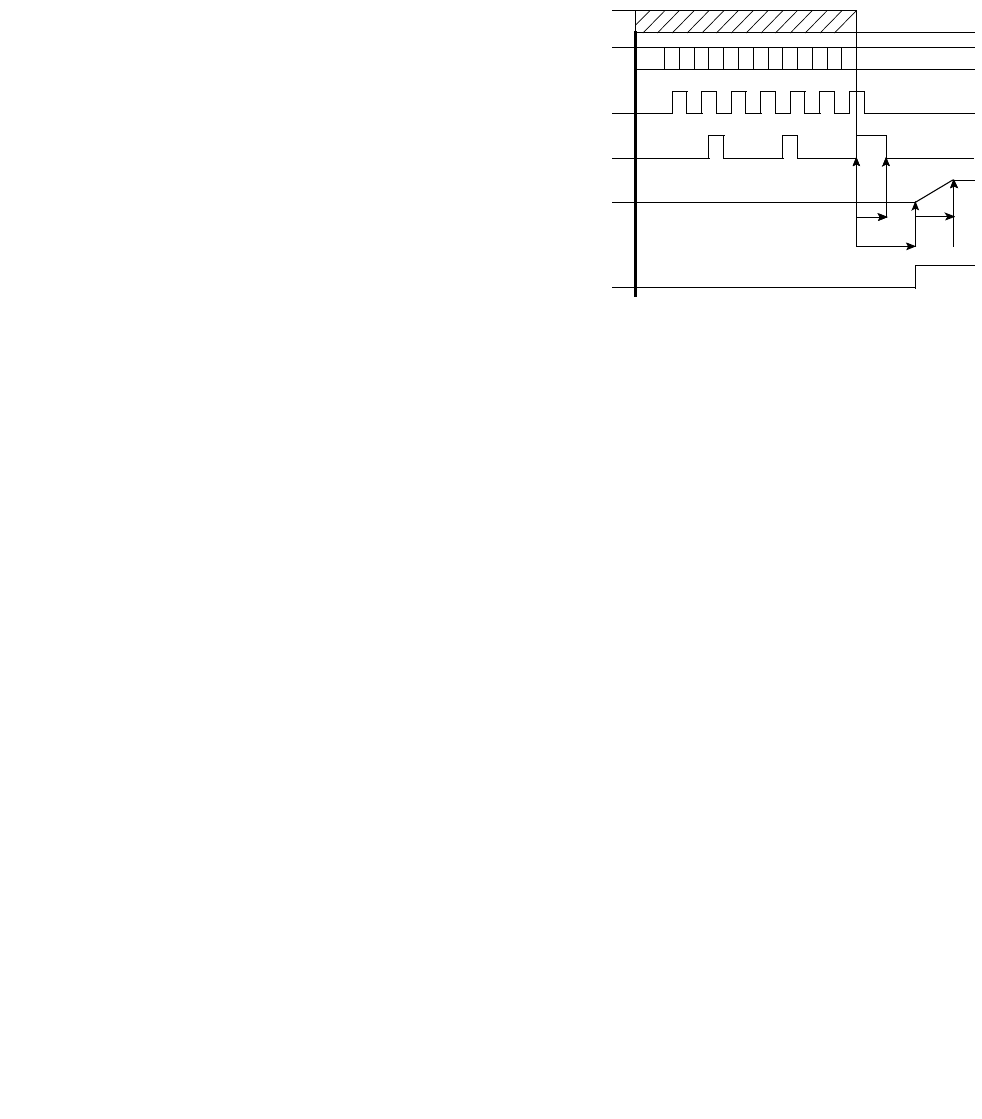
PROGRAMMING
3-6
June 1997
Part No. 001-3492-001
3.2.8 RADIO DIAGNOSTICS
The diagnostic features allow the user to program
a Digital-To-Analog Converter (DAC) to adjust RF
output power and modulation flatness without remov-
ing the radio from the enclosure. Bit "a0" can be set
to provide an analog voltage representative of the for-
ward and reverse RF power at the radio interface con-
nector J201, pin 14. This feature can be used to moni-
tor the condition of the transceiver and antenna/
feedline. Figure 3-7 is a diagram of the Diagnostic
Serial Data Stream with definitions of the bits. It is 19
bits long, the front (MSBs) can be padded with "Don’t
Cares" (XXs) to get to 24 bits.
Clock 1 MHz (max)
Diag Enable 250 ns (min)
XX Don’t Care
DAC Bits
A1-A0 = DAC Output Select
00=Power Set Data=0x00 to 0xFF, RNG=1
01=Mod Adj Data=0x00 to 0xFF, RNG=1
11=DAC Control Select Data=0x00 to 0xFF, RNG=1
RNG = Range Select (max output) (Ref=5.5V÷2)
0 = 1 x Ref
1 = 2 x Ref
D7-D0 = D/A Data
0x00 = 0.0V
0xFF = 1 x Ref (RNG=0)
0xFF = 2 x Ref (RNG=1)
Shift Register Bits:
a0 = Diagnostic Select to J201, pin 14 (Analog Voltage)
0 = Forward Power
1 = Reverse Power
3.3 RECEIVE TO TRANSMIT SEQUENCE
1. Synthesizer is loaded (D, C, B and A0 words).
Refer to Figure 3-8.
2. The state of the RX_EN line does not have to be
changed until the last bit is sent. However, Recieve
will cease as soon as it is changed.
3. The SYNTH ENABLE line should be held HIGH
for 2 to 3 milliseconds after the last word is sent.
This puts the frequency synthesizer in a SPEEDUP
MODE and slightly improves lock times then the
Synth Enable should be returned to a low state.
4. After the last word is strobed in, 7 milliseconds
(worst case) should elapse before TX_EN is turned
ON. This allows the synthesizer to come within
1 kHz of the desired frequency.
Figure 3-8 RX TO TX TIMING DIAGRAM
"Ramp-Up" is the amount of time required for
the transmitter to reach full power once the TX EN
has been applied. The Ramp-Up circuitry (located on
the transceiver) minimizes adjacent channel interfer-
ence caused by spectral spreading (sinx/x) when the
transmitter is keyed. The Ramp-Up time is approxi-
mately 3 ms.
3.4 TRANSMIT TO RECEIVE SEQUENCE
1. TX_EN is turned OFF. This signal is shaped.
Refer to Figure 3-9.
2. The synthesizer load process could begin slightly
before, but when the last bit is strobed in the synthe-
sizer it will become unlocked.
3. The RX_EN line should switch from low to high
AFTER the TX_EN is switched. The RX_EN not
only turns the RX circuits on but also Pin Shifts the
VCO.
D0D24D0 D24 D0 D24
"D" WORD "B" WORD "A" WORD
DATA
CLOCK
t=0
SPEEDUP RAMP-UP
LOCK
RX_EN
SYNTH_EN
9V TX
TX_EN
"C" WORD
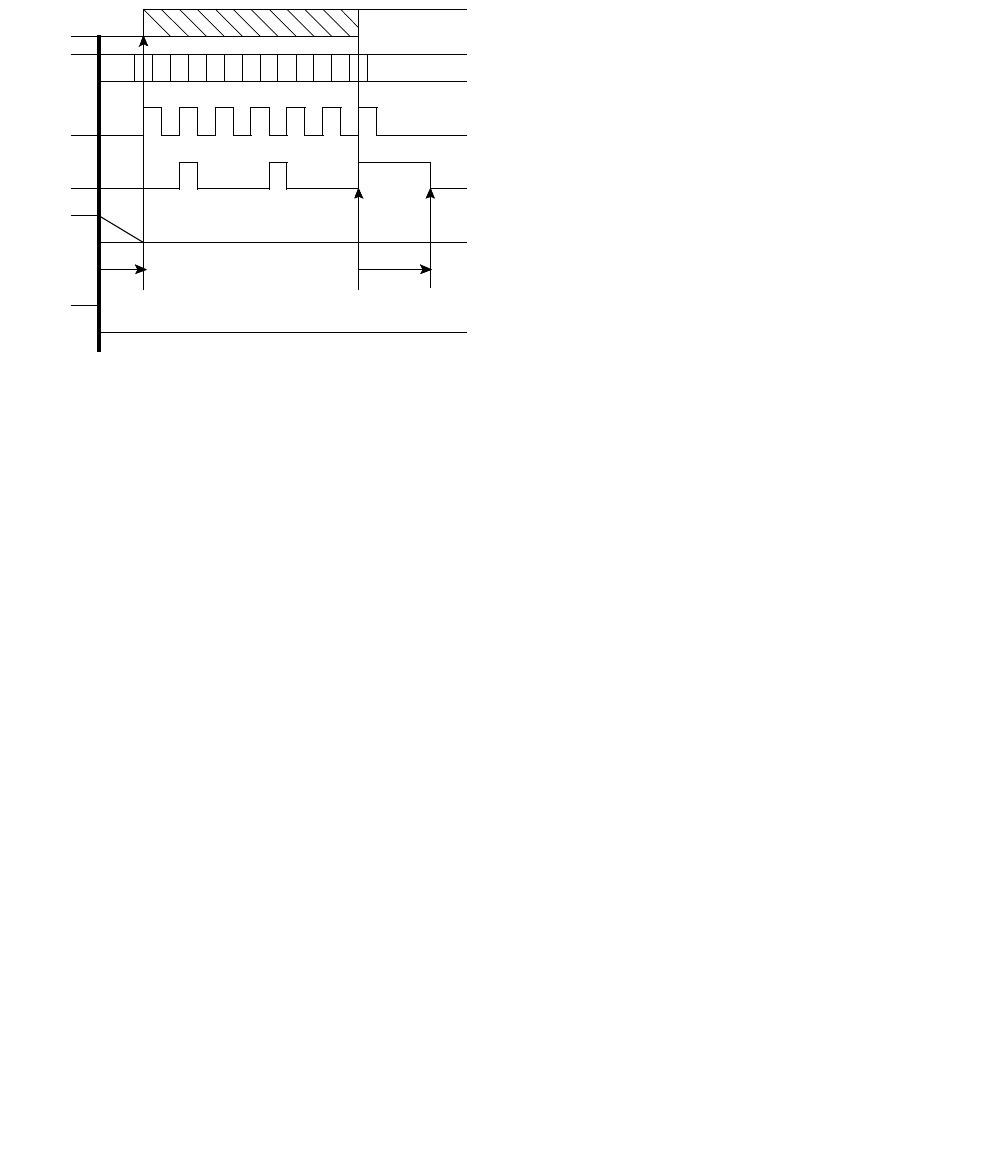
PROGRAMMING
3-7
June 1997
Part No. 001-3492-001
4. For quickest lock times the SYNTH ENABLE line
on the last load word should be held high for 2 to 3
milliseconds. It MUST NOT be left high as the syn-
thesizer in the SPEEDUP mode has poor noise per-
formance and would degrade the Receive
performance.
Figure 3-9 TX TO RX TIMING DIAGRAM
Speedup is 2 to 3 ms
Lock is approximately 7 ms
Ramp is approximately 3 ms
Dekey is approximately 3 ms
"Ramp-Down" is the amount of time required for
the transmitter output power to be reduced before
switching off the transmitter and enabling the receiver
with the RX EN. The Ramp-Down circuitry (located
on the transceiver) minimizes adjacent channel inter-
ference caused by spectral spreading (sinx/x) when the
transmitter un un-keyed. The Ramp-Down time is
approximately 3 ms.
D0D24D0 D24 D0 D24
"D" WORD "B" WORD "A" WORD
DATA
CLOCK
t=0
RAMP-DOWN SPEEDUP
RX_EN
SYNTH_EN
9V TX
TX_EN
"C" WORD

PROGRAMMING
3-8
June 1997
Part No. 001-3492-001
This page intentionally left blank.
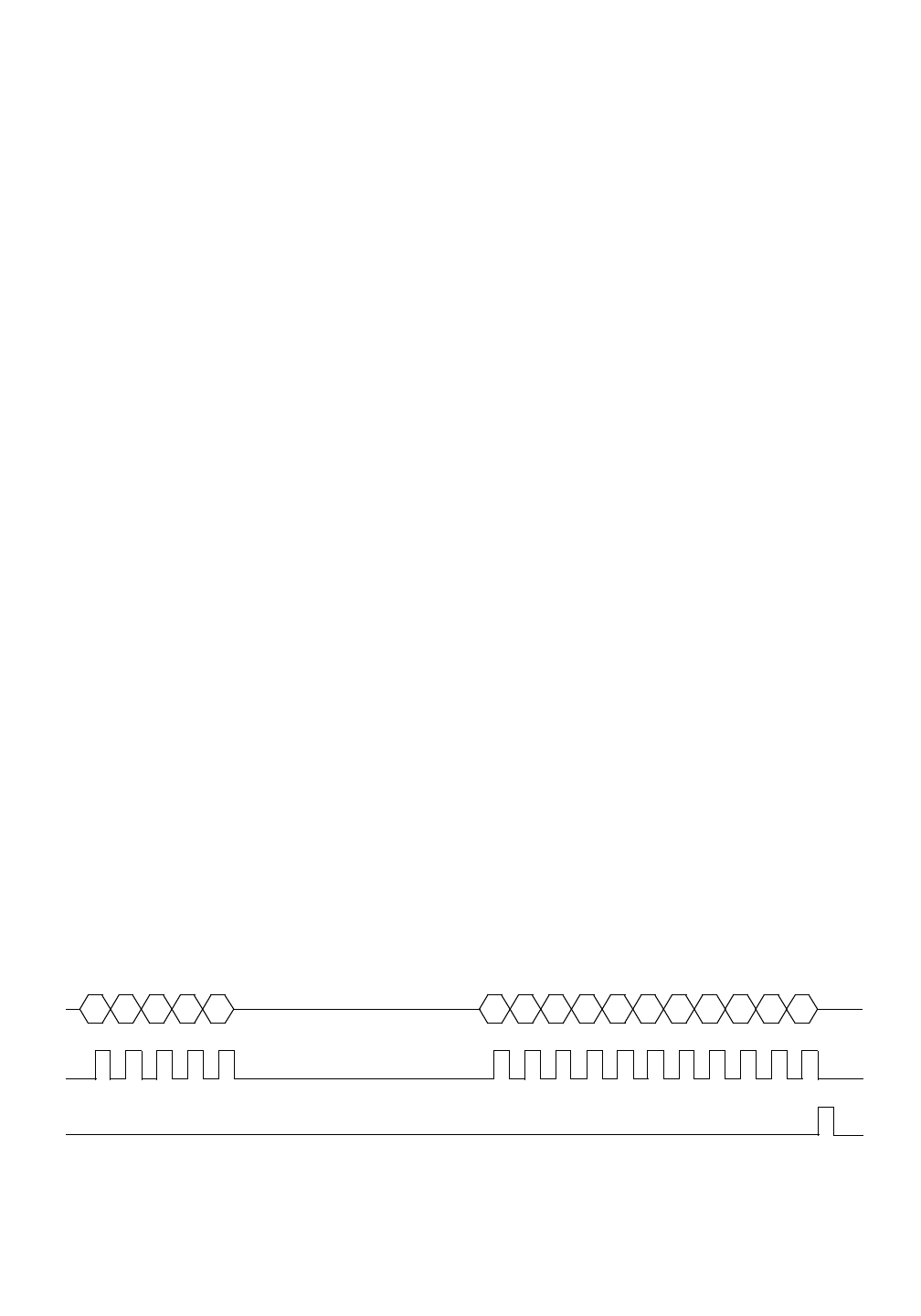
3-1
June 1997
Part No. 001-3492-001
SECTION 3 PROGRAMMING
3.1 INTRODUCTION
DM3492 - The information in Section 3.2
describes synthesizer programming protocol. This
information can be used as a basis for designing the
synthesizer programming hardware and software
required.
3.2 DM3492 SYNTHESIZER DATA PROTOCOL
3.2.1 GENERAL
The 928-960 MHz band is divided into two seg-
ments for the purpose of reducing VCO gain. The
"LOW" band covers the 928-944 MHz segment and
the "HIGH" band covers the 944-960 MHz segment.
The VCO band selection is accomplished by capaci-
tive pin-switching. The band switching is imple-
mented in both the transmit and receive modes. The
front-end filters and transmitter line-up cover the
entire 928-960 MHz band without adjustment.
Receive Bandwidth 928-960 MHz
Transmit Bandwidth 928-960 MHz
First IF 87.850 MHz
Second IF 450.0 kHz
First LO Injection 840.150-872.150 MHz*
Second LO Injection 87.40 MHz*
TCXO Frequency 17.50 MHz
Resolution 6.25 kHz
Loop Comparison Freq. 50 kHz
* Low Side Injection
A diagram of the 32 Bit Synthesizer Serial Data
Stream with definitions of the bits is shown in Figure
3-1.
Clock 1 MHz (max)
Synth Enable 250 ns (min) (for D, C and B words
approximately 3 ms for A0 word)
D00-D23 D, C, B and A0 words
3.2.2 SYNTHESIZER DATA
In order to implement the band selection and
Tx/Rx frequency shift mentioned in Section 3.2.1, an
additional shift register was added to the synthesizer
section. Therefore, an additional 8 Bits of data are
added to each of the synthesizer load words (D/C/B/
A0) as shown in the serial data stream in Figure 3-1.
3.2.3 D-WORD CALCULATION (24 BITS)
The D-Word programs the Main, Reference and
Auxiliary dividers, and sets the modulus (refer to
Figures 3-2 and 3-6).
NR = 350 Ftcxo/50 kHz=350
where Ftcxo=17.5 MHz
SM = 00 Reference select for main phase detector
EM = 1 Main divider enable flag
SA = 00 Reference select for aux phase detector
EA = 1 Auxiliary divider enable flag
FMOD = 1 Selects modulus 8
LONG = 0 Send all 4 words with A0
D Word = 0xA1 0x5E 0x26
Figure 3-1 32-BIT SYNTHESIZER SERIAL DATA STREAM
D1 D0 XXXX
XX XX
LSB (00)
Data
Clock
Synth En
MSB (31)
D23 D22 D21 D20 - - Tx-Tx+Low-
Low+

PROGRAMMING
3-2
June 1997
Part No. 001-3492-001
3.2.4 C-WORD CALCULATION (24 BITS)
The C-Word enables the auxiliary prescaler, and
sets the auxiliary divide ratio for the secondary (Sec-
ond LO) loop (refer to Figures 3-4 and 3-7).
PA = 0 Sets aux prescaler mode to ÷ 4
NA = 437 (0x1B5) Auxiliary divide ratio
87.4 MHz ÷ (4 x 437) = 50 kHz
C-Word = 0x91 0xB5 0x00
3.2.5 B-WORD CALCULATION (24 BITS)
The B-Word programs the Fractional-N charge
pump current setting factor. The Binary acceleration
factors (CL/CK) and prescaler type (modulus 3).
The value of CN should be interpolated for fre-
quencies between the band edges. With these recom-
mended values of CN, the transceiver should have the
fractional spurs minimized far below the levels needed
to make 70 dB adjacent channel Rx or Tx specifica-
tions.
The Charge Pump Current setting (CN) could be
changed on a channel-by-channel basis for ultimate
rejection of the Fraction N spurious responses close
into the carrier frequency. the 3492 synthesizer has an
adjust (R823) for the fractional compensation cur-
rent. The factory preset value will allow CN to be set
to the following ranges:
(Refer to Figures 3-3 and 3-7)
Frequency in a Band CN
Lowest Tx 110
Highest Tx 115
Lowest Rx 100
Highest Rx 105
CN = * (Channel/Frequency dependent variable)
(110-115 Tx) (100-105 Rx)
CK = 0000 Binary acceleration factor for integral
charge pump
CL = 00 Binary acceleration factor for
proportional charge pump
PR = 10 Selects modulus 3 prescaler
B-Word = 0x80 (8 bit CN) 0x02
3.2.6 A0-WORD CALCULATION (24 BITS)
The A0-Word is sent last (see Figure 3-5). The
A0-Word contains the data for the loop dividers and is
programmed on a channel-by-channel basis. The
Functional-N (NF) word is a 3 bit word that programs
the synthesizer to the fractional steps determined by
the fractional modulus selection flag (1 = modulus 8)
and the loop comparison frequency (50 kHz). The fre-
quency resolution (i.e. step size) is then 50 kHz ÷ 8 =
6.25 kHz.
NF=* Fractional increment for modulus 8 (3 bits)
NM1=* Number of main divider cycles when
prescaler modulus equals 64 (12 bits)
NM2=* Number of main divider cycles when
prescaler modulus equals 65 (4 bits, PR=10)
NM3=* Number of main divider cycles when
prescaler modulus equals 72 (4 bits, PR=10)
* Indicates frequency/channel dependant variable.
EXAMPLE: To program an 18.75 kHz channel:
NF = 18.75 kHz ÷ 6.25 kHz
NF = 3
NM1, NM2 and NM3 are calculated as follows:
N = (NM1 + 2) x 64 + NM2 x 65 + (NM3 +1) x 72
Where:
N = Total division ratio
NM1 = Number of main divider cycles when
prescaler modulus equals 64
NM2 = Number of main divider cycles when
prescaler modulus equals 65
NM3 = Number of main divider cycles when
prescaler modulus equals 72
Example:
Calculate NM1, NM2 and NM3 to Rx 944.150 MHz
Rx LO = 944.15 - 87.85 = 856.3 MHz (Synth Freq)
(87.85 MHz IF with Low Side Injection)
N = Rx LO ÷ FCM = 856.3 ÷ 0.05 = 17126
(FCM = Loop Reference Frequency)
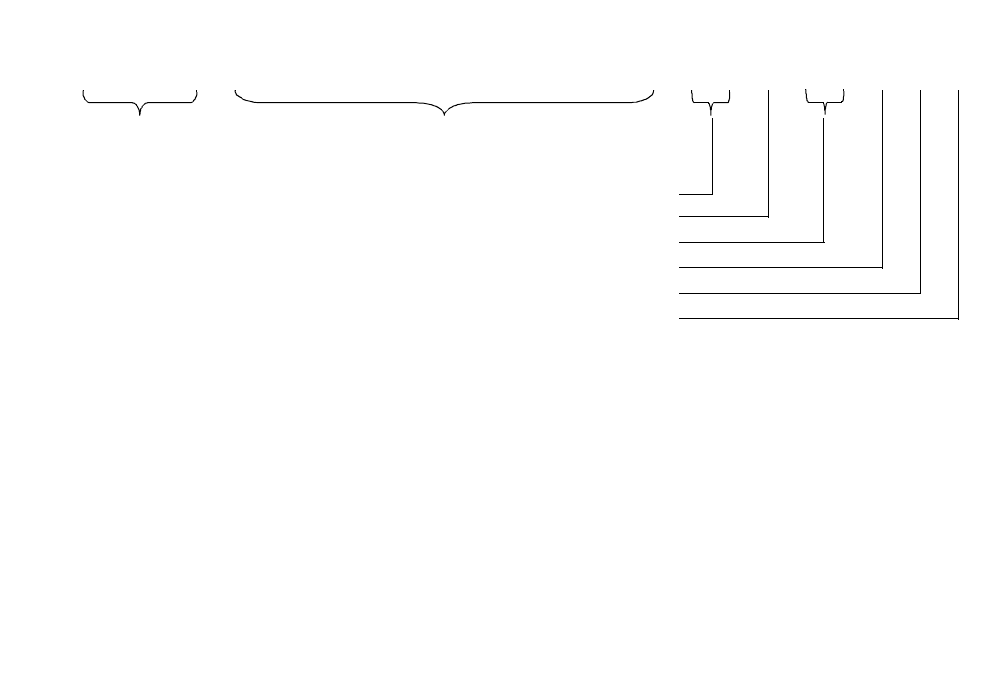
PROGRAMMING
3-3
June 1997
Part No. 001-3492-001
NM3 = (INT(64 x FRAC [N ÷ 64]) ÷ 8) - 1
= (INT(64 x 0.59375) ÷ 8) - 1
= (INT(38 ÷ 8)) - 1
= 4 - 1
= 3
NM2 = 8 x FRAC [N ÷ 8]
= 8 x 0.75
= 6
NM1 = INTEGER [N ÷ 64] - NM2 - NM3 - 3
= 267 - 6 - 3 - 3
= 255
3.2.7 TX / RX FREQUENCY SHIFT AND BAND
SELECTION
As mentioned in 3.2.2, in order to implement the
band selection and Rx/Rx an additional 8 bits of data
are added to each of the synthesizer load words (D/C/
B/AO) (see Figure 3-1). The frequency bands and
Transmit/Receive Bits are defined as follows:
Low Band 928-944 MHz
High Band >944 MHz to 960 MHz
xx Don’t care
Low+ Low Band Select (1=lowband, 0=highband)
Low- Low Band Select (0=lowband, 1=highband)
Tx+ Transmit Select (1=Tx mode, 0=Rx mode)
Tx- Transmit Select (0=Tx mode, 1=Rx mode)
Figure 3-2 D-WORD
4
321 141312111098765 2019181715 16 24232221
1 1 1 1 1 1 1 1 00/110000000000000
ADDRESS
BITS
= 350 FOR 50 kHz REFERENCE
EA (ALWAYS 1)
FMOD (1 = MODULUS 8)
SA (ALWAYS 00)
EM (ALWAYS 1)
SM (ALWAYS 00)
LONG (0=24 BIT WORD)
NR (REFERENCE DIVIDE)
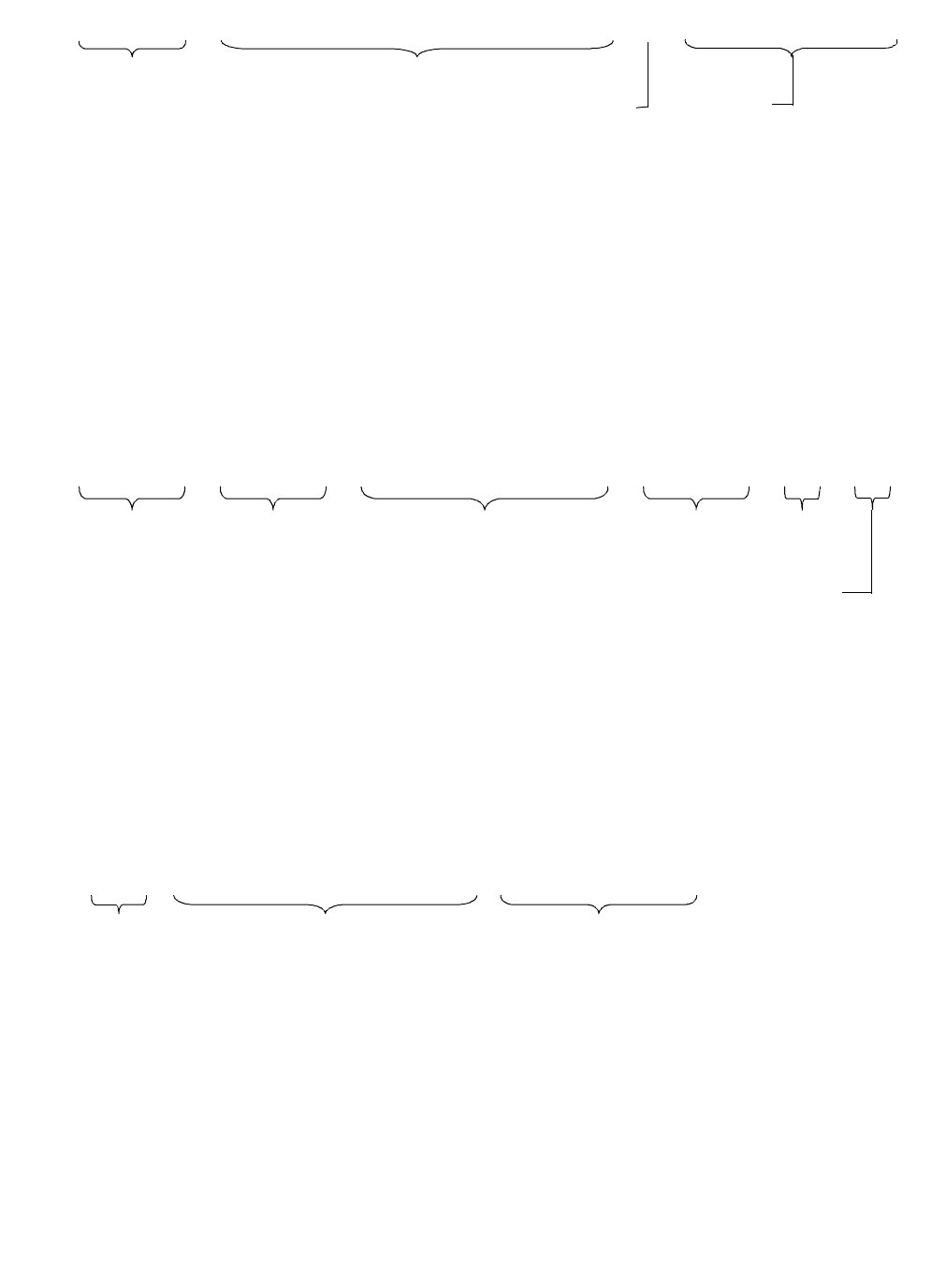
PROGRAMMING
3-4
June 1997
Part No. 001-3492-001
Figure 3-3 C-WORD
Figure 3-4 B-WORD
Figure 3-5 A0-WORD
4
321 141312111098765 2019181715 16 24232221
1 0 1 1 1 1 1 0 0000000000000010
ADDRESS
BITS
= 437 FOR 50 kHz REFERENCE
PA (ALWAYS 0)
NA (AUXILIARY DIVIDE RATIO)
(ALWAYS 0)
4
321 141312111098765 2019181715 16 24232221
1 0 000000000000
ADDRESS
BITS
0/1 0/1 0/1 0/1 0/1 0/1 0/1 0/1 0 1
NOT USED
(ALWAYS 0000) (CHANNEL DEPENDENT)
CK
(CHARGE PUMP CURRENT SETTING)
CN CL
BINARY ACCELERATION
FACTOR (ALWAYS 000000)
PR (PRESCALER TYPE) (10=MODULUS 3)
4
321 141312111098765 2019181715 16 24232221
ADDRESS
BITS
0/1 0/1 0/1 0/1 0/1 0/1 0/1 0/100/10/10/10/1 0/1 0/1 0/1 0/1 0/1 0/1 0/1 0/1
NM1
(NUMBER OF MAIN DIVIDER CYCLES
WHEN PRESCALER MODULUS = 64)
NM2
0/10/10/1
NF
(NUMBER OF MAIN DIVIDER CYCLES
WHEN PRESCALER MODULUS = 65)
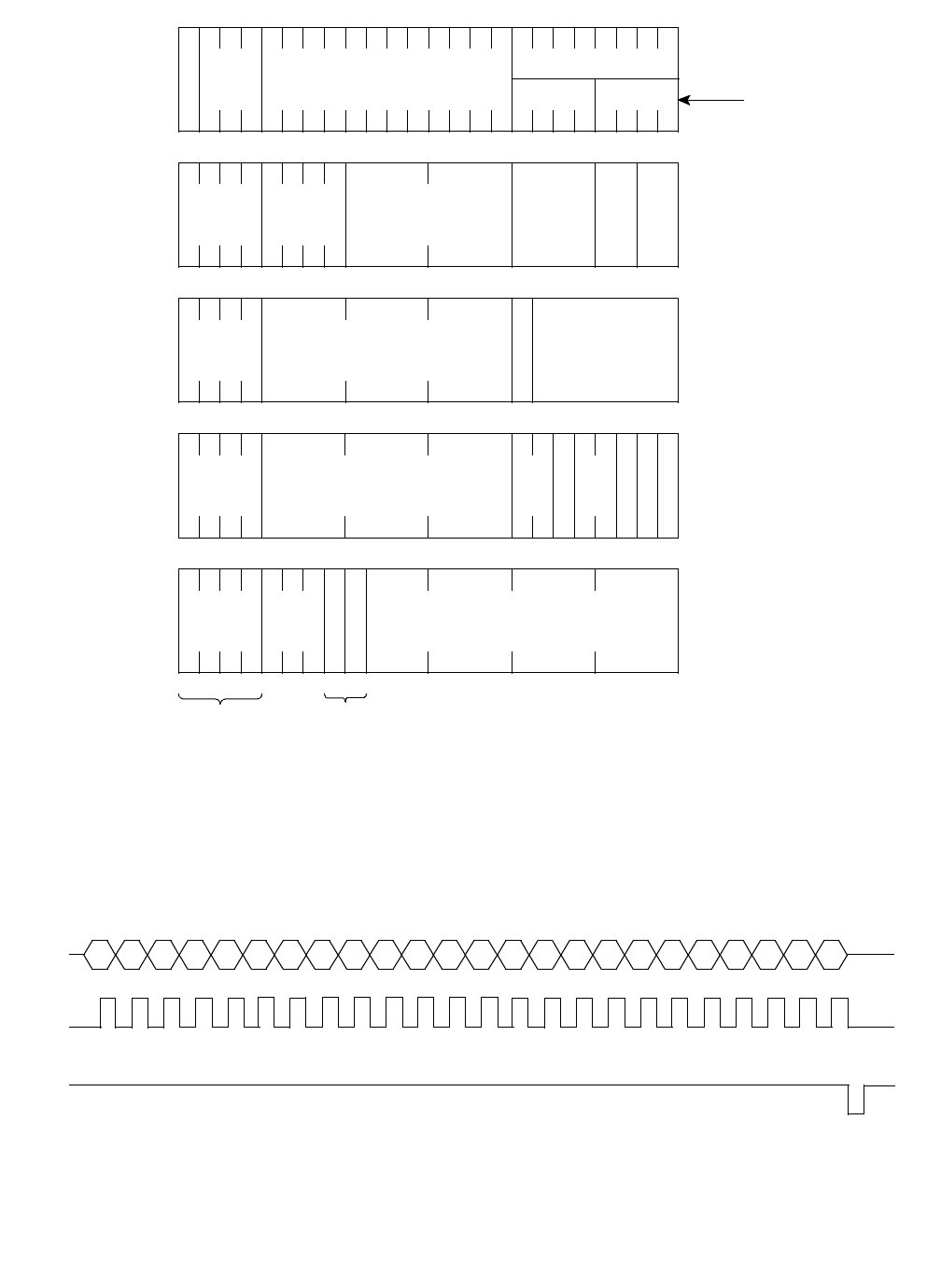
PROGRAMMING
3-5
June 1997
Part No. 001-3492-001
Figure 3-6 SERIAL INPUT WORD FORMAT
241
A0
B
C
D
E
0NF NM1
NM3 NM2
0 0 0 0 0 0 01 CN CK CL PR
PR="10"
0 01 1 NA PA 0
01 01 NR SM EM SA EA
F
M
O
D
L
O
N
G
1 11 1 0 0 0 T1 T0 0
ADDRESS BITS TEST BITS
124
NOTE: E-Word not used in Synthesizer load.
Figure 3-7 DIAGNOSTIC SERIAL DATA STREAM
XXXX
XX XXXX A1 A0 Rng D7 D6 D5 D4 D3 D2 D1 D0 XXXX
XX XXXX XXXX a0
LSB (00)
MSB (23)
Data
Clock
Diag En
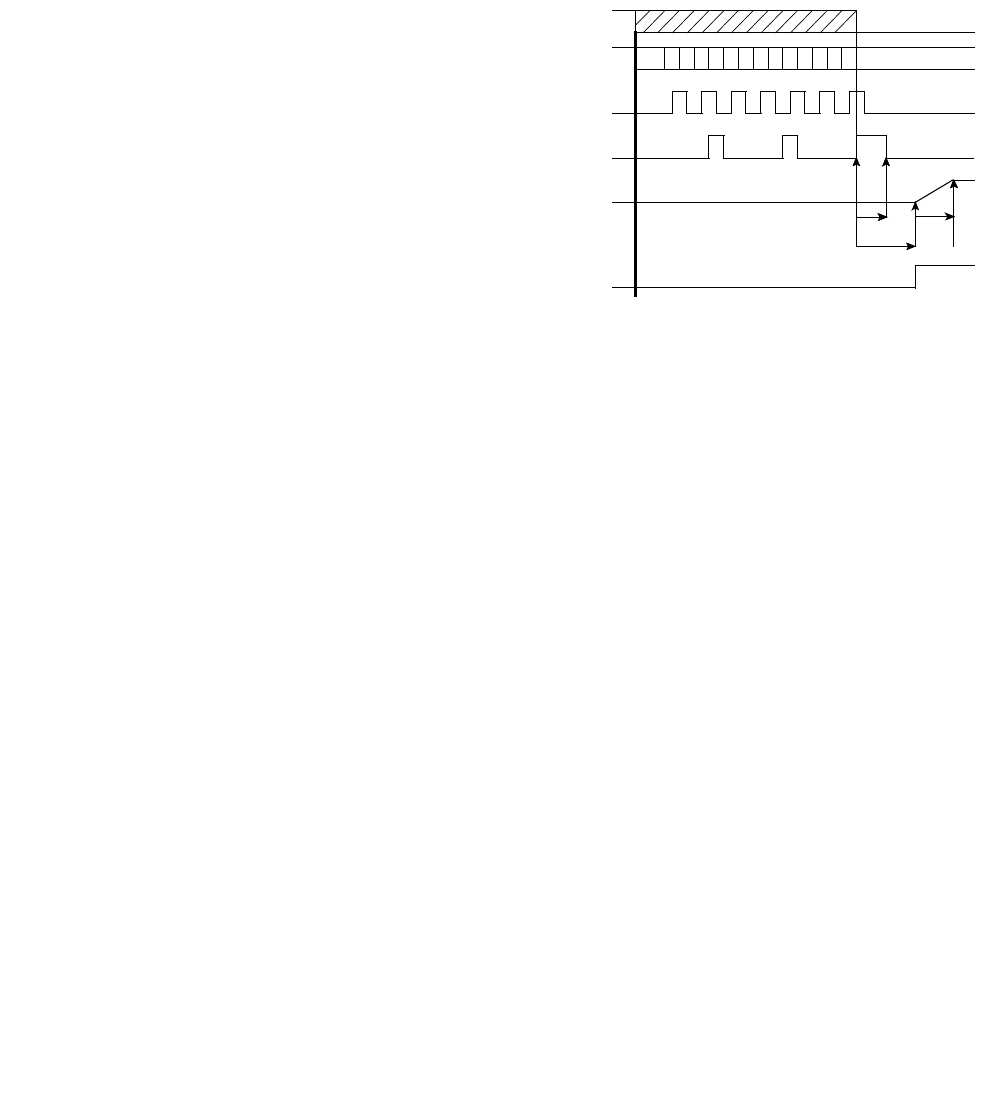
PROGRAMMING
3-6
June 1997
Part No. 001-3492-001
3.2.8 RADIO DIAGNOSTICS
The diagnostic features allow the user to program
a Digital-To-Analog Converter (DAC) to adjust RF
output power and modulation flatness without remov-
ing the radio from the enclosure. Bit "a0" can be set
to provide an analog voltage representative of the for-
ward and reverse RF power at the radio interface con-
nector J201, pin 14. This feature can be used to moni-
tor the condition of the transceiver and antenna/
feedline. Figure 3-7 is a diagram of the Diagnostic
Serial Data Stream with definitions of the bits. It is 19
bits long, the front (MSBs) can be padded with "Don’t
Cares" (XXs) to get to 24 bits.
Clock 1 MHz (max)
Diag Enable 250 ns (min)
XX Don’t Care
DAC Bits
A1-A0 = DAC Output Select
00=Power Set Data=0x00 to 0xFF, RNG=1
01=Mod Adj Data=0x00 to 0xFF, RNG=1
11=DAC Control Select Data=0x00 to 0xFF, RNG=1
RNG = Range Select (max output) (Ref=5.5V÷2)
0 = 1 x Ref
1 = 2 x Ref
D7-D0 = D/A Data
0x00 = 0.0V
0xFF = 1 x Ref (RNG=0)
0xFF = 2 x Ref (RNG=1)
Shift Register Bits:
a0 = Diagnostic Select to J201, pin 14 (Analog Voltage)
0 = Forward Power
1 = Reverse Power
3.3 RECEIVE TO TRANSMIT SEQUENCE
1. Synthesizer is loaded (D, C, B and A0 words).
Refer to Figure 3-8.
2. The state of the RX_EN line does not have to be
changed until the last bit is sent. However, Recieve
will cease as soon as it is changed.
3. The SYNTH ENABLE line should be held HIGH
for 2 to 3 milliseconds after the last word is sent.
This puts the frequency synthesizer in a SPEEDUP
MODE and slightly improves lock times then the
Synth Enable should be returned to a low state.
4. After the last word is strobed in, 7 milliseconds
(worst case) should elapse before TX_EN is turned
ON. This allows the synthesizer to come within
1 kHz of the desired frequency.
Figure 3-8 RX TO TX TIMING DIAGRAM
"Ramp-Up" is the amount of time required for
the transmitter to reach full power once the TX EN
has been applied. The Ramp-Up circuitry (located on
the transceiver) minimizes adjacent channel interfer-
ence caused by spectral spreading (sinx/x) when the
transmitter is keyed. The Ramp-Up time is approxi-
mately 3 ms.
3.4 TRANSMIT TO RECEIVE SEQUENCE
1. TX_EN is turned OFF. This signal is shaped.
Refer to Figure 3-9.
2. The synthesizer load process could begin slightly
before, but when the last bit is strobed in the synthe-
sizer it will become unlocked.
3. The RX_EN line should switch from low to high
AFTER the TX_EN is switched. The RX_EN not
only turns the RX circuits on but also Pin Shifts the
VCO.
D0D24D0 D24 D0 D24
"D" WORD "B" WORD "A" WORD
DATA
CLOCK
t=0
SPEEDUP RAMP-UP
LOCK
RX_EN
SYNTH_EN
9V TX
TX_EN
"C" WORD
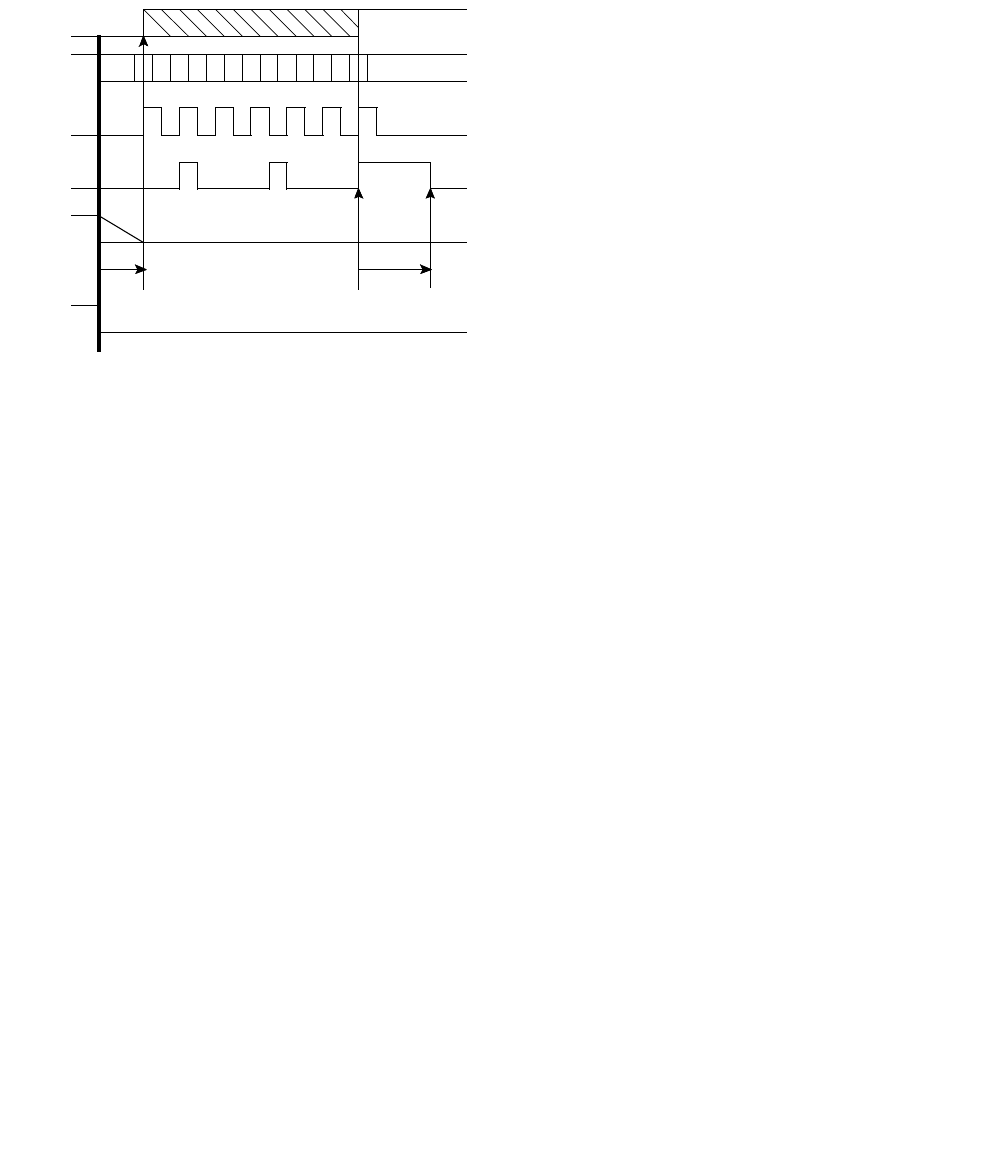
PROGRAMMING
3-7
June 1997
Part No. 001-3492-001
4. For quickest lock times the SYNTH ENABLE line
on the last load word should be held high for 2 to 3
milliseconds. It MUST NOT be left high as the syn-
thesizer in the SPEEDUP mode has poor noise per-
formance and would degrade the Receive
performance.
Figure 3-9 TX TO RX TIMING DIAGRAM
Speedup is 2 to 3 ms
Lock is approximately 7 ms
Ramp is approximately 3 ms
Dekey is approximately 3 ms
"Ramp-Down" is the amount of time required for
the transmitter output power to be reduced before
switching off the transmitter and enabling the receiver
with the RX EN. The Ramp-Down circuitry (located
on the transceiver) minimizes adjacent channel inter-
ference caused by spectral spreading (sinx/x) when the
transmitter un un-keyed. The Ramp-Down time is
approximately 3 ms.
D0D24D0 D24 D0 D24
"D" WORD "B" WORD "A" WORD
DATA
CLOCK
t=0
RAMP-DOWN SPEEDUP
RX_EN
SYNTH_EN
9V TX
TX_EN
"C" WORD

PROGRAMMING
3-8
June 1997
Part No. 001-3492-001
This page intentionally left blank.

4-1
June 1997
Part No. 001-3492-001
SECTION 4 CIRCUIT DESCRIPTION
4.1 GENERAL
4.1.1 INTRODUCTION
The main subassemblies of this transceiver are
the RF board, VCO board, TCXO, Loader board or
Modem. A block diagram of the transceiver is located
in Figure 4-1. The 3492 is also available in Transmit
only and Receive only models.
The 3492 has a reference oscillator stability of
±1.5 PPM. The 17.5 MHz TCXO (Temperature Com-
pensated Crystal Oscillator) is soldered directly to the
RF board. The TCXO is not serviceable.
4.1.2 SYNTHESIZER
The VCO (voltage-controlled oscillator) output
signal is the receiver first injection frequency in the
Receive mode and the transmit frequency in the
Transmit mode. The first injection frequency is
87.85 MHz below the receive frequency. The fre-
quency of this oscillator is controlled by a DC voltage
produced by the phase detector in synthesizer chip
U800.
Channels are selected by programming counters
in U800 to divide by a certain number. This program-
ming is performed over a serial bus formed by the
Synth Clock, Synth Enable, and Data pins of J201.
This programming is performed by the Loader board,
modem or user supplied hardware and software (see
Section 3).
The frequency stability of the synthesizer in both
the receive and transmit modes is established by the
stability of the TCXO. The TCXO is stable over a
temperature range of -30° to +60° C (-22° to +140° F).
4.1.3 RECEIVER
The receiver is a double-conversion type with
intermediate frequencies of 87.85 MHz / 450 kHz.
Bandpass filters reject the image, half IF, injection,
and other unwanted frequencies. A four-pole crystal
filter enhances receiver selectivity.
4.1.4 TRANSMITTER
The transmitter produces a nominal RF power
output of 5W at 13.3V DC, adjustable down to 1W.
Frequency modulation of the transmit signal occurs in
the synthesizer. Transmit audio processing circuitry is
contained in the Loader board, modem or customer-
supplied equipment.
4.2 SYNTHESIZER
Programming of the synthesizer provides the data
necessary for the internal prescaler and counters. One
input signal is the reference frequency. This frequency
is produced by the 17.5 MHz reference oscillator
(TCXO). The other input signal is the VCO
frequency.
A block diagram of the synthesizer is shown in
Figure 4-1 and a block diagram of Synthesizer IC
U800 is shown in Figure 4-2. As stated previously,
the synthesizer output signal is produced by a VCO
(voltage controlled oscillator). The VCO frequency is
controlled by a DC voltage produced by the phase
detector in U800. The phase detector senses the phase
and frequency of the two input signals and causes the
VCO control voltage to increase or decrease if they
are not the same. The VCO is then "locked" on
frequency.
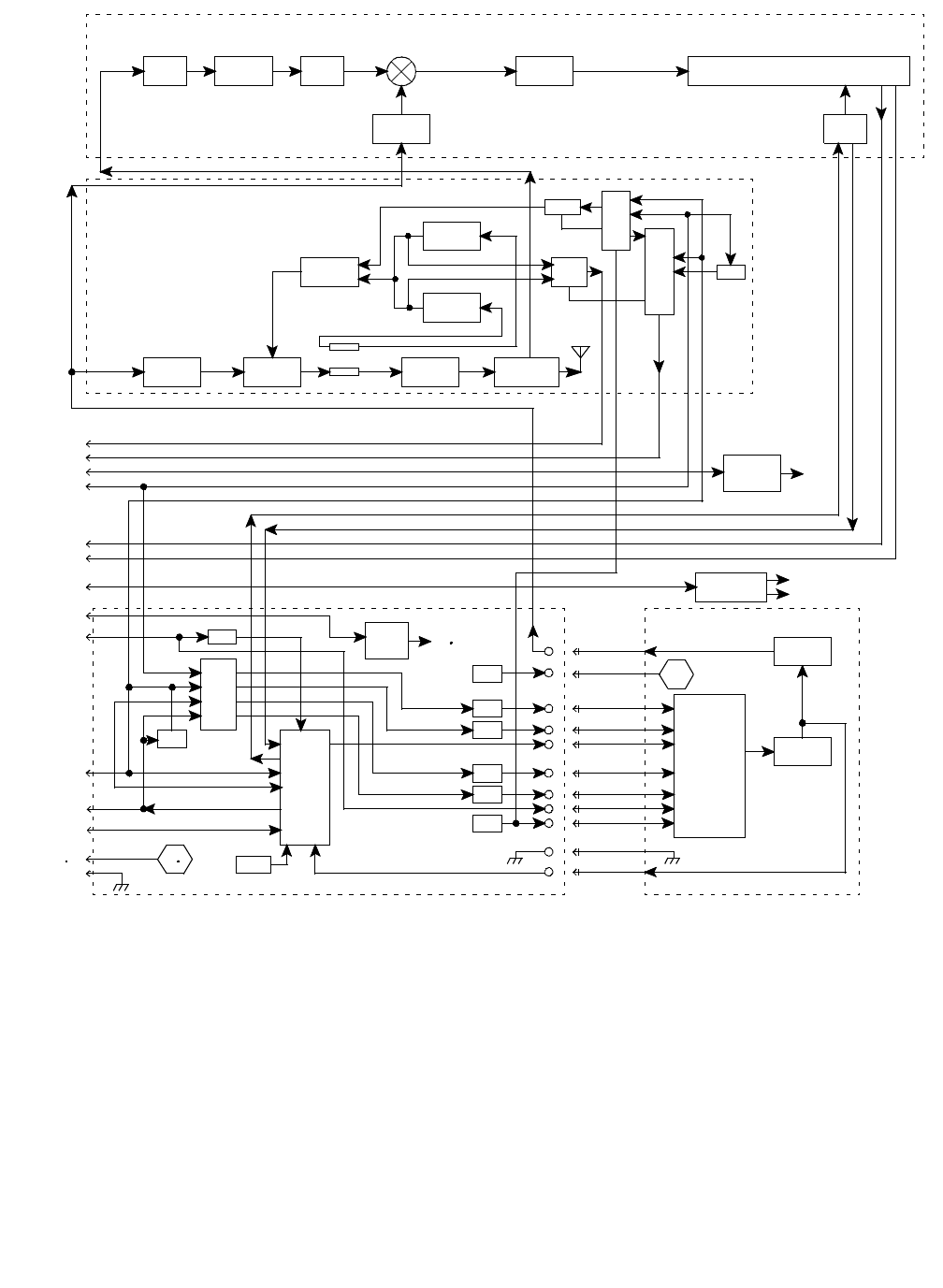
CIRCUIT DESCRIPTION
4-2
June 1997
Part No. 001-3492-001
Figure 4-1 TRANSCEIVER BLOCK DIAGRAM
U230
840.15-872.15 MHZ
1st LO AMP
RECEIVER
TRANSMITTER
SYNTHESIZER
SEC LO
CNTRL
RSSI
CLOCK
DATA
RX OUT
DIAG EN
DIAG
TX EN
RSSI
RF INTEST
Q240
87.85 MHz
Z220/Z221
Q211
Q260/Q261
Z201Q200/Q201Z200
Q500
DRIVER
U510
Q520/U130C
U520B
U520A
CR540/CR541
Q911
CLOCK
DIAG EN
U901
U902A
U902A U900
DATA
RX OUT
DIAG EN
DIAG
TX EN
Q135
U130A/B/D
Q133/Q134
U111
Q110/U110
RF EN
R818
Q841
Q842
Q843
Q844
Q845
CTRL
+9V
LOWBAND +
LOWBAND -
SYNTH OUT
MOD ADJUST
MOD INPUT
T/R PS +
T/R PS -
Q820 Q821/Q822
Q823
U840
Q840
SYNTH DATA
U800
Q800
+13.3V
SYNTH EN
LOCK DET
Q132
Q131
Q130
Y800
RF AMP MIXER CRYSTAL FILTER
ANTENNA
SWITCH
RX AUDIO
VCO
AMPLIFIER
VCO BUFFER/
RSSI
LOW-PASS
FILTER
RF OUT
RF BPF RF BPF IF / 450 kHz FILTER
2nd LO AMP
AMPLIFIER
TX IN
TCXO
+13.3V
PWR SET
MOD ADJ
+9V TX
RX EN
+13.3V
SWITCHED
CLOCK
V FWD
V REV
+9.6V
+5.5V

CIRCUIT DESCRIPTION
4-3
June 1997
Part No. 001-3492-001
4.2.1 VOLTAGE-CONTROLLED OSCILLATOR
Oscillator
The VCO is formed by Q820, several capacitors
and varactor diodes, and ceramic resonator L826. It
oscillates at the transmit frequency in transmit mode
and first injection frequency in the receive mode (928-
960 MHz in transmit and 840.150-872.150 MHz in
receive).
Biasing of Q820 is provided by R823, R824 and
R826. An AC voltage divider formed by C844 and
C845 initiates and maintains oscillation and also
matches Q820 to the tank circuit. Resonator L826 is
grounded at one end to provide shunt inductance to
the tank circuit.
Frequency Control and Modulation
The VCO frequency is controlled by a DC volt-
age across varactor diode CR824. As voltage across a
reverse-biased varactor diode increases, its capaci-
tance decreases. The VCO frequency increases as the
control voltage increases. The control line is isolated
from tank circuit RF by choke L825. The amount of
frequency change produced by CR824 is controlled by
series capacitor C836.
The VCO frequency is modulated with the trans-
mit audio/data signal from J201, pin 6 is applied
across varactor diode CR822 which varies the VCO
frequency at an audio rate. Series capacitors C825/
C824 couple the VCO to CR822. R821 provides a
DC ground on the anodes of CR822/CR823, and isola-
tion is provided by R820 and C826. C827 is an RF
bypass.
The DC voltage across CR823 provides compen-
sation to keep modulation relatively flat over the
entire bandwidth of the VCO. This compensation is
required because modulation tends to increase as the
VCO frequency gets higher (capacitance of CR824/
CR825/CR826/CR827 gets lower). CR823 also bal-
ances the modulation signals applied to the VCO and
TCXO. The DAC can be used to adjust the VCO
modulation sensitivity.
The DC voltage applied across CR823 comes
from the modulation adjust control R818 on the RF
board. R820 applies a DC biasing voltage to CR822;
C815 provides DC blocking. RF isolation is provided
by C827, R822 and R817.
4.2.2 VCO AND REFERENCE OSCILLATOR
MODULATION
Both the VCO and reference oscillator (TCXO)
are modulated in order to achieve a flat frequency
response. If only the VCO were modulated, the phase
detector in U800 would sense the frequency change
and increase or decrease the VCO control voltage to
counteract the change (especially at the lower audio
frequencies). If only the reference oscillator fre-
quency is modulated, the VCO frequency would not
change fast enough (especially at the higher audio fre-
quencies). Modulating both VCO and reference oscil-
lators produces a flat audio response. Potentiometer
R818 sets the VCO modulation sensitivity so that it is
equal to the reference oscillator modulation
sensitivity.
4.2.3 CASCADE AMPLIFIERS
The output signal on the collector of Q820 is cou-
pled by C846 to buffer amplifier Q821/Q822. This is
a cascade amplifier which provides amplification and
also isolation between the VCO and the stages which
follow. The signal is capacitively coupled from the
collector of Q822 to the base of Q821. The resistors
in this circuit provide biasing and stabilization, and
C852 and C854 are RF bypass capacitors.
4.2.4 AMPLIFIER
Amplifier Q823 provides amplification and isola-
tion between the VCO, Receiver and Transmitter.
C851 provides matching between the amplifiers. Bias
for Q823 is provided by R840, R842 and R843.
Inductor L833 and capacitor C860 provide impedance
matching on the output.
4.2.5 VOLTAGE FILTER
Q845 on the RF board is a capacitance multiplier
to provide filtering of the +9.6V supply to the VCO.
R845 provides transistor bias and C842 provides the
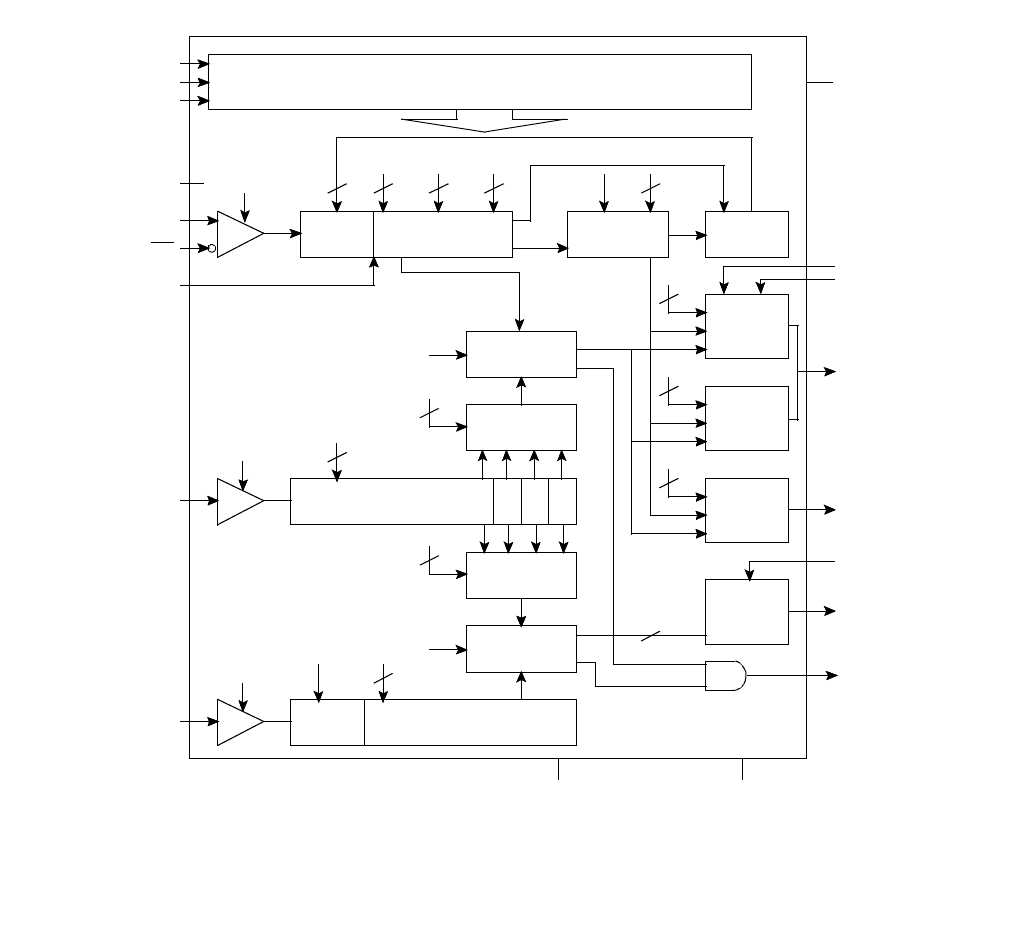
CIRCUIT DESCRIPTION
4-4
June 1997
Part No. 001-3492-001
capacitance that is multiplied. If a noise pulse or other
voltage change appears on the collector, the base volt-
age does not change significantly because of C842.
Therefore, base current does not change and transistor
current remains constant. CR840 decreases the charge
time of C842 when power is turned on. This shortens
the start-up time of the VCO. C840 and C841 are RF
decoupling capacitors.
4.2.6 VCO FREQUENCY SHIFT
The VCO must be capable of producing frequen-
cies from 840-960 MHz to produce the required
receive injection and transmit frequencies. If this
large of a shift was achieved by varying the VCO con-
trol voltage, the VCO gain would be undesirably high.
Therefore, capacitance is switched in and out of the
tank circuit to provide a coarse shift in frequency.
The 928-960 MHz band is divided into two seg-
ments, 928-944 MHz and 944-960 MHz. The band
selection is controlled by shift register U840, digital
transistors Q843/Q844 and pin diode CR820 on the
VCO board.
A frequency shift of 87.85 MHz is required to go
from transmit to receive mode and visa versa. Trans-
mit to receive frequency shift is accomplished by pro-
gramming shift register U840 which drives the digital
transistors Q841/Q842. In Transmit mode, Q841/
Q842 forward bias pin diode CR821 which switches
in an inductive transmission line in parallel with the
VCO resonator causing the VCO frequency to
increase. In Receive mode Q841/Q842 reverse bias
CR821 which switches out the inductive transmission
line and lowers the VCO frequency for the mixer
injection.
Figure 4-2 U800 SYNTHESIZER BLOCK DIAGRAM
CLOCK
DATA
STROBE
Vss
RFIN
RF
IN
64/65/72
PRESCALER MAIN DIVIDERS
EM FB 2 2 12 8
PR NM1 NM3
NM2
FRACTIONAL
ACCUMULATOR
PRESCALER
MODULUS
CONTROL
3
FMOD NF FB
SERIAL INPUT + PROGRAM LATCHES VDD
TEST
IN
REF
EM+EA
REFERENCE DIVIDER +2 +2 +2
MAIN
MAIN
PHASE
DETECTOR
REFERENCE
SELECT
2
SM
EM
REFERENCE
SELECT
2
SA
SECONDARY
PHASE
DETECTOR
EA AUXILIARY
IN
EA
AUX
12
NR
12
NAPA
AUXILIARY DIVIDER
PRESCALER
1/4
NORMAL
OUTPUT
CHARGE
PUMP
OUTPUT
CHARGE
PUMP
SPEED-UP
OUTPUT
CHARGE
PUMP
INTEGRAL
OUTPUT
CHARGE
PUMP
AUXILIARY
CN
8
CL
2
CK
4
2
VSSA
VDDA
LOCK
PHA
RA
PHI
PHP
RN
RF

CIRCUIT DESCRIPTION
4-5
June 1997
Part No. 001-3492-001
4.2.7 SYNTHESIZER INTEGRATED CIRCUIT
(U800)
Introduction
Synthesizer chip U800 is shown in Figure 4-2.
This device contains the following circuits: R (refer-
ence), Fractional-N, NM1, NM2 and NM3; phase and
lock detectors, prescaler and counter programming
circuitry. The basic operation was described in Sec-
tion 4.2.1.
Channel Programming
Frequencies are selected by programming the R,
Fractional-N, NM1, NM2 and NM3 in U800 to divide
by a certain number. These counters are programmed
by Loader board or a user supplied programming cir-
cuit. More information on programming is located in
Section 3.
As previously stated, the counter divide numbers
are chosen so that when the VCO is oscillating on the
correct frequency, the VCO-derived input to the phase
detector is the same frequency as the reference oscilla-
tor-derived frequency.
The VCO frequency is divided by the internal
prescaler and the main divider to produce the input to
the phase detector.
4.2.8 LOCK DETECT
When the synthesizer is locked on frequency, the
SYNTH LOCK output of U800, pin 18 (J201, pin 7) is
3V. When the synthesizer is unlocked, the output is a
less than 1V. Lock is defined as a phase difference of
less than 1 cycle of the TCXO.
4.3 RECEIVER CIRCUIT DESCRIPTION
4.3.1 CERAMIC FILTER, RF AMPLIFIER
Capacitor C200 couples the receive signal from
the antenna switch to ceramic filter Z200. (The
antenna switch is described in Section 4.4.3.) Z200 is
a bandpass filter that passes only a narrow band of fre-
quencies to the receiver. This attenuates the image
and other unwanted frequencies.
Impedance matching between the Z200 and RF
amplifier Q201 is provided by C201, C203 and L200.
CR200 protects the base-emitter junction of Q201
from excessive negative voltages that may occur dur-
ing high signal conditions. Q200 is a switched con-
stant current source which provides a base bias for
Q201. Q200 base bias is provided by R200/R201.
Current flows through R202 so that the voltage across
it equals the voltage across R200 (minus the base/
emitter drop of Q200). In the transmit mode the
receive +9.6V is removed and Q200 is off. This
removes the bias from Q201 and disables the RF
amplifier in transmit mode. This prevents noise and
RF from being amplified by Q201 and fed back on the
first injection line.
Additional filtering of the receive signal is pro-
vided by Z201. L201 and C206 provide impedance
matching between Q201 and Z201. Resistor R205 is
used to lower the Q of L201 to make it less frequency
selective.
4.3.2 MIXER
First mixer Q211 mixes the receive frequency
with the first injection frequency to produce the
87.85 MHz first IF. Since low-side injection is used,
the injection frequency is 87.85 MHz below the
receive frequency. The RF signal is coupled to the
mixer through C211. L212 and C214 tune the mixer
output to 87.85. R214 lowers the Q of L212.
4.3.3 FIRST LO AMPLIFIER
The first injection frequency from the VCO is
coupled to the First Local Oscillator (LO) amplifier
Q260/Q261 through C266. L261/C265 match Q260
to the VCO.
Q261 is a switched constant current source which
provides a base bias for Q260. Q261 base bias is pro-
vided by R264/R265. Current flows through R263 so
that the voltage across it equals the voltage across
R264 (minus the base/emitter drop of Q261). In the
transmit mode the receive +9.6V is removed and
Q261 is off. This removes the bias from Q260 and
disables the First LO amplifier in transmit mode.
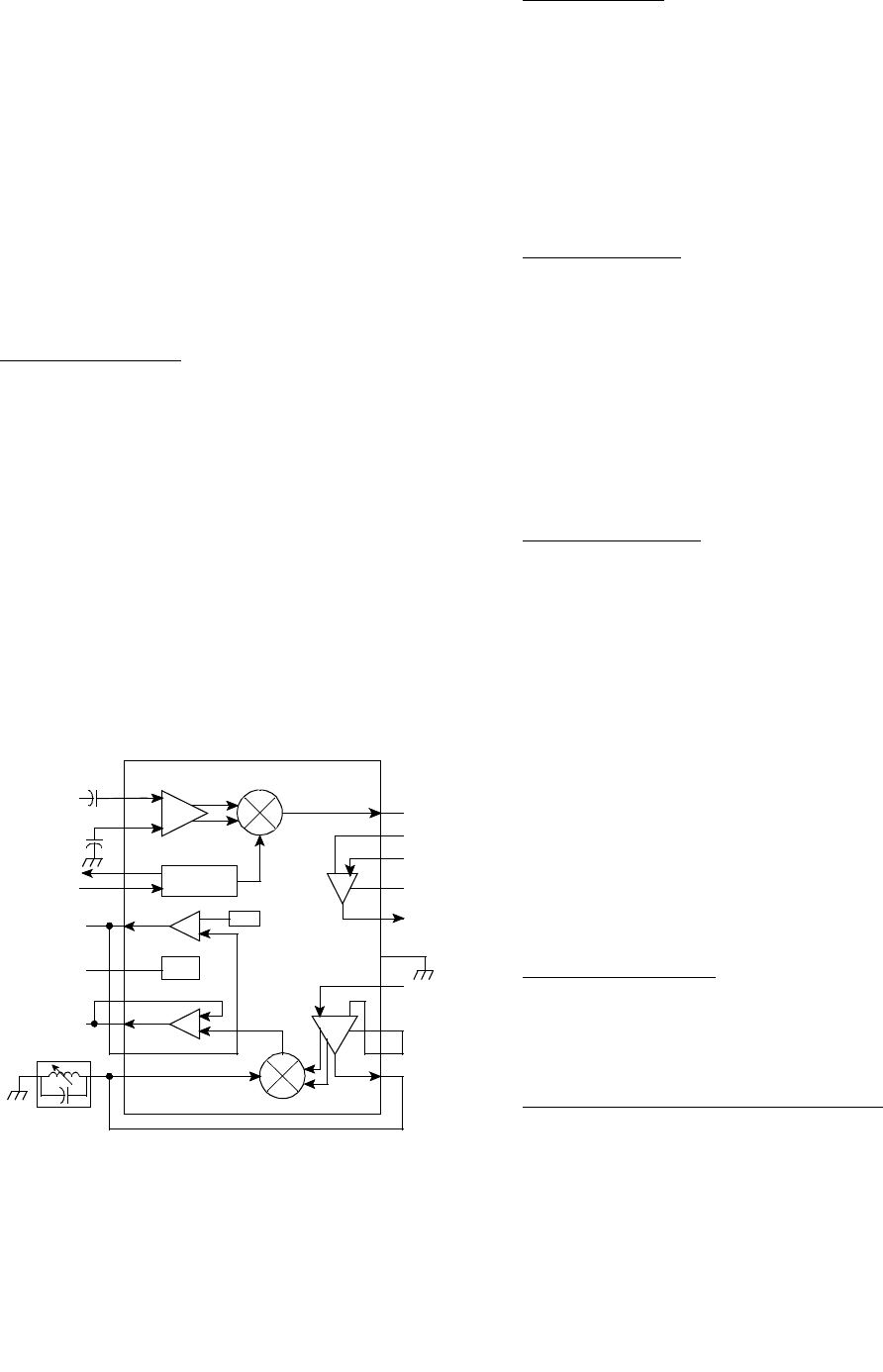
CIRCUIT DESCRIPTION
4-6
June 1997
Part No. 001-3492-001
4.3.4 CRYSTAL FILTER, FIRST IF SECTION
Z220 and Z221 form a 2-section, 4-pole crystal
filter with a center frequency of 87.85 MHz and a
-3 dB passband of 8 kHz (12.5 kHz BW) or 15 kHz
(25 kHz BW). This filter establishes the receiver
selectivity by attenuating the adjacent channel and
other signals close to the receive frequency. C223,
C224, and L221 adjust the coupling of the filter.
L222, C226, C227 and R223 provide impedance
matching between the filter and U230.
4.3.5 SECOND LO/MIXER/DETECTOR
Oscillator and Mixer
As shown in Figure 4-3, U230 contains the sec-
ond oscillator, second mixer, limiter, detector, and
squelch circuitry. The control line from synthesizer
U800 is on U230, pin 4. R250/C252/CR240 stabilize
the base current of the oscillator control line. C243/
C245 provide the feedback for the Colpitts oscillator.
The 87.4 MHz output of the oscillator is on U230, pin
3 and is coupled to buffer Q240. Bias for Q240 is pro-
vided by R242/R243/R245. The output of Q240 is
coupled to the auxiliary input of U800, pin 10 to main-
tain the control line. The 87.85 MHz IF signal is
mixed with the 87.4 MHz second LO to produce the
450 kHz Second IF.
Figure 4-3 U230 BLOCK DIAGRAM
Second IF Filter
The output of the internal double-balanced mixer
is the difference between 87.85 MHz and 87.4 MHz
which is 450 kHz. This 450 kHz signal is fed out on
pin 20 and applied to second IF filters Z230 and Z231.
These filters have passbands of 9 kHz (12.5 kHz BW),
or 20 kHz (25 kHz BW) at the -6 dB points and are
used to attenuate wideband noise.
Limiter-Amplifier
The output of Z230/Z231 is applied to a limiter-
amplifier circuit in U230. This circuit amplifies the
450 kHz signal and any noise present; then limits this
signal to a specific value. When the 450 kHz signal
level is high, noise pulses tend to get clipped off by
the limiter; however, when the 450 kHz signal level is
low, the noise passes through the limiter. C233/C234
decouple the 450 kHz signal.
Quadrature Detector
From the limiter stage the signal is fed to the
quadrature detector. An external phase-shift network
connected to U230, pin 10 shifts the phase of one of
the detector inputs 90° at 450 kHz (all other inputs are
unshifted in phase). When modulation occurs, the fre-
quency of the IF signal changes at an audio rate as
does the phase of the shifted input. The detector,
which has no output with a 90° phase shift, converts
this phase shift into an audio signal. L230 is tuned to
provide maximum undistorted output from the detec-
tor. R232 is used to lower the Q of L230. From the
detector the audio and data signal is fed out on pin 8.
The audio/data output of U230, pin 8 is applied to
J201, pin 13.
Audio/Data Amplifier
The audio/data output of U230, pin 8 is applied
to J201, pin 13.
Receive Signal Strength Indicator (RSSI)
U230, pin 5 is an output for the RSSI circuit
which provides a voltage proportional to the strength
of the 450 kHz IF signal. The RSSI voltage is applied
to J201, pin 12.
1
2
4
MIXER
5
15
14
11
RSSI
87.85 MHz
C228
C237
20
OSCILLATOR
87.4 MHz
+
-
RSSI OUTPUT
9
VREG
6
VCC
7
8
+
-
10
QUAD
AUDIO OUTPUT
L230
12
13
3
CONTROL
LIMITER IN
LIMITER
IF AMP OUT
IF DEC1
IF DEC2
IF AMP IN
MIXER OUT
LIMITER DEC1
LIMITER DEC2
LIMITER OUT
IF AMP
16
17
18
19
RSSI FB
AUDIO FB

CIRCUIT DESCRIPTION
4-7
June 1997
Part No. 001-3492-001
4.4 TRANSMITTER CIRCUIT DESCRIPTION
4.4.1 DRIVER
The VCO RF output signal is applied to R846,
R847 and R848 that form a resistive splitter for the
receive first local oscillator and the transmitter. The
VCO signal is then applied to a 50 ohm pad formed by
R500, R501, and R502. This pad provides attenuation
and isolation. Q500 provides amplification and addi-
tional isolation between the VCO and transmitter.
Biasing for this stage is provided by R503 and R504,
and decoupling of RF signals is provided by C504.
Impedance matching to the power amplifier is pro-
vided by L500/C505.
4.4.2 FINAL, COMPARATOR
RF module U510 has an RF output of 1 to 5W
and operates on an input voltage from 10-16V.
Power control is provided by U520, U130, Q520
and a stripline directional coupler. The power is
adjusted by Power Set Control of U900 that provides a
reference voltage to U130C. U130C drives Q520 and
PA module U510 when using the DAC. When not
using the DAC, the set voltage is applied through
U902, pin 2.
One end of the stripline directional coupler is
connected to a forward RF peak detector formed by
R535, CR530, C531 and U520A. The other end of the
stripline directional coupler is connected to a reverse
RF peak detector formed by R537, CR531, C534 and
U520B.
If the power output of U510 decreases due to
temperature variations, etc., the forward peak detector
voltage drops. This detector voltage drop is buffered
by U520A and applied to inverting amplifier U130C
which increases the forward bias on Q520. The
increase on Q520 increases the power output level of
U510. If the power output of U510 increases, the for-
ward peak detector voltage increases and U130C
decreases the forward bias on Q520. The decrease on
Q520 decreases the output power of U510.
The output of CR530 and CR531 are fed to
U520A/B respectively. If the output of either buffer
increases, the increase is applied to the inverting input
of U130C. The output of U130C then decreases and
Q520 decreases the input voltage to U510 to lower the
power. The control voltage is isolated from RF by fer-
rite bead EP510 and C511 decouples RF.
The forward/reverse power voltages from
U520A/B are also applied to U901 for Diagnostic out-
puts on J201, pin 14.
The low-pass filter consists of C541, L540,
C542, L541, C543, L542 and C544. The filter attenu-
ates spurious frequencies occurring above the transmit
frequency band. The transmit signal is then fed
through the antenna switch to antenna jack J501.
4.4.3 ANTENNA SWITCH
The antenna switching circuit switches the
antenna to the receiver in the receive mode and the
transmitter in the transmit mode. In the transmit
mode, +9V is applied to L543 and current flows
through diode CR540, L544, diode CR541, and R540.
When a diode is forward biased, it presents a low
impedance to the RF signal; conversely, when it is
reverse biased (or not conducting), it presents a high
impedance (small capacitance). Therefore, when
CR540 is forward biased, the transmit signal has a
low-impedance path to the antenna through coupling
capacitor C546.
L544 and C552 form a discrete quarter- wave
line. When CR541 is forward biased, this quarter-
wave line is effectively AC grounded on one end by
C552. When a quarter-wave line is grounded on one
end, the other end presents a high impedance to the
quarter-wave frequency. This blocks the transmit sig-
nal from the receiver. C545/C546 matches the
antenna to 50 ohms in transmit and receive.
4.4.4 TRANSMIT KEY-UP CONTROL
When 3-16V is applied to J201, pin 3 (TX_EN)
is applied to the base of Q133 it turns the transistor on
and causes the collector to go low. This low is on the
base of Q134 and turns the transistor on to apply
+5.5V to U130A, pin 2. C130 and C131 decouple RF.
The +5.5V from Q134 is divided by R132/R133 to
produce a +3.6V reference on U130A, pin 3. C136,
C137, C138 and C139 provide RF decoupling.

CIRCUIT DESCRIPTION
4-8
June 1997
Part No. 001-3492-001
Q130, Q131 and Q132 act as switches that turn
on with the RX_EN line. When J201, pin 4 goes low,
Q130 is turned off, which turns on Q131 that turns on
Q132. This applies +13.3V to U130 before the
TX_EN line on J201, pin 3 goes high.
U130B provides the key-up/key-down condition-
ing circuit. C141/R137 provide a ramp up/ramp down
of the +9V TX during key-up/key-down which
reduces load pull of the VCO during key-up.
The output on U130B, pin 7 is applied to the non-
inverting input of comparator U130D, pin 12. The
output of U130D, pin 14 is applied to the base of cur-
rent source Q135. The output of Q135 is on the emit-
ter and is applied back to the inverting input of com-
parator U130D, pin 13. A decrease or increase at
U130D, pin 13 causes a correction by U130D to stabi-
lize the +9V transmit output. R140/R141 establishes
the reference voltage on U130D, pin 13. C144 pro-
vides RF bypass, C143 provides RF decoupling and
C145 stabilizes the output. The +9V transmit voltage
is then distributed to the circuits.
4.5 VOLTAGE REGULATORS
4.5.1 +9.6 AND +5.5V REGULATED
The +3-16V applied on J201, pin 5 is applied to
the base of Q110 turning the transistor on. This
causes the collector to go low and applies a low to the
control line of U110, pin 2 and R110 provides supply
voltage isolation. The +13.3V from J201, pin 2 is on
U110, pin 6 to produce a +5.5V reference output on
U110, pin 4. C110 stabilizes the voltage and C114/
C111 provide RF decoupling. C117 provides RF
bypass and C123 provides RF decoupling. C119
helps to stabilize the voltage when the +5.5V supply
first turned on.
The low from the collector of Q110 is also
applied to the control line of U111, pin 2. The +13.3V
from J201, pin 2 is on U111, pin 6 to produce a +9.6V
output on U111, pin 4. C118 provides RF bypass and
C122 provides RF decoupling. C120 helps to stabilize
the voltage when the +9.6V supply first turned on.

5-1
June 1997
Part No. 001-3492-001
SECTION 5 SERVICING
5.1 GENERAL
5.1.1 PERIODIC CHECKS
This transceiver should be put on a regular main-
tenance schedule and an accurate performance record
maintained. Important checks are receiver sensitivity
and transmitter frequency, modulation, and power out-
put. A procedure for these and other tests is located in
Section 6. It is recommended that transceiver perfor-
mance be checked annually even though periodic
checks are not required by the FCC. During the first
year, make an additional check or two to ensure no
TCXO frequency drifting has occurred.
5.1.2 SURFACE-MOUNTED COMPONENTS
A large number of the components used on the
transceiver board are the surface-mounted type. Since
these components are relatively small in size and are
soldered directly to the PC board, care must be used
when they are replaced to prevent damage to the com-
ponent or PC board. Surface-mounted components
should not be reused because they may be damaged by
the unsoldering process.
5.1.3 SCHEMATIC DIAGRAMS AND COMPO-
NENT LAYOUTS
Schematic diagrams and component layouts of
the PC boards used in this transceiver are located in
Section 8. A component locator guide is also pro-
vided to aid in component location.
5.1.4 REPLACEMENT PARTS LIST
A replacement parts list with all the parts used in
this transceiver is located in Section 7. Parts are listed
alphanumerically according to designator. For infor-
mation on ordering parts, refer to Section 1.8.
5.1.5 TCXO MODULE NOT SERVICEABLE
The ±1.5 PPM TCXO module is not field ser-
viceable. Part changes require a factory recalibration
to ensure that the oscillator stays within its ±1.5 PPM
tolerance.
5.2 SYNTHESIZER SERVICING
5.2.1 INTRODUCTION
When there is a synthesizer malfunction, the
VCO is not locked on frequency. When an unlocked
VCO is detected by the lock detector circuit, U800,
pin 18 goes low (0V).
NOTE: The user-supplied circuitry must disable the
transmitter and receiver when an out-of-lock condi-
tion is indicated.
When the VCO is unlocked, the fR and fV inputs
to the phase detector are usually not in phase (see Sec-
tion 4.1.2). The phase detector in U800 then causes
the VCO control voltage to go to the high or low end
of its operating range. This in turn causes the VCO to
oscillate at the high or low end of its frequency range.
As shown in Figure 4-1, a loop is formed by
VCO Q820, amplifier Q821/Q822, and the RF IN of
U800. Therefore, if any of these components begin to
malfunction, improper signals appear throughout the
loop. However, correct operation of the counters can
still be verified by measuring the input and output fre-
quencies to check the divide number.
Proceed as follows to check the synthesizer I/O
signals to determine if it is operating properly.
5.2.2 REFERENCE OSCILLATOR
Check the signal at U800, pin 8. It should be
17.5 MHz at a level of approximately 0.5V P-P. If the
TCXO module is defective, it is not serviceable and
must be replaced with a new module as described in
Section 5.1.5.
5.2.3 VCO
Output Level
The output level of Q823 can be measured with
an RF voltmeter or some other type of high impedance
meter. The minimum level after a power splitter at
R846 should be -3 dBm.
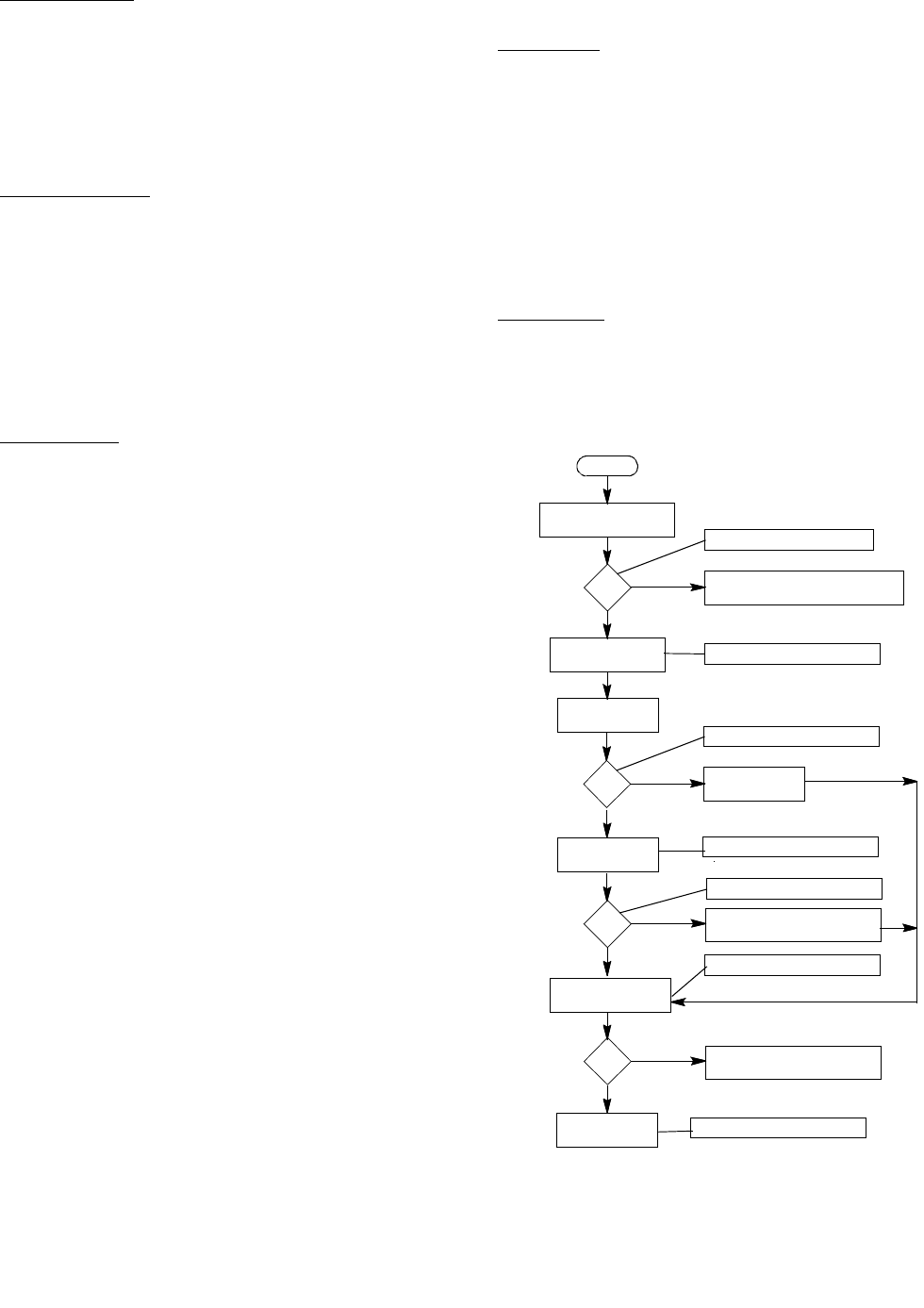
SERVICING
5-2
June 1997
Part No. 001-3492-001
Control Voltage
Check the DC voltage at C815 with a channel
near the center of the band. If the VCO is locked on
frequency, this should be a steady DC voltage near
3V. If it is not locked on frequency, it should be near
the lower or upper end of its range (0V or 5.5V).
Output Frequency
Check the VCO frequency at R841. If the VCO
is locked on frequency, it should be stable on the
transmit channel frequency. If the VCO is not locked
on frequency, the VCO control voltage is probably
near 0V or 5.5V.
5.2.4 SYNTHESIZER (U800)
Lock Detector
When the VCO is locked on frequency, the lock
detect output on J201, pin 7 should be high.
5.3 RECEIVER SERVICING
To isolate a receiver problem to a specific sec-
tion, refer to the troubleshooting flowchart in Figure
5-1. Tests referenced in the flowchart are described in
the following information.
NOTE: Supply voltages are provided by the user.
5.3.1 SUPPLY VOLTAGES AND CURRENT
Measure the supply voltages on the following
pins at interface connector J201:
Pin 4 - 3-16V DC Receive
Pin 5 - 3-16V DC
Place a DC ammeter in the supply line to the
transceiver and the following maximum currents
should be measured:
Pin 4 - 400 µA
Pin 5 - 400 µA
5.3.2 MIXER/DETECTOR
Data Output
Using a .01 µF coupling capacitor, inject a
87.85 MHz, 1 mV signal, modulated with 1 kHz at
±3 kHz deviation (for 25 kHz radios) ±1.5 kHz (for
12.5 kHz radios) at U230, pin 1. The signal output at
U230, pin 8 should be approximately 150 mV P-P.
NOTE: This signal consists of the 1 kHz modulation
and harmonics of 450 kHz.
RSSI Output
The RSSI output on J201, pin 12 should be <900
mV DC with no signal applied, and >1.8V DC with a
1 mV input signal.
Figure 5-1 RECEIVER SERVICING
START
MEASURE CURRENT
OK
?
OK
?
NO
YES
YES
NO
REFER TO SECTION 5.3.2
CHECK FUSES AND
WIRE HARNESS CONNECTIONS
REFER TO SECTION 5.3
AND VOLTAGES
CHECK DATA
OUTPUT
REFER TO SECTION 5.3.2
CHECK
CHECK AUDIO
OK
?
YES
NO
OK
?
YES
NO
CHECK MIXER/
DETECT CIRCUIT
U230
CIRCUIT REFER TO SECTION 5.3.4
REFER TO SECTION 5.3.3
REPLACE DEFECTIVE
COMPONENT
REFER TO SECTION 5.3.5
CHECK BUFFERS
CRYSTAL FILTERS
REPAIR DEFECTIVE
STAGE
CHECK RF AMP
FIRST MIXER REFER TO SECTION 5.3.6

SERVICING
5-3
June 1997
Part No. 001-3492-001
5.3.3 SECOND LO
Verify that the Second LO signal is present at
R245. The Second LO should be at 87.40 MHz and
not less than 250 mV P-P.
5.3.4 AUDIO BUFFER AMP
The Data output on J201, pin 13 should be 100-
200 mV RMS, with the preceding injection signal. If
these levels are not correct, verify proper adjustment
of L230 (see Section 6.7). The gain of U230 is 2.8 for
25 kHz radios and 5.8 for 12.5 kHz radios.
5.3.5 CRYSTAL FILTERS
The 87.85 MHz IF signal is provided to the crys-
tal filters Z220/Z221.
5.3.6 MIXER
The mixer converts the RF signal (928-960 MHz)
to 87.85 MHz. The Local Oscillator is provided by
the VCO and Q260/Q261. The level of the LO should
be approximately +3 dBm.
5.3.7 LOW NOISE AMPLIFIER (LNA)
The LNA provides approximately 12 dB of gain
at 928-960 MHz. Q200 provides active bias to Q201.
5.3.8 ANTENNA SWITCH
CR540, CR541, L544, C551 and C552 form a
Pi-network antenna switch. CR540 and CR541 are
reversed biased in Receive Mode.
5.4 TRANSMITTER SERVICING
5.4.1 SUPPLY VOLTAGES AND CURRENT
Measure the supply voltages on the following
pins of interface connector J201:
Pin 2 - 13.3V DC nominal
Pin 3 - 3-16V DC
Pin 4 - 0.0V DC (while transmitting)
Pin 5 - 3-16V DC
Pin 6 - 2.5V DC ±1%/1.5V P-P max
Place a DC ammeter in the supply line to the
transceiver and the following maximum currents
should be measured:
Pin 2 - 2.5A maximum
Pin 3 - 400 µA
Pin 5 - 400 µA
5.4.2 VCO
1. Check VCO after power splitter for power output.
(Power output should be at least -3 dBm.)
2. Check 9V Transmit (Q135, emitter).
3. If 9V is not present check Q133/Q134, U130, Q135,
Q130, Q131 and Q132 (see Section 4.4.4).
4. Check voltages on Driver Q500.
Input = 1.5V DC
Output = 3.5V DC
Power output should be at least 2 mW (+3 dBm) at
C506 (50 ohm point).
5.4.3 FINAL AMPLIFIER
1. Check the voltages on U510.
Pin 2 = 9V DC
Pin 3 = 5.0V DC (varies with power setting)
Pin 4 = 13.3V DC
Power output at C540 should be 7.5-8.0W (+38.7 to
+39 dBm).
5.4.4 ANTENNA SWITCH
1. Check the antenna switch voltages.
CR540 = 8.6V DC
CR541 = 8.0V DC
The loss through the Antenna Switch should be 1.9
to 2.1 dB.
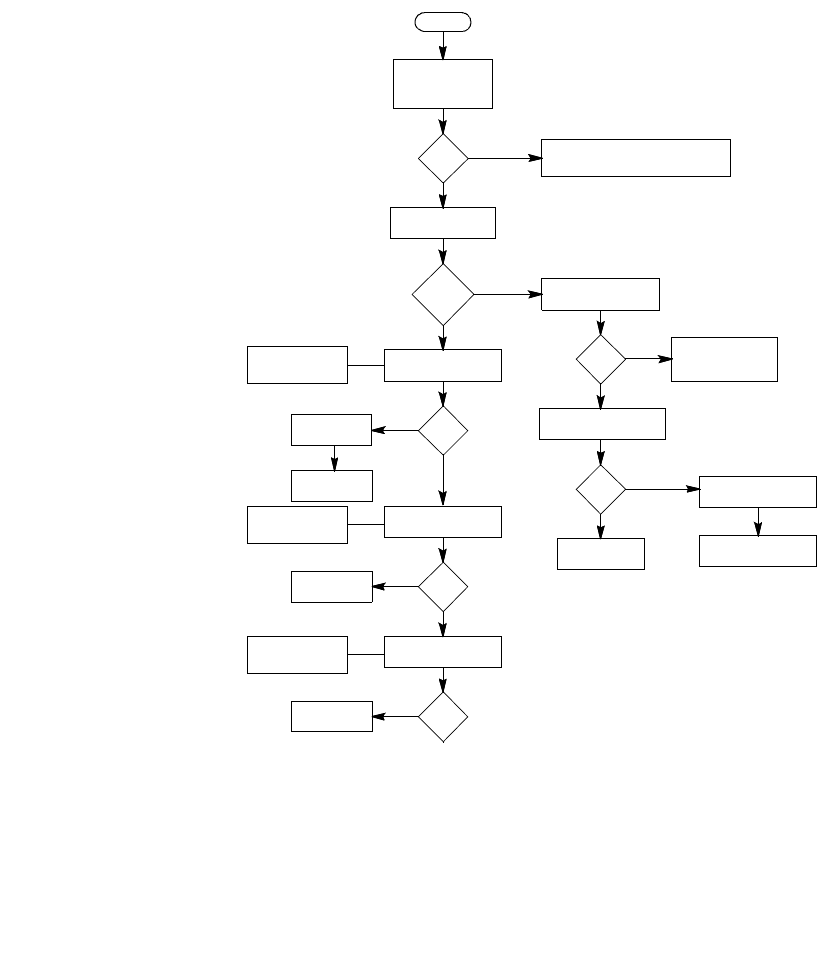
SERVICING
5-4
June 1997
Part No. 001-3492-001
5.4.5 MODULATION INPUT
1. Check for audio/data signals at J201, pin 6, Y800,
pin 1 and A840, pin 3.
5.4.6 TCXO
1. Check Y800, pin 1 for 2.5V DC ±1%.
2. Adjust Y800 to set the transmitter to the frequency
of operation.
3. If the frequency cannot be set to the frequency of
operation, replace the TCXO.
Figure 5-2 TRANSMITTER SERVICING
START
MEASURE
CURRENT AND
OK
?
NO
YES
MEASURE RF
WATTS
?
CHECK DEVIATION
TRANSMITTER
OK
OK
?
OK
?
NO
NO
NO
YES
YES
YES
WIRE HARNESS CONNECTIONS
CHECK FUSES AND
CHECK AUDIO
CHECK TCXO
ADJUST OR
CHANGE TCXO
OFF FREQ
5
VOLTAGES
OUTPUT POWER
(SECTION 5.4.6)
CIRCUITS
CHECK FREQUENCY
(SECTION 5.4.7)
Y800
CHECK Q500
CHECK DRIVER
OK
?
NO
YES
CHECK A840
REFER TO
SECTION 5.4.2
OK
?
NO
YES
REFER TO CHECK
POWER MODULE
SECTION 5.4.4
CHECK U510
OK
?
NO
REFER TO CHECK
ANTENNA SWITCH
SECTION 5.4.5
CHECK
CR540/541

6-1
June 1997
Part No. 001-3492-001
SECTION 6 ALIGNMENT PROCEDURE
6.1 GENERAL
Receiver or transmitter alignment may be neces-
sary if repairs are made that could affect tuning.
Alignment points diagrams are located in Figure 6-5
or component layouts are located in Section 8.
Fabricate test cables by referring to Figure 2-1.
This cable should include power and ground, a trans-
mit keying switch that shorts the keying line to
ground, data input and data output. The test setup
must apply the various supply voltages and load the
synthesizer with channel information.
6.2 TEST EQUIPMENT
lModulation Analyzer, HP8901 or equivalent
lRF Signal Generator, HP8656 or equivalent
lFrequency Counter and "sniffer" probe
lPower Meter
lOscilloscope
lDigital Multimeter
l20 dB Attenuator
lPower Supply, HP8264A or equivalent
lAudio Analyzer, HP8903A or equivalent
lMisc. cables, connectors, attenuators.
l
6.3 INITIAL SETTINGS
1. Adjust power supply voltage to +13.3V DC.
2. Turn off the power supply.
3. Connect RF and power cables.
4. Turn on the power supply.
5. Using a DC voltmeter, monitor the DC voltage at
the junction of R812/R814 (wiper of R814), refer to
Figure 6-5.
6. Adjust R814 to 2.1V DC ±0.05V.
7. Verify the bias voltage at J201, pin 6 is +2.5V DC
±0.05V.
6.4 VCO CONTROL VOLTAGE
1. Connect the test setup shown in Figure 6-1.
2. Adjust R525 fully counterclockwise.
3. Load the synthesizer with the HIGHEST channel
frequency in the band.
4. Key the transmitter.
5. Verify the voltage at TP800 is < 5V DC.
6. Unkey the transmitter.
7. Load the synthesizer with the LOWEST channel
frequency in the band.
8. Key the transmitter.
9. Verify the voltage at TP800 is > 1V DC.
10.Unkey the transmitter.
6.5 TRANSMITTER AND FREQUENCY
NOTE: If the radio is intended to use Diagnostics or is
a Radio/Loader board combination go to Section 6.6.
1. Connect the test setup shown in Figure 6-1.
2. Load the synthesizer with a channel frequency in
the MIDDLE of the band.
3. Key the transmitter.
4. The voltage at J201, pin 2 should be 13.3V DC.
(Do not transmit for extended periods.)
5. Adjust R525 clockwise for 5.0W ±1W. Adjust volt-
age and power if necessary.
6. Check the power at a channel frequency on the
LOW and HIGH ends of the band. The power out-
put should be 4-6W with current less than 2.5A.
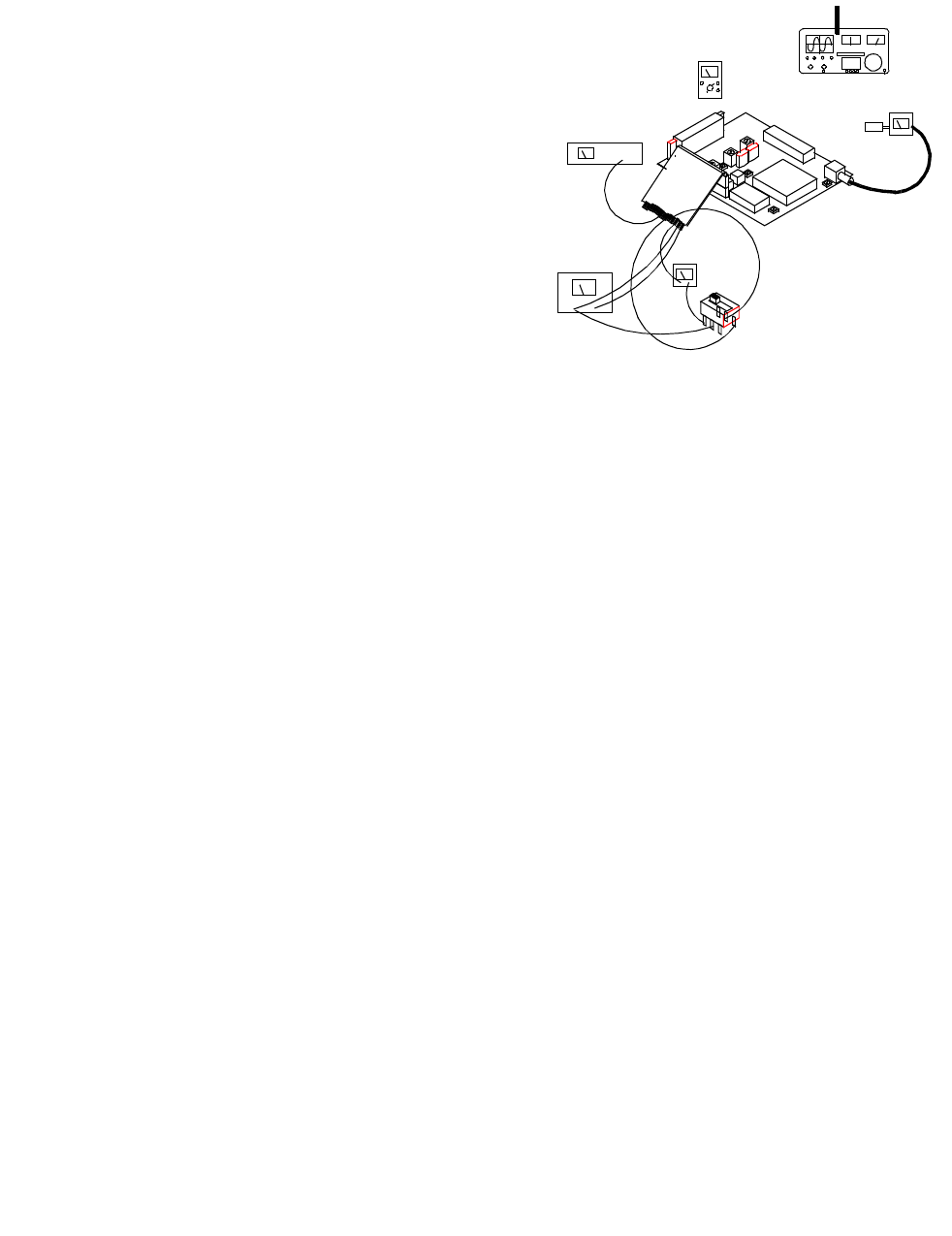
ALIGNMENT PROCEDURE
6-2
June 1997
Part No. 001-3492-001
6.5.1 MODULATION ALIGNMENT
1. Apply a 1V, 100 Hz square-wave to J201, pin 6.
2. Transmit into the modulation analyzer and observe
modulation output on the oscilloscope. Set the
modulation analyzer high pass filtering OFF and no
less than a 15 kHz low pass filter.
3. Preset R818 to the center position.
4. Load the synthesizer with a channel frequency at
the MIDDLE of the band.
5. Adjust R818 for a flat square wave.
6. Apply a 100 Hz sine-wave to J201, pin 6. The mod-
ulation analyzer should still have the 15 kHz low-
pass filter selected.
7. Adjust the audio analyzer output level to achieve a
transmit deviation of:
1.5 kHz for 12.5 kHz BW radios
3.0 kHz for 25 kHz BW radios
8. Load the synthesizer with a channel frequency at
the LOW end of the band.
9. Input a 100 Hz sine-wave and set a 0 dB reference
on the Modulation Analyzer.
10.Apply a 1 kHz sine-wave. The level should be
within ±2 dB of the reference at 100 Hz.
11.Load the synthesizer with a channel frequency in
the MIDDLE of the band.
12.Input a 100 Hz sine-wave and set a 0 dB reference
on the Modulation Analyzer.
13.Apply a 1 kHz sine-wave. The level should be
within ±2 dB of the reference at 100 Hz.
14.Load the synthesizer with a channel frequency in
the HIGH end of the band.
15.Input a 100 Hz sine-wave and set a 0 dB reference
on the Modulation Analyzer.
16.Apply a 1 kHz sine-wave. The level should be
within ±2 dB of the reference at 100 Hz.
17.Unkey the transmitter.
Figure 6-1 TRANSMITTER TEST SETUP
6.6 TRANSMITTER/FREQUENCY WITH
LOADER
NOTE: If the radio is not intended to use Diagnostics
go to Section 6.5.
NOTE: Subtract the current drawn by the Test Loader
or any Interface Units from all measurements.
1. Set the Diagnostic Enable DAC (DAC4) to 255,
(FFh).
2. Select a Transmit channel frequency in the MID-
DLE of the band. Make sure voltage at J201, pin 2
is 13.3V DC.
3. Adjust R535 fully clockwise for maximum power
output.
4. Adjust the Power Adjust DAC setting (DAC1) to
set the power output to 5W ±0.3W. Make sure volt-
age at J201, pin 2 is 13.3V DC.
5. Adjust voltage and power if necessary.
POWER SUPPLY
+7.5V DC
TX
RX
VOLTMETER
DC
+
-
WATTMETER5W, 50 OHM
DUMMY LOAD
COMMUNICATIONS
SERVICE MONITOR
0-1.5A
DC AMMETER
+-
ANALYZER
MODULATION
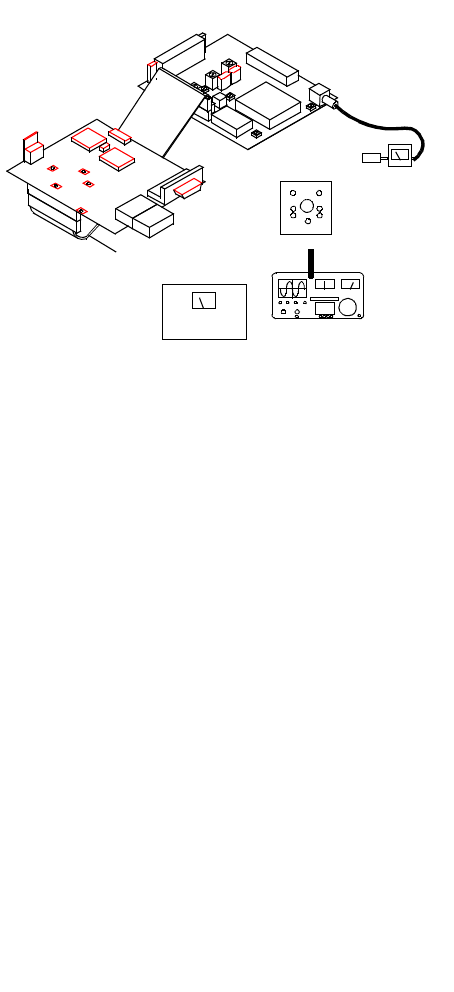
ALIGNMENT PROCEDURE
6-3
June 1997
Part No. 001-3492-001
6. Repeat Step 5 for channels on the LOW and HIGH
ends of the band.
7. Power output should be 4.7-5.3W (50% duty cycle)
and current should be less than 2.5A.
8. Select a Transmit channel frequency in the MID-
DLE of the band
9. Adjust the frequency displayed on the Modulation
Analyzer to the desired channel frequency by
adjusting the TCXO (Y801).
6.6.1 MODULATION ADJUSTMENT
1. Apply a 1V, 100 Hz square wave to J201, pin 6.
2. Transmit into the modulation analyzer and observe
modulation output on the oscilloscope. The modu-
lation analyzer should not have any high pass filter-
ing selected and no less than a 15 kHz low pass
filter.
3. Select a Transmit channel frequency in the MID-
DLE of the band. The DAC value should be "125".
4. If the square wave is peaked on the edges, adjust
R818 down in value for the flattest square wave.
5. Repeat Steps 3 and 4 for channels on the LOW and
HIGH ends of the band.
6. Input a 100 Hz sinewave to J201, pin 6. The mod-
ulation analyzer should still have the 15 kHz low
pass filter selected.
7. Adjust the audio analyzer output level to achieve a
transmit deviation of:
1.5 kHz for 12.5 kHz radios or
3 kHz for 25 kHz radios.
8. Select a Transmit channel frequency at the LOW
end of the band.
9. Input a 100 Hz sine-wave and set a 0 dB reference
on the Modulation Analyzer.
10.Apply a 1 kHz sine-wave. The level should be
within ±2 dB of the reference at 100 Hz.
11.Select a Transmit channel frequency in the MID-
DLE of the band.
12.Input a 100 Hz sine-wave and set a 0 dB reference
on the Modulation Analyzer.
13.Apply a 1 kHz sine-wave. The level should be
within ±2 dB of the reference at 100 Hz.
14. Select a Transmit channel frequency in the HIGH
end of the band.
15.Input a 100 Hz sine-wave and set a 0 dB reference
on the Modulation Analyzer.
16.Apply a 1 kHz sine-wave. The level should be
within ±2 dB of the reference at 100 Hz.
17.Unkey the transmitter.
Figure 6-2 TX WITH LOADER TEST SETUP
6.7 RECEIVER
C A U T I O N
Do not key the transmitter with the generator con-
nected because severe generator damage may result.
NOTE: All distortion and SINAD measurements are
performed with psophometric audio filtering.
1. Connect the test setup shown in Figure 6-3.
2. Preset tuning slugs of L212 and L222 flush with the
top of the can.
3. Preset C223 to the center position (slot in-line with
axis of the part).
4. Re-adjust L212 and L222 clockwise 2 turns.
POWER SUPPLY
+7.5V DC
+-COMMUNICATIONS
SERVICE MONITOR
OSCILLOSCOPE WATTMETER
5W, 50 OHM
DUMMY LOAD
TEST
CABLE
J201 J102
J104
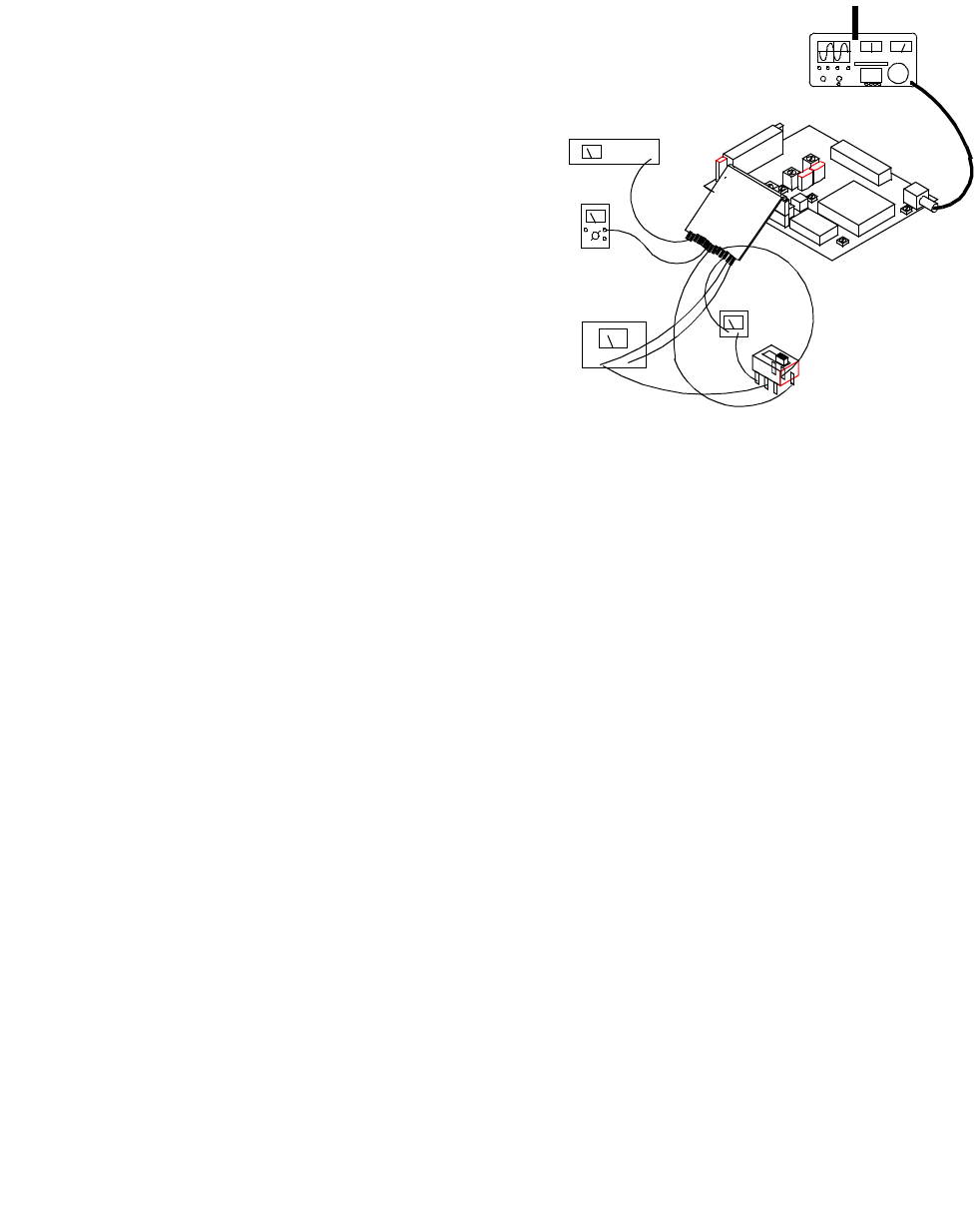
ALIGNMENT PROCEDURE
6-4
June 1997
Part No. 001-3492-001
5. Load the synthesizer with a receive channel fre-
quency at the MIDDLE of the band.
6. Apply a -47 dBm signal from the RF signal genertor
to J501 on the radio. Adjust deviation for:
1.5 kHz with 1 kHz tone for 12.5 kHz radios
3 kHz with 1 kHz tone for 25 kHz radios.
NOTE: Maintain these deviation levels throughout the
test when measuring AC levels, SINAD and % distor-
tion, unless otherwise instructed.
7. Preset L230 for 2.5V DC ±0.05V at J201, pin 13.
8. Set RF signal generator to -105 dBm, unmodulated.
9. Set generator frequency to :
3 kHz below channel center on 12.5 kHz radios
5 kHz below channel center on 25 kHz radios
10.Adjust C223 (first) and L212 for peak RSSI voltage.
(Use 2V scale on DVM.)
11.Apply a -47 dBm signal from the RF signal genera-
tor to J501 on the radio with standard deviation lev-
els.
12.Adjust L222 for minimum distortion (psophometri-
cally weighted).
13.Set RF signal generator to -105 dBm, unmodulated.
14.Adjust L212 for peak RSSI voltage. (Use 2V scale
on DVM.)
15.Apply a -47 dBm signal from the RF signal genera-
tor to J501 on the radio with standard deviation lev-
els.
16.Adjust L230 for maximum receive audio voltage.
17.Verify that the receive audio RMS voltage is
150 mV ±50 mV.
18.Verify that the receive audio DC voltage is
2.5V ±0.3V.
19.Measure the % distortion
(spec is <3% psophometrically weighted).
20.Adjust the amplitude of the RF signal generator on
J501 until an 12 dB SINAD level (psophometrically
weighted) is reached.
21.Measure the 12 dB SINAD sensitivity. The RF
input level should be less than -116 dBm (0.35 µV).
Figure 6-3 RECEIVER TEST SETUP
22.Load the synthesizer with a receive channel fre-
quency to the LOW end of the band.
23.Verify the RF generator amplitude level is less than
-116 dBm at 12 dB SINAD.
24.Load the synthesizer with a receive channel fre-
quency to the HIGH end of the band.
25.Verify the RF generator amplitude level is less than
-116 dBm at 12 dB SINAD.
26.Adjust generator RF level to -120 dBm and measure
DC (RSSI) voltage on J201, pin 12 of the radio
(spec is less than or equal to 0.90V DC).
27.Adjust generator RF level to -120 dBm and measure
DC (RSSI) voltage on J201, pin 12 of the radio
(spec is less than or equal to 0.8V DC).
28.Adjust generator RF level to -60 dBm and measure
DC (RSSI) voltage on J201, pin 12 of the radio
(spec is greater than or equal to 1.7V DC).
POWER SUPPLY
TX
RX
VOLTMETER
DC
+
-
COMMUNICATIONS
SERVICE MONITOR
DC AMMETER
+-
ANALYZER
MODULATION
+13.3V DC 0-3A
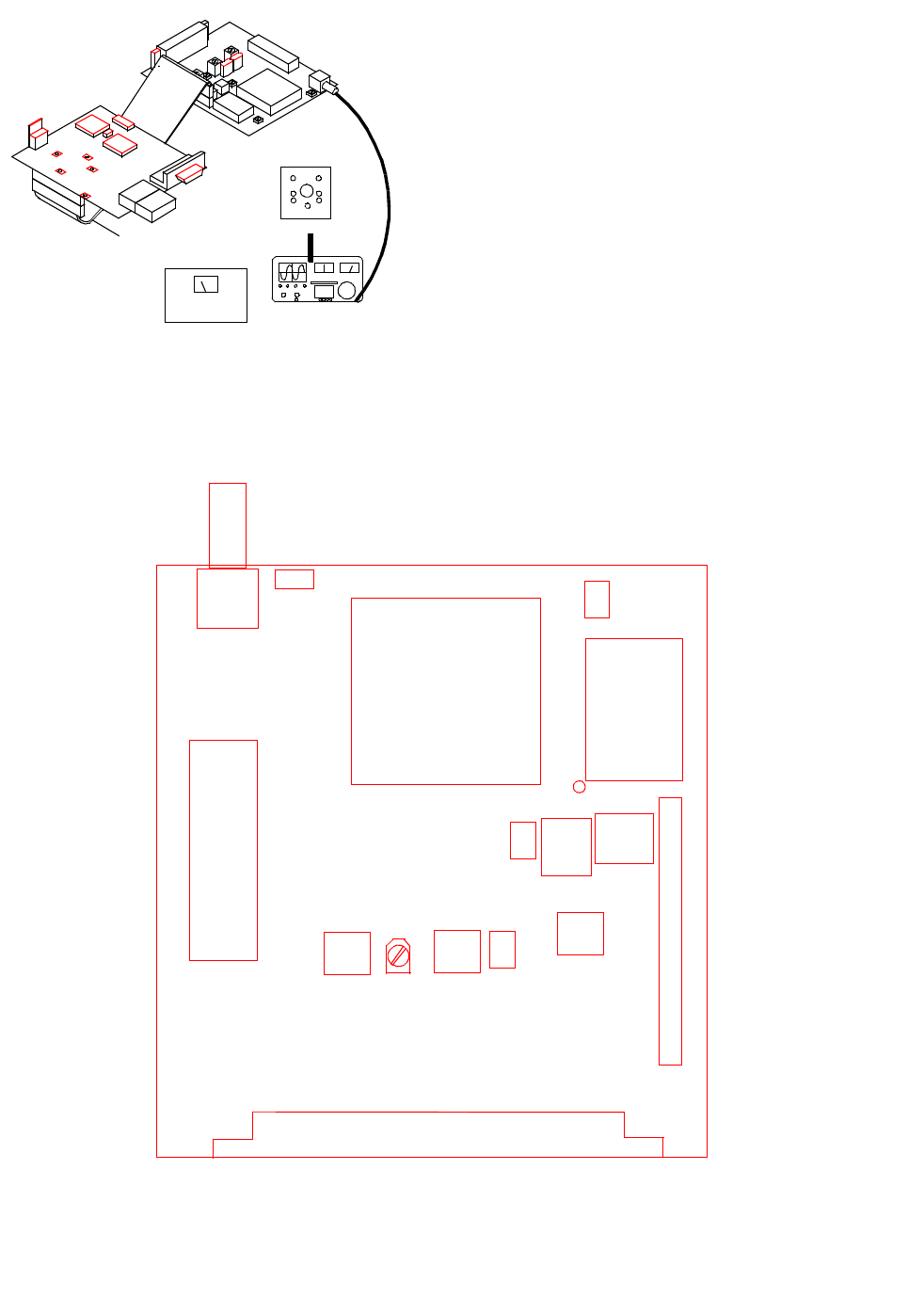
ALIGNMENT PROCEDURE
6-5
June 1997
Part No. 001-3492-001
Figure 6-4 Rx WITH LOADER TEST SETUP
POWER SUPPLY
+7.5V DC
+-COMMUNICATIONS
SERVICE MONITOR
OSCILLOSCOPE
TEST
CABLE
J201 J102
J104
Figure 6-5 ALIGNMENT POINTS DIAGRAM
R540
J501
A840
TP800
Y800
R818
R814
R525
Z231 Z230
L230
J20114 1
L212 L222
C223
U510

7-1
June 1997
Part No. 001-3492-001
SECTION 7 PARTS LIST
SYMBOL PART
NUMBER DESCRIPTION NUMBER
3492 TRANSCEIVER
PART NO. 242-3492-510 (12.5 kHz)
PART NO. 242-3492-530 ( 25 kHz )
A 840 VCO 928-960 MHz 023-3492-540
C 100 22 pF ±5% NPO 0603 510-3674-220
C 101 1 µF 16V SMD tantalum 510-2625-109
C 110 1 µF 16V SMD tantalum 510-2625-109
C 111 22 pF ±5% NPO 0603 510-3674-220
C 112 1 µF 16V SMD tantalum 510-2625-109
C 113 22 pF ±5% NPO 0603 510-3674-220
C 114 22 pF ±5% NPO 0603 510-3674-220
C 115 .01 µF ±10% X7R 0603 510-3675-103
C 116 .01 µF ±10% X7R 0603 510-3675-103
C 117 .01 µF ±10% X7R 0603 510-3675-103
C 118 .01 µF ±10% X7R 0603 510-3675-103
C 119 1 µF 16V SMD tantalum 510-2625-109
C 120 1 µF 16V SMD tantalum 510-2625-109
C 122 22 pF ±5% NPO 0603 510-3674-220
C 123 22 pF ±5% NPO 0603 510-3674-220
C 130 22 pF ±5% NPO 0603 510-3674-220
C 131 22 pF ±5% NPO 0603 510-3674-220
C 132 1 µF 16V SMD tantalum 510-2625-109
C 133 .01 µF ±10% X7R 0603 510-3675-103
C 134 1 µF 16V SMD tantalum 510-2625-109
C 135 22 pF ±5% NPO 0603 510-3674-220
C 136 22 pF ±5% NPO 0603 510-3674-220
C 137 .01 µF ±10% X7R 0603 510-3675-103
C 138 22 pF ±5% NPO 0603 510-3674-220
C 139 .1 µF ±5% X7R 1206 510-3609-104
C 140 .01 µF ±10% X7R 0603 510-3675-103
C 141 .0082 ±10% X7R 0805 510-3605-882
C 142 22 pF ±5% NPO 0603 510-3674-220
C 143 .01 µF ±10% X7R 0603 510-3675-103
C 144 22 pF ±5% NPO 0603 510-3674-220
C 145 1 µF 16V SMD tantalum 510-2625-109
C 146 22 pF ±5% NPO 0603 510-3674-220
C 170 22 pF ±5% NPO 0603 510-3674-220
C 171 22 pF ±5% NPO 0603 510-3674-220
C 172 22 pF ±5% NPO 0603 510-3674-220
C 173 22 pF ±5% NPO 0603 510-3674-220
C 174 22 pF ±5% NPO 0603 510-3674-220
C 175 22 pF ±5% NPO 0603 510-3674-220
SYMBOL PART
NUMBER DESCRIPTION NUMBER
C 176 22 pF ±5% NPO 0603 510-3674-220
C 177 22 pF ±5% NPO 0603 510-3674-220
C 178 22 pF ±5% NPO 0603 510-3674-220
C 179 22 pF ±5% NPO 0603 510-3674-220
C 180 22 pF ±5% NPO 0603 510-3674-220
C 181 22 pF ±5% NPO 0603 510-3674-220
C 182 22 pF ±5% NPO 0603 510-3674-220
C 200 22 pF ±5% NPO 0603 510-3674-220
C 201 22 pF ±5% NPO 0603 510-3674-220
C 202 .01 µF ±10% X7R 0603 510-3675-103
C 203 3.3 pF ±0.1pF NPO 0603 510-3673-339
C 204 .01 µF ±10% X7R 0603 510-3675-103
C 206 2.2 pF ±0.1pF NPO 0603 510-3673-229
C 207 22 pF ±5% NPO 0603 510-3674-220
C 210 .01 µF ±10% X7R 0603 510-3675-103
C 211 22 pF ±5% NPO 0603 510-3674-220
C 213 2.2 pF ±0.1pF NPO 0603 510-3673-229
C 214 9.1 pF ±0.1pF NPO 0603 510-3673-919
C 217 .01 µF ±10% X7R 0603 510-3675-103
C 218 22 pF ±5% NPO 0603 510-3674-220
C 219 22 pF ±5% NPO 0603 510-3674-220
C 220 .01 µF ±10% X7R 0603 510-3675-103
C 223 1.5-5 pF SMD ceramic 512-1602-001
C 224 2.4 pF ±0.1pF NPO 0603 510-3673-249
C 225 .01 µF ±10% X7R 0603 510-3675-103
C 226 6.2 pF ±0.1pF NPO 0603 510-3673-629
C 227 10 pF ±0.1pF NPO 0603 510-3673-100
C 228 .01 µF ±10% X7R 0603 510-3675-103
C 230 .01 µF ±10% X7R 0603 510-3675-103
C 231 .01 µF ±10% X7R 0603 510-3675-103
C 232 .01 µF ±10% X7R 0603 510-3675-103
C 233 .01 µF ±10% X7R 0603 510-3675-103
C 234 .01 µF ±10% X7R 0603 510-3675-103
C 235 10 pF ±0.1pF NPO 0603 510-3673-100
C 236 .01 µF ±10% X7R 0603 510-3675-103
C 237 .01 µF ±10% X7R 0603 510-3675-103
C 240 47 µF 10V SMD tantalum 510-2624-470
C 241 .01 µF ±10% X7R 0603 510-3675-103
C 242 22 pF ±5% NPO 0603 510-3674-220
C 243 18 pF ±5% NPO 0603 510-3674-180
C 244 .001 µF ±10% X7R 0603 510-3675-102
C 245 15 pF ±5% NPO 0603 510-3674-150
C 246 .01 µF ±10% X7R 0603 510-3675-103
C 248 .001 µF ±10% X7R 0603 510-3675-102

PARTS LIST
7-2
June 1997
Part No. 001-3492-001
SYMBOL PART
NUMBER DESCRIPTION NUMBER
C 249 .1 µF ±5% X7R 1206 510-3609-104
C 250 .01 µF ±10% X7R 0603 510-3675-103
C 251 .01 µF ±10% X7R 0603 510-3675-103
C 252 1 µF 16V SMD tantalum 510-2625-109
C 253 .01 µF ±10% X7R 0603 510-3675-103
C 261 22 pF ±5% NPO 0603 510-3674-220
C 262 22 pF ±5% NPO 0603 510-3674-220
C 263 22 pF ±5% NPO 0603 510-3674-220
C 264 .01 µF ±10% X7R 0603 510-3675-103
C 265 5.6 pF ±0.1pF NPO 0603 510-3673-569
C 266 22 pF ±5% NPO 0603 510-3674-220
C 267 22 pF ±5% NPO 0603 510-3674-220
C 268 22 pF ±5% NPO 0603 510-3674-220
C 269 .01 µF ±10% X7R 0603 510-3675-103
C 270 1.8 pF ±0.1pF NPO 0603 510-3673-189
C 500 22 pF ±5% NPO 0603 510-3674-220
C 501 .01 µF ±10% X7R 0603 510-3675-103
C 502 68 pF ±5% NPO 0603 510-3674-680
C 503 10 pF ±0.1pF NPO 0603 510-3673-100
C 504 22 pF ±5% NPO 0603 510-3674-220
C 505 22 pF ±5% NPO 0603 510-3674-220
C 506 22 pF ±5% NPO 0603 510-3674-220
C 510 22 pF ±5% NPO 0603 510-3674-220
C 511 22 pF ±5% NPO 0603 510-3674-220
C 512 22 pF ±5% NPO 0603 510-3674-220
C 513 22 pF ±5% NPO 0603 510-3674-220
C 514 1 µF 16V SMD tantalum 510-2625-109
C 515 22 pF ±5% NPO 0603 510-3674-220
C 516 1 µF 16V SMD tantalum 510-2625-109
C 517 1 µF 16V SMD tantalum 510-2625-109
C 518 22 pF ±5% NPO 0603 510-3674-220
C 520 .01 µF ±10% X7R 0603 510-3675-103
C 521 22 pF ±5% NPO 0603 510-3674-220
C 522 22 pF ±5% NPO 0603 510-3674-220
C 523 .01 µF ±10% X7R 0603 510-3675-103
C 524 22 pF ±5% NPO 0603 510-3674-220
C 526 .01 µF ±10% X7R 0603 510-3675-103
C 527 22 pF ±5% NPO 0603 510-3674-220
C 528 22 pF ±5% NPO 0603 510-3674-220
C 529 22 pF ±5% NPO 0603 510-3674-220
C 530 .01 µF ±10% X7R 0603 510-3675-103
C 531 10 pF ±0.1pF NPO 0603 510-3673-100
C 533 .01 µF ±10% X7R 0603 510-3675-103
C 534 10 pF ±0.1pF NPO 0603 510-3673-100
C 540 22 pF ±5% NPO 0603 510-3674-220
C 541 6.2 pF ±5% NPO 0805 510-3601-629
C 542 4.3 pF ±5% NPO 0805 510-3601-439
SYMBOL PART
NUMBER DESCRIPTION NUMBER
C 543 3.9 pF ±5% NPO 0805 510-3601-399
C 544 3.3 pF ±5% NPO 0805 510-3601-339
C 545 2.7 pF ±5% NPO 0805 510-3601-279
C 546 22 pF ±5% NPO 0603 510-3674-220
C 547 22 pF ±5% NPO 0603 510-3674-220
C 548 68 pF ±5% NPO 0603 510-3674-680
C 549 .01 µF ±10% X7R 0603 510-3675-103
C 550 10 pF ±0.1pF NPO 0603 510-3673-100
C 551 2.4 pF ±5% NPO 0805 510-3601-249
C 552 10 pF ±0.1pF NPO 0603 510-3673-100
C 800 .01 µF ±10% X7R 0603 510-3675-103
C 801 22 pF ±5% NPO 0603 510-3674-220
C 802 .01 µF ±10% X7R 0603 510-3675-103
C 803 22 pF ±5% NPO 0603 510-3674-220
C 804 .01 µF ±10% X7R 0603 510-3675-103
C 805 .01 µF ±10% X7R 0603 510-3675-103
C 806 .01 µF ±10% X7R 0603 510-3675-103
C 807 22 pF ±5% NPO 0603 510-3674-220
C 808 1.5 pF ±5% NPO 0603 510-3674-159
C 809 2.7 pF ±0.1pF NPO 0603 510-3673-279
C 810 22 pF ±5% NPO 0603 510-3674-220
C 811 22 pF ±5% NPO 0603 510-3674-220
C 812 22 pF ±5% NPO 0603 510-3674-220
C 813 22 pF ±5% NPO 0603 510-3674-220
C 814 22 pF ±5% NPO 0603 510-3674-220
C 815 1 µF 16V SMD tantalum 510-2625-109
C 816 22 pF ±5% NPO 0603 510-3674-220
C 817 100 pF ±5% NPO 0603 510-3674-101
C 818 .039 µF ±5% X7R 1206 510-3609-393
C 819 .0039 µF ±10% X7R 0805 510-3605-392
C 820 .0039 µF ±10% X7R 0805 510-3605-392
C 821 1 µF 16V SMD tantalum 510-2625-109
C 822 22 pF ±5% NPO 0603 510-3674-220
C 823 10 pF ±0.1pF NPO 0603 510-3673-100
C 840 .01 µF ±10% X7R 0603 510-3675-103
C 841 22 pF ±5% NPO 0603 510-3674-220
C 842 4.7 µF 10V SMD tantalum 510-2624-479
C 843 .01 µF ±10% X7R 0603 510-3675-103
C 844 .01 µF ±10% X7R 0603 510-3675-103
C 845 .01 µF ±10% X7R 0603 510-3675-103
C 846 .01 µF ±10% X7R 0603 510-3675-103
C 847 .01 µF ±10% X7R 0603 510-3675-103
C 850 22 pF ±5% NPO 0603 510-3674-220
C 851 22 pF ±5% NPO 0603 510-3674-220
C 852 22 pF ±5% NPO 0603 510-3674-220
C 853 22 pF ±5% NPO 0603 510-3674-220
C 854 .01 µF ±10% X7R 0603 510-3675-103
C 855 .01 µF ±10% X7R 0603 510-3675-103

PARTS LIST
7-3
June 1997
Part No. 001-3492-001
SYMBOL PART
NUMBER DESCRIPTION NUMBER
C 856 .01 µF ±10% X7R 0603 510-3675-103
C 900 .01 µF ±10% X7R 0603 510-3675-103
C 901 .01 µF ±10% X7R 0603 510-3675-103
C 902 .01 µF ±10% X7R 0603 510-3675-103
C 903 .01 µF ±10% X7R 0603 510-3675-103
CR200 Switching diode SOT-23 523-1504-002
CR240 Varactor BB535 SOD-323 523-5005-022
CR530 Hot carrier SOT-23 523-1504-016
CR531 Hot carrier SOT-23 523-1504-016
CR540 PIN switch diode SOT-23 523-1504-001
CR541 PIN switch diode SOT-23 523-1504-001
CR840 Varactor BB535 SOD-323 523-5005-022
EP130 Ferrite bead SMD 517-2503-001
EP200 Mini cer crystal pin insulator 010-0345-280
EP510 Ferrite bead SMD 517-2503-001
EP511 Ferrite bead SMD 517-2503-001
EP512 Ferrite bead SMD123 517-2503-010
EP513 Ferrite bead SMD 517-2503-001
HW102 Grafoil MHW 806 (25 kHz) 018-1007-104
HW104 900 MHz module shield 017-2225-754
HW104 4-40 machine panhead ZPS 575-1604-010
J 201 14-pin single row header 515-7110-214
J 501 Jack right angle PC mount 142-0701-501
L 200 2.2 nH ±10% 0805 SMD 542-9003-226
L 201 8.2 nH inductor LL2012 542-9003-826
L 210 22 nH ±10% SMD 542-9003-227
L 211 15 nH inductor LL21012 542-9003-157
L 212 270 nH variable SMT 542-5103-157
L 221 0.39 µH inductor SMD 542-9001-398
L 222 270 nH variable SMT 542-5103-157
L 230 680 µH quad coil 542-5102-001
L 240 120 nH 50 x 80 chip 542-9007-121
L 260 10 nH ±10% 0805 SMD 542-9003-107
L 261 2.7 nH ±10% 0805 SMD 542-9003-276
L 262 10 nH ±10% 0805 SMD 542-9003-107
L 500 1 µH inductor SMD 542-9001-109
L 540 8 nH air core inductor SMD 542-0030-003
L 541 12.5 nH air core inductor SMD 542-0030-004
L 542 8 nH air core inductor SMD 542-0030-003
L 543 1 µH inductor SMD 542-9001-109
L 544 2T 24 AWG 0.08 ID 542-0030-002
SYMBOL PART
NUMBER DESCRIPTION NUMBER
MP101 Heat sink 014-0778-047
MP102 Grafoil MHW 806 018-1007-104
MP102 900 MHz shield (25 kHz) 017-2225-754
MP107 Low pass 017-2225-771
MP108 Synthisizer bottom shield 017-2225-772
MP801 VCO can 017-2225-751
MP806 Crystal filter shield 017-2225-699
Q 100 NPN digital 47k/47 transistor 576-0013-046
Q 101 PNP digital 10k/47 transistor 576-0013-032
Q 110 NPN digital 47k/47 transistor 576-0013-046
Q 130 NPN digital 47k/47 transistor 576-0013-046
Q 131 NPN digital 47k/47 transistor 576-0013-046
Q 132 PNP digital 10k/47 transistor 576-0013-032
Q 133 NPN digital 47k/47 transistor 576-0013-046
Q 134 PNP digital 10k/47 transistor 576-0013-032
Q 135 NPN high current SOT-223 576-0006-027
Q 200 PNP gen purp SC70 MSB1218 576-0013-700
Q 201 NPN low noise SOT-23 576-0003-636
Q 211 Dual gate GaAS 576-0006-405
Q 240 VHF/UHF amp SOT-23 576-0003-634
Q 260 NPN low noise SOT-23 576-0003-636
Q 261 PNP gen purp SC70 MSB1218 576-0013-700
Q 500 Bipolar MMIC SOT-143 576-0003-640
Q 520 NPN high current SOT-223 576-0006-027
Q 800 NPN gen purp SC70 MSD1819 576-0013-701
Q 840 NPN digital 47k/47 transistor 576-0013-046
Q 841 NPN digital 47k/47 transistor 576-0013-046
Q 842 NPN digital 47k/47 transistor 576-0013-046
Q 843 NPN digital 47k/47 transistor 576-0013-046
Q 844 NPN digital 47k/47 transistor 576-0013-046
Q 845 NPN gen purp SC70 MSD1819 576-0013-701
Q 911 NPN Si SOT-23 576-0003-658
R 110 100k ohm ±5% 0.063W 0603 569-0155-104
R 111 51k ohm ±5% 0.063W 0603 569-0155-513
R 112 15k ohm ±5% 0.063W 0603 569-0155-153
R 113 100k ohm ±5% 0.063W 0603 569-0155-104
R 114 15k ohm ±5% 0.063W 0603 569-0155-153
R 130 100k ohm ±5% 0.063W 0603 569-0155-104
R 131 1k ohm ±5% 0.063W 0603 569-0155-102
R 132 22k ohm ±5% 0.063W 0603 569-0155-223
R 133 43k ohm ±5% 0.063W 0603 569-0155-433
R 134 10k ohm ±5% 0.063W 0603 569-0155-103
R 135 10k ohm ±5% 0.063W 0603 569-0155-103
R 136 150k ohm ±5% 0.063W 0603 569-0155-154
R 137 150k ohm ±5% 0.063W 0603 569-0155-154
R 138 10k ohm ±5% 0.063W 0603 569-0155-103

PARTS LIST
7-4
June 1997
Part No. 001-3492-001
SYMBOL PART
NUMBER DESCRIPTION NUMBER
R 139 470 ohm ±5% 0.063W 0603 569-0155-471
R 140 3.6k ohm ±5% 0.063W 0603 569-0155-362
R 141 5.6k ohm ±5% 0.063W 0603 569-0155-562
R 148 10k ohm ±5% 0.063W 0603 569-0155-103
R 200 12k ohm ±5% 0.063W 0603 569-0155-123
R 201 39k ohm ±5% 0.063W 0603 569-0155-393
R 202 300 ohm ±5% 0.063W 0603 569-0155-301
R 203 39k ohm ±5% 0.063W 0603 569-0155-393
R 205 2.2k ohm ±5% 0.063W 0603 569-0155-222
R 212 10 ohm ±5% 0.063W 0603 569-0155-100
R 213 1k ohm ±5% 0.063W 0603 569-0155-102
R 214 10k ohm ±5% 0.063W 0603 569-0155-103
R 215 160 ohm ±5% 0.063W 0603 569-0155-161
R 223 1.5k ohm ±5% 0.063W 0603 569-0155-152
R 230 3.3k ohm ±5% 0.063W 0603 569-0155-332
R 231 2.4k ohm ±5% 0.063W 0603 569-0155-242
R 232 39k ohm ±5% 0.063W 0603 569-0155-393
R 233 33k ohm ±5% 0.063W 0603 569-0155-333
R 234 7.5k ohm ±5% 0.063W 0603 569-0155-752
(12.5 kHz BW)
18k ohm ±5% 0.063W 0603 569-0155-183
(25 kHz BW)
R 240 100 ohm ±5% 0.063W 0603 569-0155-101
R 241 75k ohm ±5% 0.063W 0603 569-0155-753
(12.5 kHz BW Only)
R 242 68k ohm ±5% 0.063W 0603 569-0155-683
R 243 22k ohm ±5% 0.063W 0603 569-0155-223
R 244 10 ohm ±5% 0.063W 0603 569-0155-100
R 245 1k ohm ±5% 0.063W 0603 569-0155-102
R 246 100k ohm ±5% 0.063W 0603 569-0155-104
R 247 330 ohm ±5% 0.063W 0603 569-0155-331
R 248 330 ohm ±5% 0.063W 0603 569-0155-331
R 249 22k ohm ±5% 0.063W 0603 569-0155-223
R 250 4.7k ohm ±5% 0.063W 0603 569-0155-472
R 260 2.2k ohm ±5% 0.063W 0603 569-0155-222
R 261 390 ohm ±5% 0.063W 0603 569-0155-391
R 262 39k ohm ±5% 0.063W 0603 569-0155-393
R 263 220 ohm ±5% 0.063W 0603 569-0155-221
R 264 12k ohm ±5% 0.063W 0603 569-0155-123
R 265 39k ohm ±5% 0.063W 0603 569-0155-393
R 266 100k ohm ±5% 0.063W 0603 569-0155-104
R 267 8.2k ohm ±5% 0.063W 0603 569-0155-822
R 500 270 ohm ±5% 0.063W 0603 569-0155-271
R 501 18 ohm ±5% 0.063W 0603 569-0155-180
R 502 270 ohm ±5% 0.063W 0603 569-0155-271
R 503 470 ohm ±5% 0.063W 0603 569-0155-471
R 504 470 ohm ±5% 0.063W 0603 569-0155-471
SYMBOL PART
NUMBER DESCRIPTION NUMBER
R 520 470 ohm ±5% 0.063W 0603 569-0155-471
R 521 10k ohm ±5% 0.063W 0603 569-0155-103
R 522 100k ohm ±5% 0.063W 0603 569-0155-104
R 525 100k ohm SMD trimmer 569-0130-104
R 526 10k ohm ±5% 0.063W 0603 569-0155-103
R 527 10k ohm ±5% 0.063W 0603 569-0155-103
R 528 10 ohm ±5% 0.063W 0603 569-0155-100
R 529 10k ohm ±5% 0.063W 0603 569-0155-103
R 531 10 ohm ±5% 0.063W 0603 569-0155-100
R 532 10k ohm ±5% 0.063W 0603 569-0155-103
R 534 1k ohm ±5% 0.063W 0603 569-0155-102
R 535 51 ohm ±5% 0.063W 0603 569-0155-510
R 536 1k ohm ±5% 0.063W 0603 569-0155-102
R 537 51 ohm ±5% 0.063W 0603 569-0155-510
R 540 100 ohm ±5% 0.75W 2010 569-0135-101
R 541 47k ohm ±5% 0.063W 0603 569-0155-473
R 800 4.7k ohm ±5% 0.063W 0603 569-0155-472
R 801 4.7k ohm ±5% 0.063W 0603 569-0155-472
R 802 4.7k ohm ±5% 0.063W 0603 569-0155-472
R 803 6.8k ohm ±5% 0.063W 0603 569-0155-682
R 804 6.8k ohm ±5% 0.063W 0603 569-0155-682
R 805 6.8k ohm ±5% 0.063W 0603 569-0155-682
R 806 20 ohm ±5% 0.063W 0603 569-0155-200
R 808 4.7k ohm ±5% 0.063W 0603 569-0155-472
R 809 10k ohm ±5% 0.063W 0603 569-0155-103
R 810 4.7k ohm ±5% 0.063W 0603 569-0155-472
R 811 51 ohm ±5% 0.063W 0603 569-0155-510
R 812 4.7k ohm ±5% 0.063W 0603 569-0155-472
R 813 16k ohm ±5% 0.063W 0603 569-0155-163
R 814 100k ohm SMD trimmer 569-0130-104
R 815 120k ohm ±5% 0.063W 0603 569-0155-124
R 816 39k ohm ±5% 0.063W 0603 569-0155-393
R 817 10k ohm ±5% 0.063W 0603 569-0155-103
R 818 220k ohm ±5% 0.063W 0603 569-0155-224
R 819 68k ohm ±5% 0.063W 0603 569-0155-683
R 820 10k ohm ±5% 0.063W 0603 569-0155-103
R 821 10 ohm ±5% 0.063W 0603 569-0155-100
R 822 18k ohm ±5% 0.063W 0603 569-0155-183
R 823 10k ohm ±5% 0.063W 0603 569-0155-103
R 840 10k ohm ±5% 0.063W 0603 569-0155-103
R 841 3.9k ohm ±5% 0.063W 0603 569-0155-392
R 842 10k ohm ±5% 0.063W 0603 569-0155-103
R 843 3.9k ohm ±5% 0.063W 0603 569-0155-392
R 844 10k ohm ±5% 0.063W 0603 569-0155-103
R 845 4.7k ohm ±5% 0.063W 0603 569-0155-472
R 846 24 ohm ±5% 0.063W 0603 569-0155-240
R 847 24 ohm ±5% 0.063W 0603 569-0155-240

PARTS LIST
7-5
June 1997
Part No. 001-3492-001
SYMBOL PART
NUMBER DESCRIPTION NUMBER
R 848 24 ohm ±5% 0.063W 0603 569-0155-240
R 849 24 ohm ±5% 0.063W 0603 569-0155-240
R 900 10k ohm ±5% 0.063W 0603 569-0155-103
R 901 10k ohm ±5% 0.063W 0603 569-0155-103
R 911 10k ohm ±5% 0.063W 0603 569-0155-103
R 912 47k ohm ±5% 0.063W 0603 569-0155-473
R 913 47k ohm ±5% 0.063W 0603 569-0155-473
R 914 1k ohm ±5% 0.063W 0603 569-0155-102
U 110 Voltage regulator adjustable 544-2603-093
U 111 Voltage regulator adjustable 544-2603-093
U 130 Quad op amp SO-14 331 544-2020-017
U 230 FM IF SA676DK 544-2002-037
U 510 6W power module 900 MHz 544-4001-049
U 520 Op amp SO-8 MC33172D 544-2019-017
U 800 Fractional-N synthesizer 544-3954-027
U 840 8-stage shift register SOIC 544-3016-094
U 900 Quad 8-bit TLC5620ID 544-2031-014
U 901 8-stage shift register SOIC 544-3016-094
U 902 3 2-chnl analog mux/demux 544-3016-053
Y 800 17.5 MHz TCXO ±1.5 PPM 518-7009-521
Z 200 944 MHz 3-pole ceramic 532-2006-040
Z 201 944 MHz 3-pole ceramic 532-2006-040
Z 220 87.85 MHz 4-pole 8 kHz BW 532-0009-021
(12.5 kHz BW)
Z 220 87.85 MHz 4-pole 15 kHz BW 532-0009-022
(25 kHz BW)
Z 221 87.85 MHz 4-pole 8 kHz BW 532-0009-021
(12.5 kHz BW)
Z 221 87.85 MHz 4-pole 15 kHz BW 532-0009-022
(25 kHz BW)
Z 230 450 kHz 9 kHz BW ceramic 532-2004-015
(12.5 kHz BW)
Z 230 450 kHz 20 kHz BW ceramic 532-2004-013
(25 kHz BW)
Z 231 450 kHz 9 kHz BW ceramic 532-2004-015
(12.5 kHz BW)
Z 231 450 kHz 20 kHz BW ceramic 532-2004-013
(25 kHz BW)
SYMBOL PART
NUMBER DESCRIPTION NUMBER
VCO 928-960 MHz
Part No. 023-3492-540
C 820 22 pF ±5% NPO 0603 510-3674-220
C 821 22 pF ±5% NPO 0603 510-3674-220
C 822 22 pF ±5% NPO 0603 510-3674-220
C 824 1.5 pF ±0.1 pF NPO 0603 510-3673-159
C 825 2 pF ±0.1 pF NPO 0603 510-3673-209
C 826 22 pF ±5% NPO 0603 510-3674-220
C 827 22 pF ±5% NPO 0603 510-3674-220
C 830 22 pF ±5% NPO 0603 510-3674-220
C 831 22 pF ±5% NPO 0603 510-3674-220
C 832 22 pF ±5% NPO 0603 510-3674-220
C 833 6.8 pF ±0.1 pF NPO 0603 510-3673-689
C 834 1 pF ±0.1 pF NPO 0603 510-3673-109
C 835 22 pF ±5% NPO 0603 510-3674-220
C 836 4.3 pF ±0.1 pF NPO 0603 510-3673-439
C 838 1 pF ±0.1 pF NPO 0603 510-3673-109
C 840 .001 µF ±10% X7R 0603 510-3675-102
C 841 22 pF ±5% NPO 0603 510-3674-220
C 842 2.2 pF ±0.1 pF NPO 0603 510-3673-229
C 844 3.9 pF ±0.1 pF NPO 0603 510-3673-399
C 845 3.9 pF ±0.1 pF NPO 0603 510-3673-399
C 846 2.7 pF ±0.1 pF NPO 0603 510-3673-279
C 850 22 pF ±5% NPO 0603 510-3674-220
C 851 4.7 pF ±0.1 pF NPO 0603 510-3673-479
C 852 22 pF ±5% NPO 0603 510-3674-220
C 853 22 pF ±5% NPO 0603 510-3674-220
C 854 22 pF ±5% NPO 0603 510-3674-220
C 860 22 pF ±5% NPO 0603 510-3674-220
C 861 4.3 pF ±0.1 pF NPO 0603 510-3673-439
C 863 2 pF ±0.1 pF NPO 0603 510-3673-200
CR820 PIN switch diode SOT 523-1504-001
CR821 PIN switch diode SOT 523-1504-001
CR822 Varactor SOD-323 BB535 523-5005-022
CR824 Varactor SOD-323 BB535 523-5005-022
L 820 68 nH ±10% SMD 0805 542-9003-687
L 821 68 nH ±10% SMD 0805 542-9003-687
L 822 68 nH ±10% SMD 0805 542-9003-687
L 823 68 nH ±10% SMD 0805 542-9003-687
L 825 68 nH ±10% SMD 0805 542-9003-687
L 826 Resonator 0.5" long SMD 542-9004-011
L 830 68 nH ±10% SMD 0805 542-9003-687
L 831 12 nH inductor LL2012 542-9003-127
L 832 3.3 nH inductor ceramic 542-9003-336
L 833 10 nH inductor LL2012 542-9003-107

PARTS LIST
7-6
June 1997
Part No. 001-3492-001
SYMBOL PART
NUMBER DESCRIPTION NUMBER
Q 820 NPN transistor NE85619 576-0003-651
Q 821 NPN transistor NE85619 576-0003-651
Q 822 NPN transistor NE85619 576-0003-651
Q 823 NPN transistor NE85619 576-0003-651
R 820 10k ohm ±5% 0.063W 0603 569-0155-103
R 821 100 ohm ±5% 0.063W 0603 569-0155-101
R 822 10k ohm ±5% 0.063W 0603 569-0155-103
R 823 10k ohm ±5% 0.063W 0603 569-0155-103
R 824 3.3k ohm ±5% 0.063W 0603 569-0155-332
R 825 10 ohm ±5% 0.063W 0603 569-0155-100
R 826 150 ohm ±5% 0.063W 0603 569-0155-151
R 827 10 ohm ±5% 0.063W 0603 569-0155-100
R 830 4.3k ohm ±5% 0.063W 0603 569-0155-432
R 831 5.6k ohm ±5% 0.063W 0603 569-0155-562
R 832 3k ohm ±5% 0.063W 0603 569-0155-302
R 833 200 ohm ±5% 0.063W 0603 569-0155-201
R 835 200 ohm ±5% 0.063W 0603 569-0155-201
R 836 200 ohm ±5% 0.063W 0603 569-0155-201
R 840 100 ohm ±5% 0.063W 0603 569-0155-101
R 842 27k ohm ±5% 0.063W 0603 569-0155-273
R 843 3.9k ohm ±5% 0.063W 0603 569-0155-392
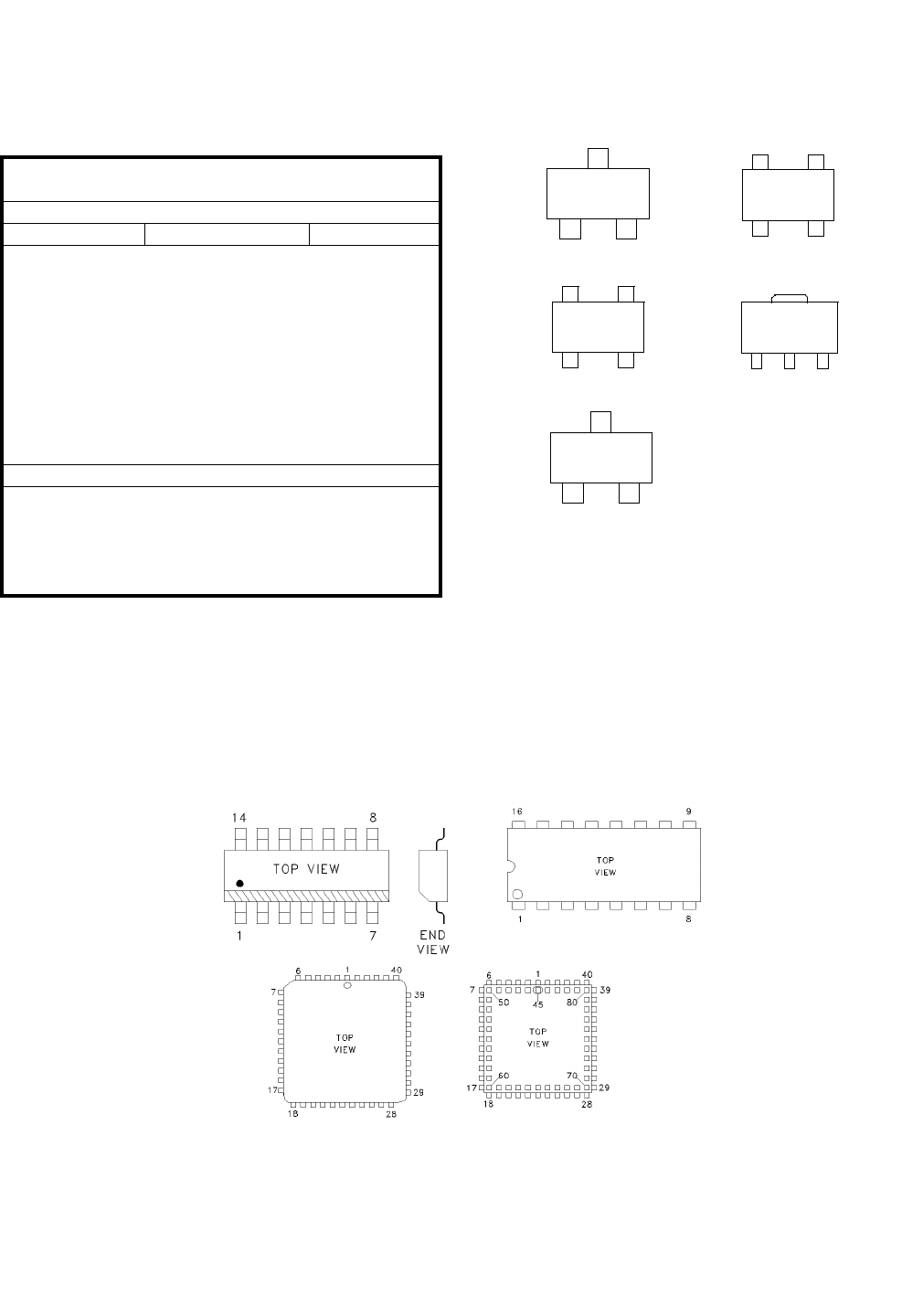
8-1
June 1997
Part No. 001-3492-001
SECTION 8 SCHEMATICS AND COMPONENT LAYOUTS
TRANSISTOR AND DIODE BASING
REFERENCE TABLE
TRANSISTORS
Part Number Basing Diagram Identification
576-0003-636 1
576-0003-640 2
576-0006-027 4P1F
576-0006-405 3U72
576-0013-032 16D
576-0013-046 18C
576-0013-700 1BR
576-0013-701 1ZR
DIODES
523-1504-001 54D
523-1504-002 55A
523-1504-016 55F
523-5005-022 55B
TOP
VIEW
C
BE
1
TOP
VIEW
C
CEB
4
TOP
VIEW
5
ANC
C
TOP
VIEW
INGND
GNDOUT 2
TOP
VIEW
G1G2
SD3
1
2
3 4
INTEGRATED CIRCUITS
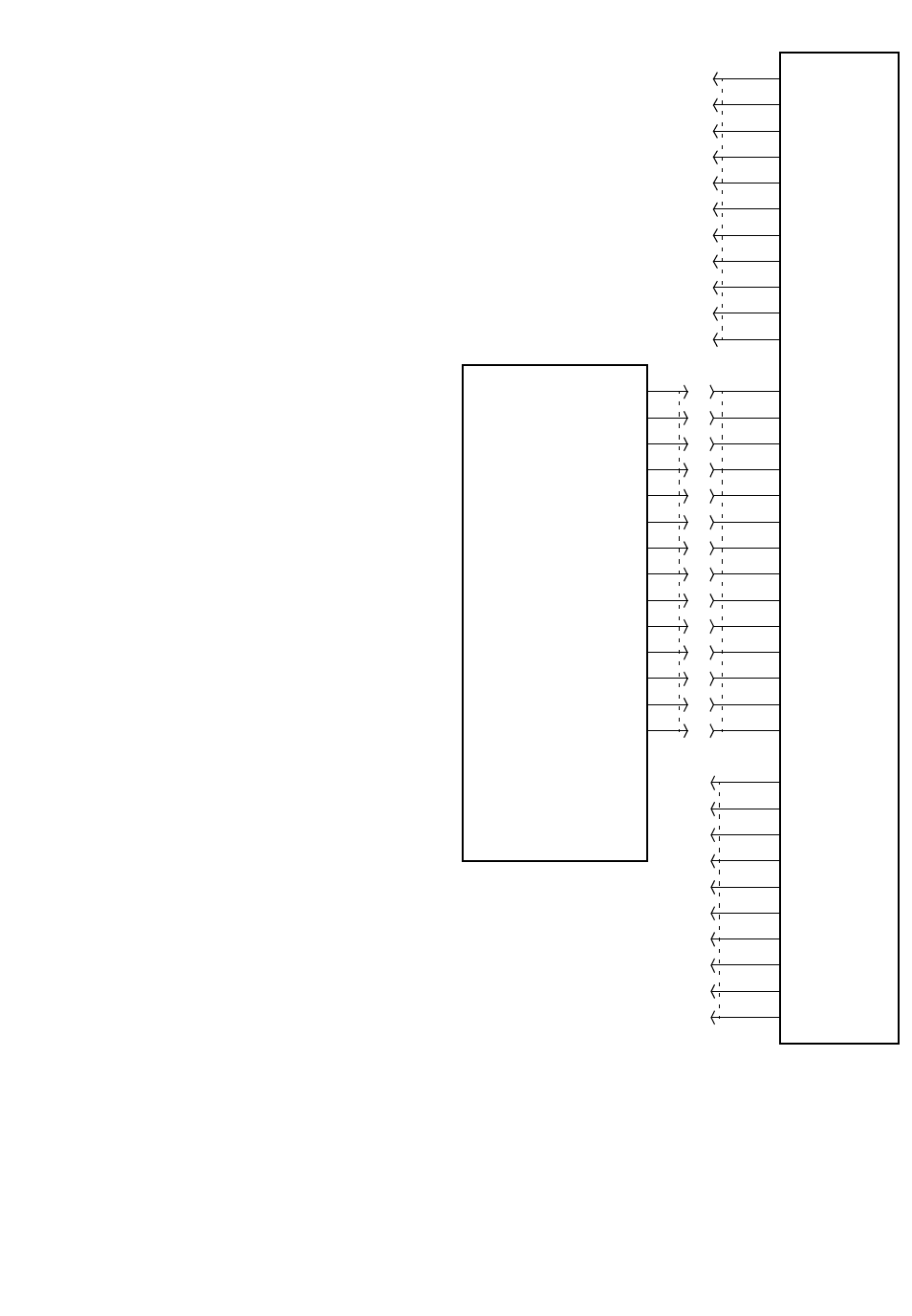
SCHEMATICS AND COMPONENT LAYOUTS
8-2
June 1997
Part No. 001-3492-001
Figure 8-1 LOADER BOARD INTERCONNECT
GROUND
SYNTH LOCK
SYNTH EN
DATA
SYNTH CLOCK
DEMOD
J1
WIDE BAND OUT
RSSI
RX DATA OUT
GROUND
TX DATA IN
CARRIER DETECT
PTT
WIDE BAND IN
12
11
1
2
3
4
5
6
7
8
9
10
13
14
MOD IN
DIAG EN
RSSI
DIAG
FREQ SEL
1
2
3
4
5
6
7
8
9
10
1
2
3
4
5GROUND
RX DATA
TX DATA
SLEEP/WAKE UP
CONNECTOR
PROGRAMMING
USER INTERFACE
LOADER BOARD
RF BOARD
J104
11
6
7
8
9
10 GROUND
GROUND
NC
PRG0
PRG1
PRG2
P101
J102
+13.3V DC
+13.3V
TX EN
RX EN
RF EN
242-3492-5xx
023-3240-001
GROUND
GROUND
SYNTH LOCK
SYNTH EN
DATA
SYNTH CLOCK
DEMOD
MOD IN
DIAG EN
RSSI
DIAG
+13.3V
TX EN
RX EN
RF EN
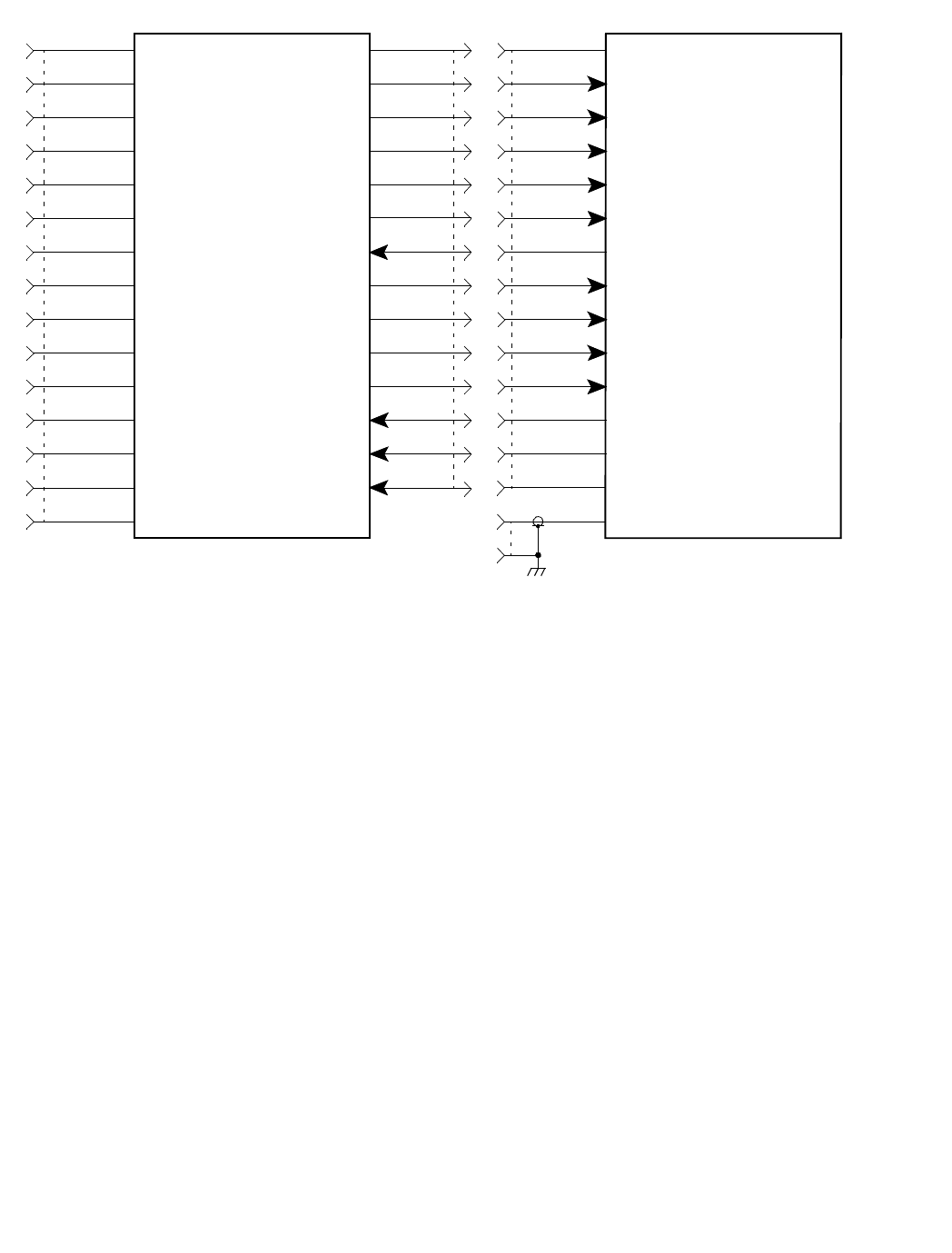
SCHEMATICS AND COMPONENT LAYOUTS
8-3
June 1997
Part No. 001-3492-001
Figure 8-2 MODEM INTERCONNECT
1
2
3
4
5
7
8
9
10
11
12
13
14
ANTENNA
6
TELEMETRY RF BOARD
P1
1
2
3
4
5
7
8
9
10
11
12
13
14
J1
6
3276 MODEM
GROUND
RXD
TXD
TEST AUDIO
B+
GROUND
CTS
RTS
DCD
B+
CS0
CS1
CS2
RSSI
DTR PGM15
GROUND
SYNTH LOCK
SYNTH EN
DATA
SYNTH CLOCK
DEMOD
MOD IN
DIAG EN
RSSI
DIAG
+13.3V
TX EN
RX EN
RF EN
GROUND
SYNTH LOCK
SYNTH EN
DATA
SYNTH CLOCK
DEMOD
MOD IN
DIAG EN
RSSI
DIAG
+13.3V
TX EN
RX EN
RF EN
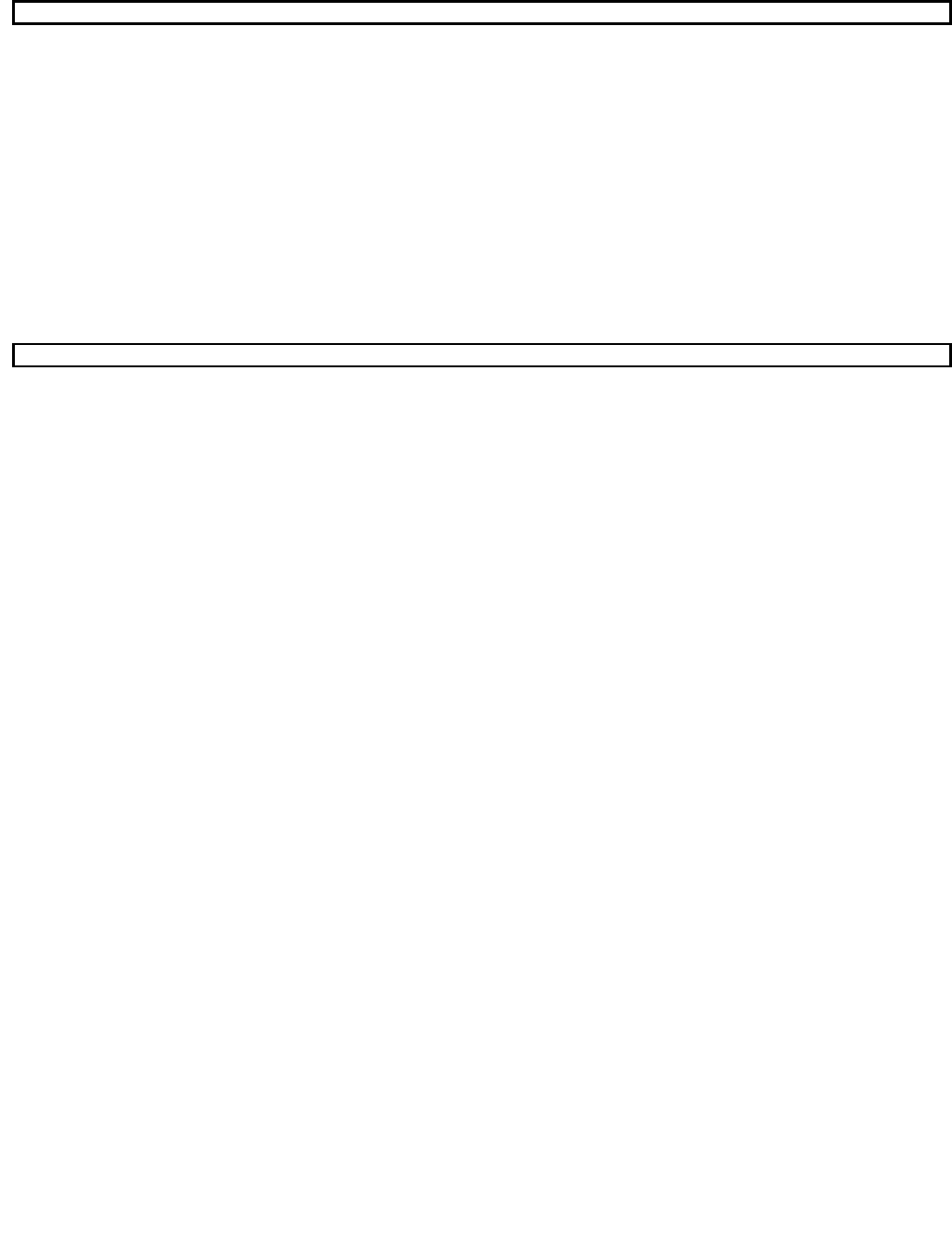
SCHEMATICS AND COMPONENT LAYOUTS
8-4
June 1997
Part No. 001-3492-001
Figure 8-3 TRANSCEIVER COMPONENT LAYOUT (COMPONENT SIDE VIEW)
Figure 8-4 TRANSCEIVER COMPONENT LAYOUT (OPPOSITE COMPONENT SIDE VIEW)

SCHEMATICS AND COMPONENT LAYOUTS
8-5
June 1997
Part No. 001-3492-001
Figure 8-5 SCHEMATIC 1 OF 2

SCHEMATICS AND COMPONENT LAYOUTS
8-6
June 1997
Part No. 001-3492-001
Figure 8-6 SCHEMATIC 2 OF 2
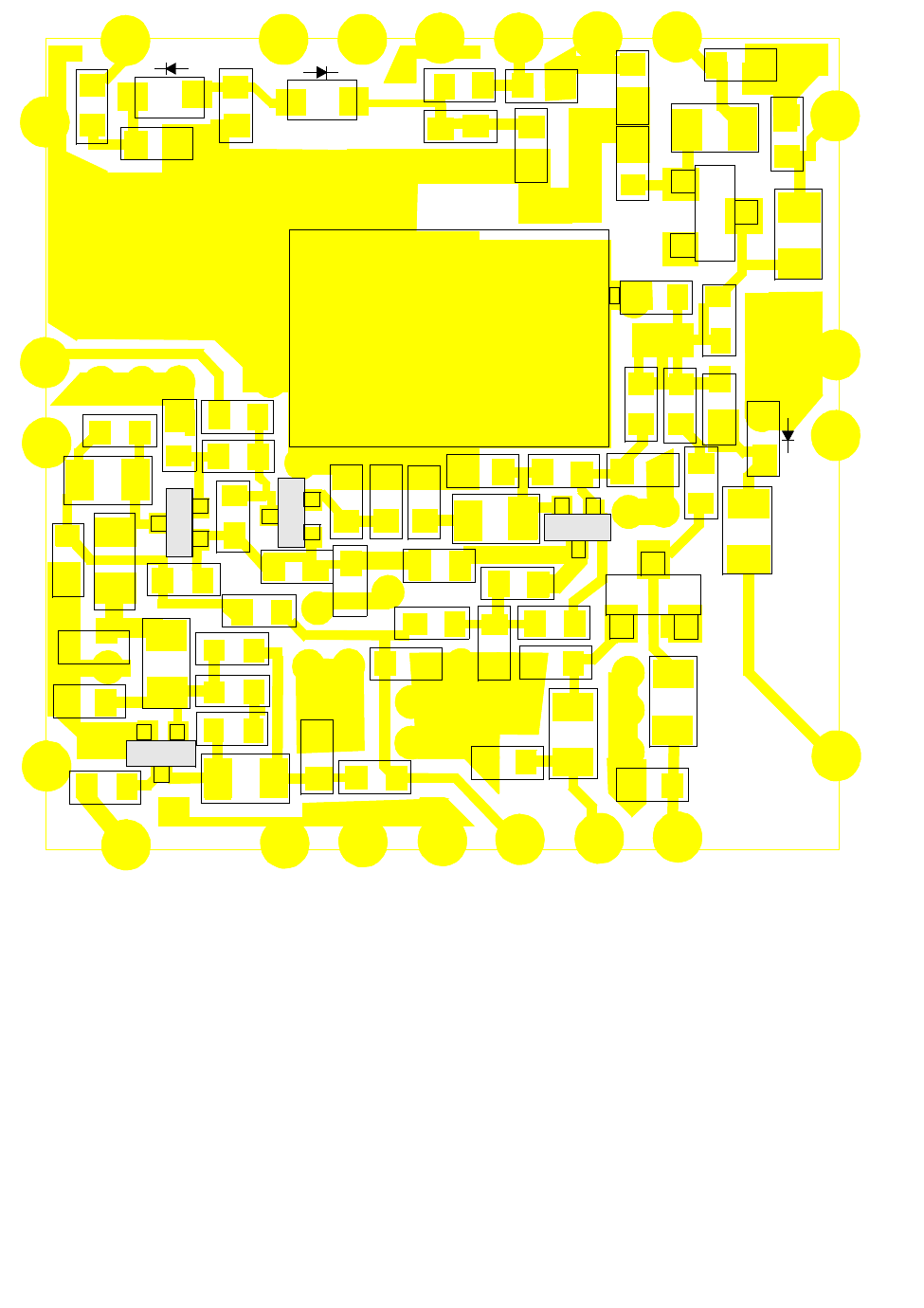
SCHEMATICS AND COMPONENT LAYOUTS
8-7
June 1997
Part No. 001-3492-001
Figure 8-7 VCO COMPONENT LAYOUT
C850
C851
R830
C833
L825
C825
C824
C826
L826
W836
W842
C852
R834
R840
C861
C863
R843
W838
W835 W840 W841 W831
L831
L832
L833
Q823
Q821
Q822
C862
R842
C860
R833
R836
R826
R827
R825
C855
C853
C841
C854
C840
R841
R835
R831
R832
C846
C845 C844
Q820
CR820
L830
L820
R823
C831
C830 C832
W830 W820 W821
W827
L821
CR824
R824
W826
W839
C834
C842
C820
C836
C838
CR821
L822
L823 W822
W823W833
W824
C835
C821
C822 C823
W832
W843
W844
R820
R821
CR822
R822
CR823
C827
W837
W825

SCHEMATICS AND COMPONENT LAYOUTS
8-8
June 1997
Part No. 001-3492-001
This page intentionally left blank.